Posted in Kenya on June 17, 2025
Thursday 12 June 2025
We began pre-packing for our Developing World Connections volunteer trip to Kenya the weekend before, deciding how many bags we would take (three), how many we would check (two), and what would be in our two smaller carry-ons: Becky’s backpack purse and my camera backpack.
Our packing has improved over the years and with the promise of reliable laundry service at the Lusoi Resort in Kenya, we could pack even lighter. We also plan to give away several items during our time in Kenya, as is our custom, including a pair of my shoes, pairs of socks, several DWC T-shirts, and some DWC “buffs” or neck gaiters. We’d also leave behind some of our personal protective equipment like work gloves and then eat or give away any snack foods we packed. We did add some other clothes, though, because of additional vacation and touring time we had planned after Kenya, namely three full days each in Zanzibar, Tanzania and Brussels, Belgium.
Giving away things makes room for the few souvenirs we would buy. The most important thing is always T-shirts for the four grandkids, but we might include some Kenyan or Tanzanian coffee or Belgian chocolates and a shirt or two for each of us.
This is my 11th trip with DWC and 10th as a team leader. We are returning to the Naro Moru region of Kenya where, two years before, we had built a stone-block classroom at a rural elementary school. We’re looking forward to seeing many of the same faces that we met in 2023 as our goal is to complete a similar structure at another school—this time as the first phase of three volunteer trips that will ultimately complete a computer classroom and education center partially financed by Lenovo computers.
Earlier in the week, DWC’s program manager for the project sent me photos of the site showing that the local worked had already poured the foundation of the classroom and were preparing to pour the concrete floor as well. If all that was done, then we would be stepping into the project at about the same point that we had two years ago.
Our volunteer group is 10 strong. Becky is, of course, joining me for her second Kenya Trip and eighth DWC trip overall, as is Mark Kijowski (an American ex-patriot living near Pisa, Italy) with whom I’d worked in Nepal in 1019, Costa Rica in 2022, and Kenya in 2023. Kate Smith, from Arizona, and a fellow graduate of the US Air Force Academy (USAFA) is joining us for her second DWC as she’d gone to Lima, Peru with us last Fall for work on a school in a barrio there. “Yami” Yamakawa is DWC veteran and octogenarian from Kamloops, BC. Hollis Toney is the 20-something son of my first cousin from Massachusetts. Richard “Beef” Haddad is a retired US Air Force Reserve general officer and airline pilot from Florida, accompanied by his wife, Ginger—also former military and a lawyer. Beef and I are USAFA classmates (’81 Second to None!) both raised in Arizona and friends for almost 50 years. Next, we have Dave “DT” Thompson, a retired US Space Force general, former student of mine at USAFA, long-time friend, and fellow resident of Colorado Springs. Our final volunteer is Katja Roberts, a DWC staff member going on her first orientation trip.
The trip is nominally for two weeks of work, but Beef, Ginger, and Katja are only staying for one week before returning home. During the middle weekend of the trip—and before the three mentioned above, depart—we will go to Samburu National Reserve for two-plus days of safari, as we did in 2023.
The team had held two different video call orientations and we’d also formed a WhatsApp group for communications during the trip. Beef and Ginger would be arriving first and have an extra day or two in Nairobi. Becky and I will be arriving on Friday evening, 13 June, just an hour after Yami, and the three of us will join the other two at the Lotos Hotel in Nairobi. The rest of the team will arrive the following day and on Sunday, after breakfast, we will all depart for the Lusoi Resort (our home base) in the Naro Moru region of Kenya about a three-hour drive northwest of Nairobi near the foot of Mount Kenya. That is the plan at least!
I think that our packing went well. We had some extra room in two of our three bags and I had some room in my camera bag. My friend and Canon technical rep, Mike Cutler, arranged to send me some loaner gear for this trip—as he’s done several times in the past—to include a new Canon R5 Mark II camera, a Canon RF100-500mm “L” telephoto zoom and a 2X teleconverter that would give me up to 1000mm (one meter!) of focal length for safari shooting.
On Thursday morning, we woke up early as usual and spent the morning prepping ourselves, our luggage, and our house for a 10am departure. All went without a hitch and we boarded our Lyft taxi to the airport at 10am, confident that we hadn’t forgotten anything, while repeating after ourselves “wallet, cell phone, passport” about a dozen times.
The plane boarded on time—a full United Airlines 737—and we landed early at Chicago O’Hare Airport for a two-plus hour layover before our next United flight from there overnight to Brussels. We landed at gate C17 and were pleased to know that our Brussels flight would depart from C10, just next door to the United Star Alliance lounge.
The lounge was very crowded, but we managed to find two seats near a window overlooking a gate. I had a beer and some snacks and Becky got a salad. We each ate some cookies, checked email and the news while preparing for the overnight flight to Brussels.
The flight, on a Boeing 787, boarded smoothly and left on time for a smooth flight that last about 7.5 hours. We were pleased that it arrived about 15 minutes early because our connection in Brussels was only 85 minutes.
Friday 13 June 2025
We had to take an electric shuttle from our arrival at Terminal B to Terminal T from which all flights to Africa departed. There was a long line to board the bus and we waited almost 15 minutes, finally getting on the crowded shuttle that then needed almost 10 minutes to get to the next terminal.
When we stepped into the new terminal and saw a Star Alliance lounge and Becky asked if we had time to get a drink or use the restrooms there, I checked my watch and saw that our next flight was scheduled to begin boarding in only one minute. We kept walking.
The boarding process for the Brussels Air flight was completely unintelligible. We stood in what looked like a line to check-in only to find that it was for visa assistance. Some groups only had their Kenyan visas on their phones and, apparently, this was not acceptable. I was happy to have a hard copy of ours.
The plane seemed to take forever to load, in part because of the completely manual and confusing document checks–they also didn’t take electronic boarding passes and needed to issue paper passes to all. On top of that, once boarded, the pilot announced that, due to congestion over Switzerland and Austria, and our flight route over those countries, our departure would be delayed an additional 20 minutes. In the end, we began taxiing for takeoff an hour late.
The flight to Nairobi was also almost completely full. The Airbus A330-300 had a 2-4-2 seating arrangement, so Becky and I were on the right side with me on the aisle and her on the window. That was right after having to suffer the ORD-to-BRU flight in the very middle seat of a 3-3-3 Dreamliner.
The flight to Nairobi was actually longer than the overnight to Brussels, clocking in at just over eight hours. We managed to make up some time en route, landing only about 30 minutes late.
We breezed through passport and customs control quickly and our bags arrived on the carousel just a few minutes after we found a cart. Joseph was waiting for us outside of Terminal 1E and we started walking to another terminal to meet James who was waiting for Yami.
We had had no contact at all with Yami–he had not responded to any of my WhatsApp messages, so we weren’t sure if he had even arrived on his scheduled flight. We were quite worried, but he finally came out of the terminal telling us that one of his bags was lost or delayed and not scheduled to arrive into Nairobi until the same flight arrived the next day.
As we were walking to the cars, Yami expressed his relief that he’d made it to Nairobi and when James asked him if he needed anything, he said “A Tusker!” So, James walked into a shot next to us and bought Yami a can of Tusker Lager that clearly hit the spot.
The drive to the hotel took about 20 minutes in the dark and was uneventful. Beef Hadad was waiting for us in the lobby. Joseph needed to go back to the airport to pick up Kate who was arriving just after midnight. Beef had informed us by WhatsApp that he had scheduled a day safari and some tours with James to occur on Saturday and Kate and I agreed to go with them. Becky and Yami decided to stay back at the hotel the next day and relax.
Meanwhile, we were hearing from Hollis that he had missed his initial flight from the East Coast and wouldn’t arrive until midday on Sunday due to delays in rebooking caused by the conflict in the Middle East–he was passing through Abu Dhabi on Etihad Airlines.
Becky and I were in bed by about 11:30pm. I took an Ambien, set my alarm for six hours later and committed to meet Ginger, Beef, and Kate for our 6:15am safari departure.
Saturday 14 June 2025
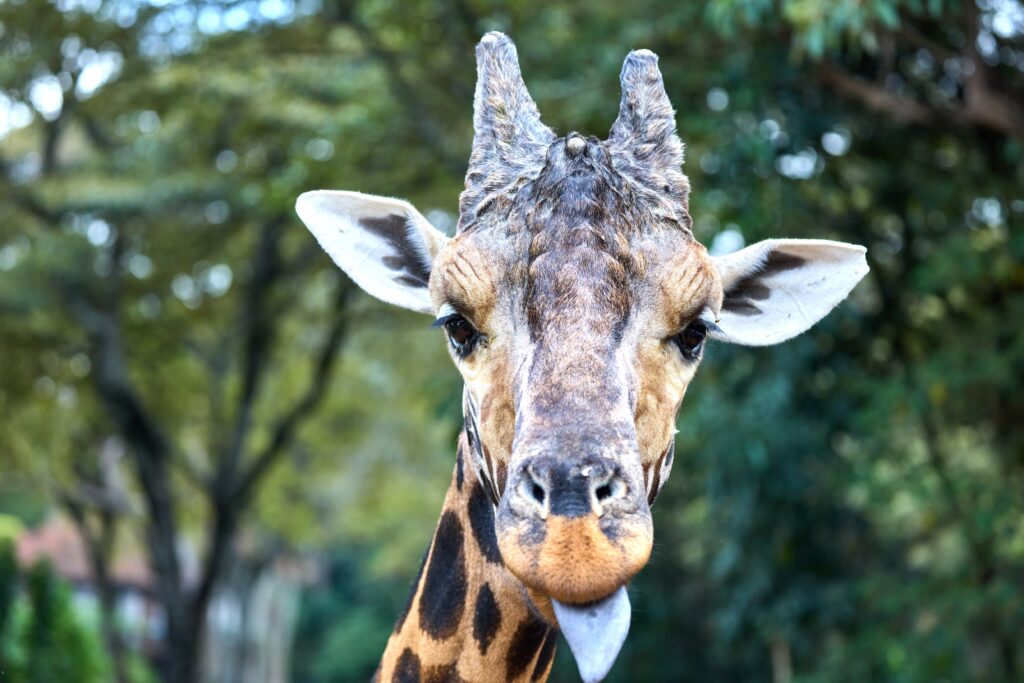
We were able to grab a few items at the hotel’s buffet breakfast before we left on the safari with our driver, Andrew. The coffee was terrible and seemed to be just a pot of instant coffee freshly mixed with hot water.
The drive to the Nairobi National Park entrance was only about 20 minutes and we were in line to enter quickly. There were many safari jeeps and vans waiting and it was clear that we would not be alone on this beautiful, cool, and partly cloudy Saturday morning.
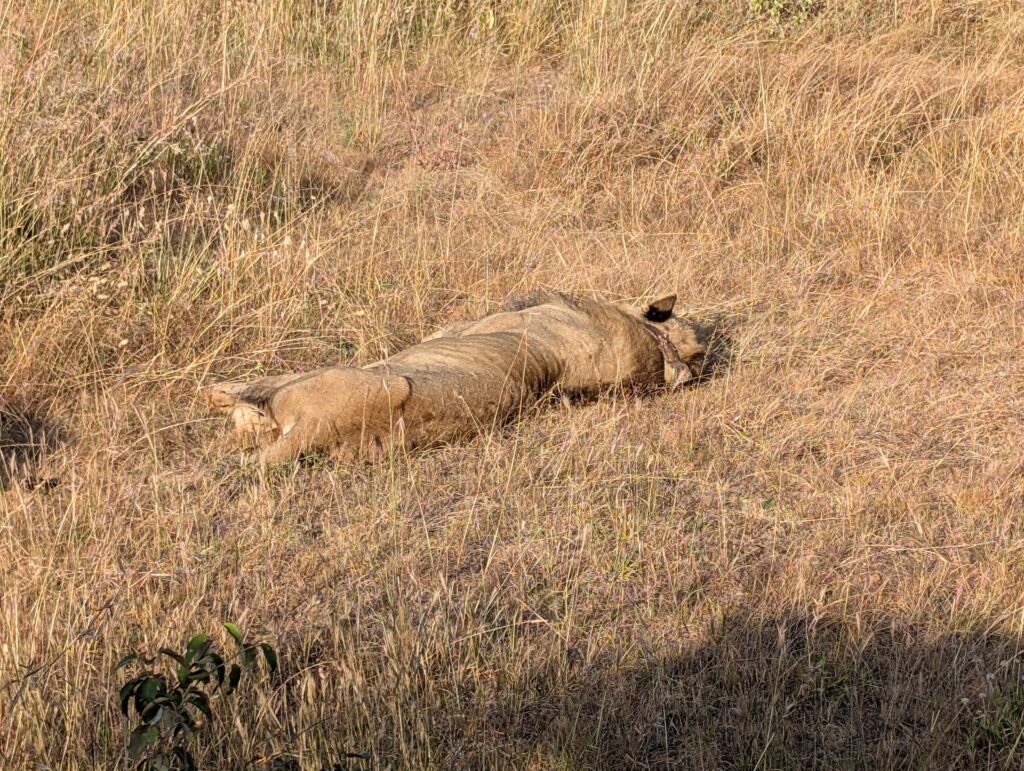
Within about 15 minutes we were driving into the park behind a stream of other vehicles. Over the next three hours we managed to see several lions, including one young male that seemed to be sleeping off a bender from the night before, oblivious to a dozen safari cars circling him no more than 30 feet away. It was hard to tell that he was alive except for the occasional ear twitch and slow breathing. He had a thick leather collar and GPS tracking device around his neck.
Soon after, we saw a family of three black rhinos including a baby that was probably a year old or less. This was one of several rhinoceros’ encounters that were the highlights the visit in addition to the giraffes. There were not many antelope of any sort. We saw two small bands of impala and then, in the distance what looked like a herd of large antelope that were too far away to absolutely identify. I thought they were sable, but could also have been hartebeest or eland according to Andrew. We saw one lone water buffalo, no elephants–there aren’t any in the 166 square kilometer park. One pond held a small family of hippos.
We saw several bands of Masai giraffes that were noticeably smaller than the reticulated giraffes we’d seen two years before in Samburu National Preserve. They were, however, just as graceful and seemed very curious about their safari friends.
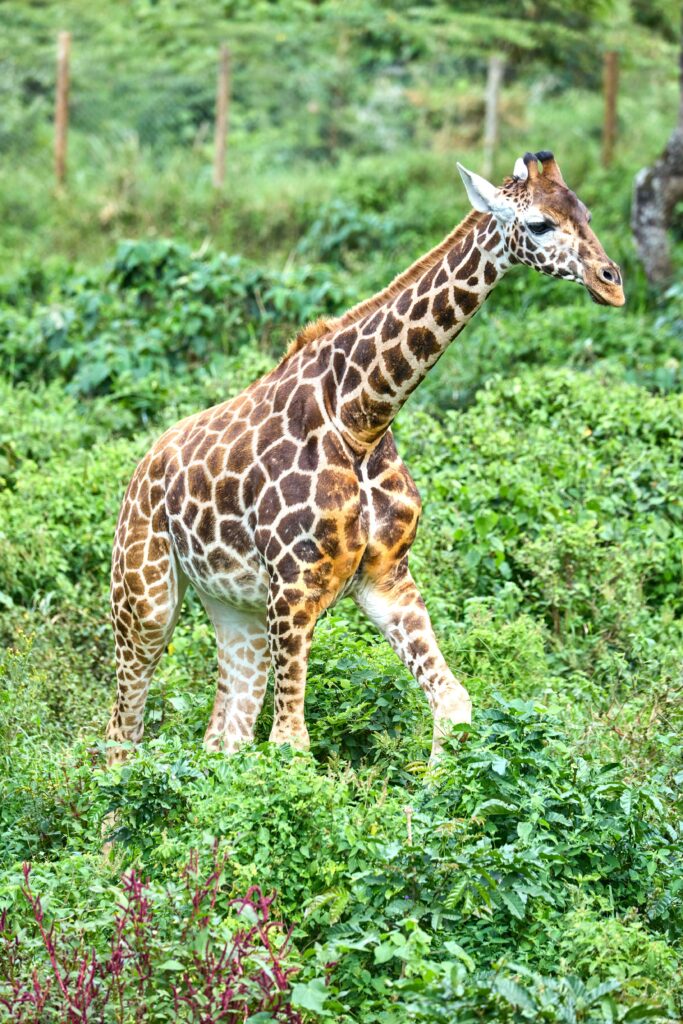
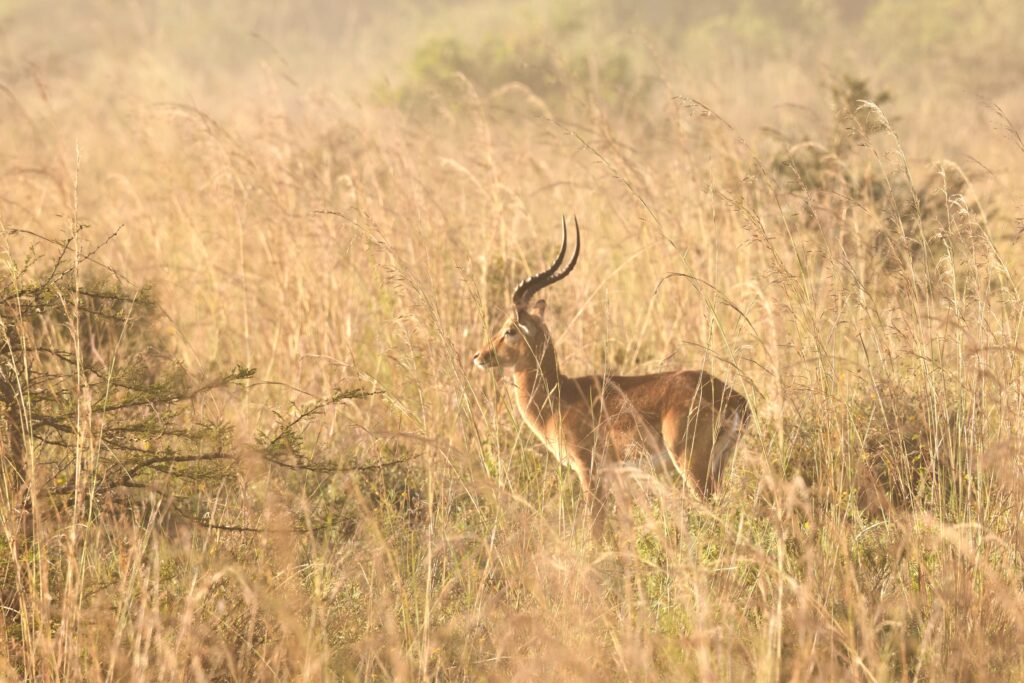
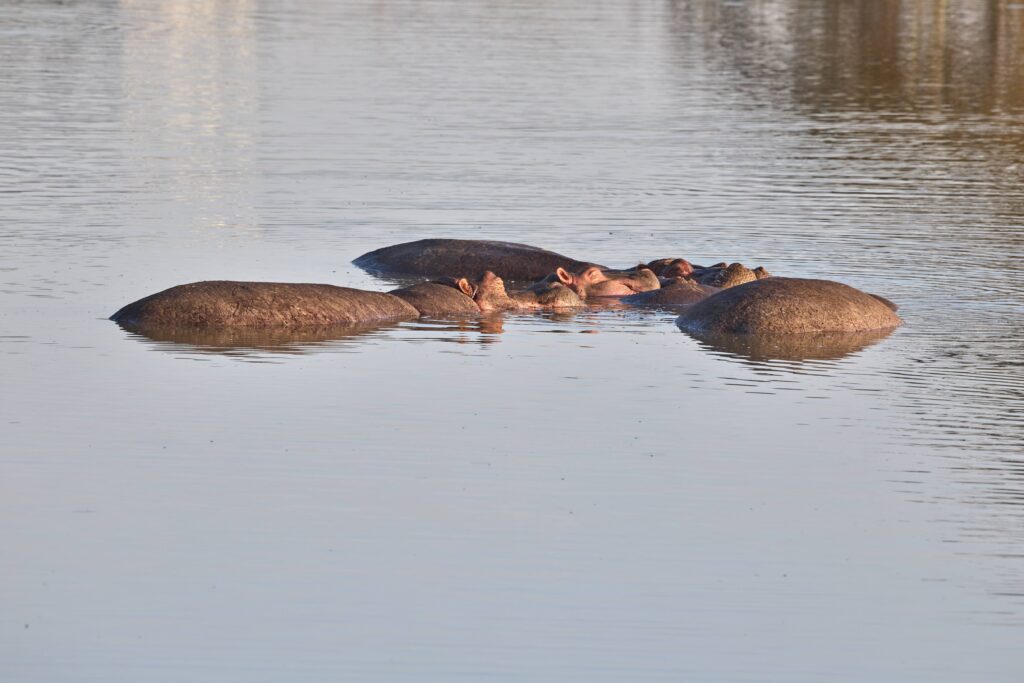
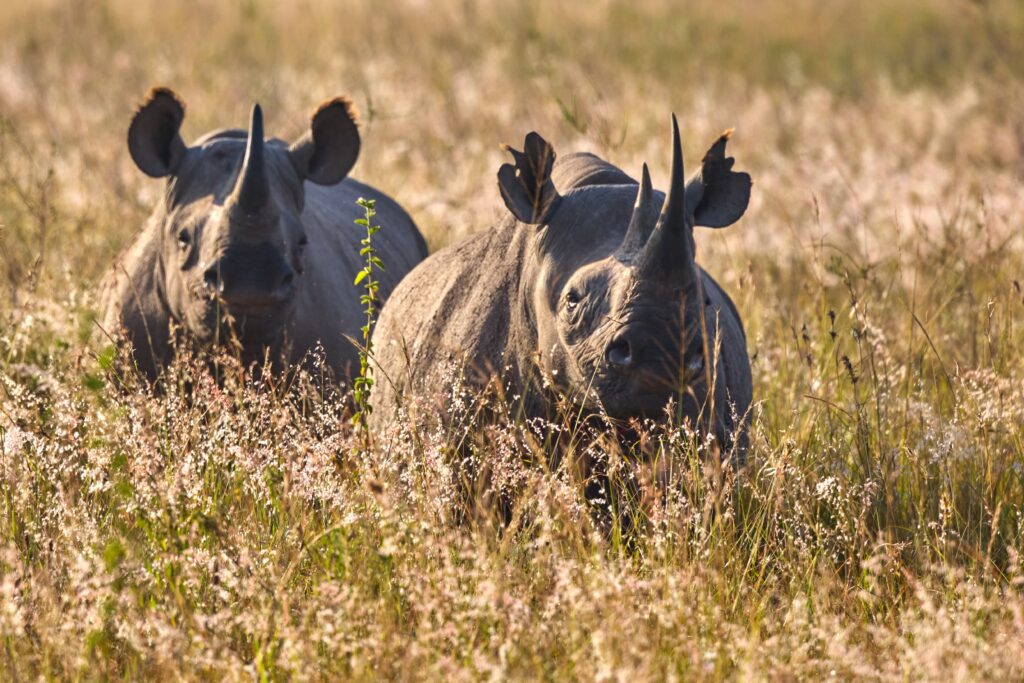
At one point, we saw a group of lions in the deep grass walking away from us but were unable to get any good photos. There was some bird life, but not a lot. We saw a maribou stork, large vulture, and some water birds near the hippos.
The dust was difficult because of the number of vehicles on the trails. We were never out of sight of other safari tourists. We made one pit stop along the way to use the rest rooms in a picnic area that had many olive baboons. One group of irresponsible tourists tossed their picnic trash to the baboons who tore into the paper bags and fought over some aluminum foil coated with scraps of food. I lost it with one of the tourists and told them to go pick up their trash. None of the guides said anything, the guy clearly understood English because he blamed the littering on another group.
I took it upon myself to do the cleanup and walked rather loudly into the area, scattering the baboons, and picked up all of the trash. A group of Asian tourists broke into light applause and one kind young lady brought over some tissues to wrap the trash in and wipe my hands while we looked for a trash receptacle.
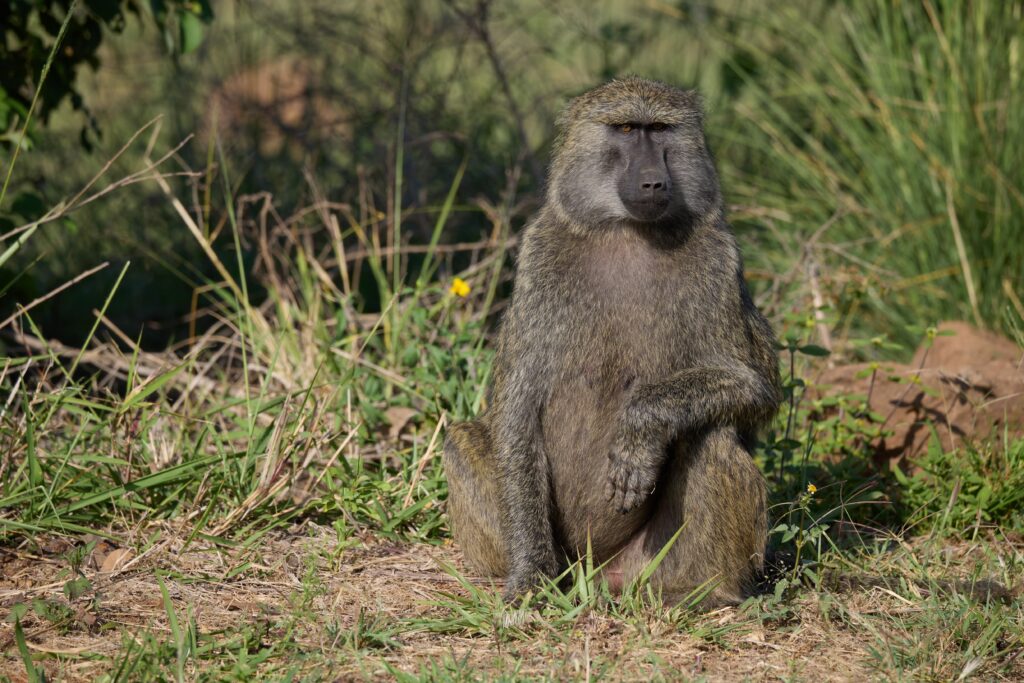
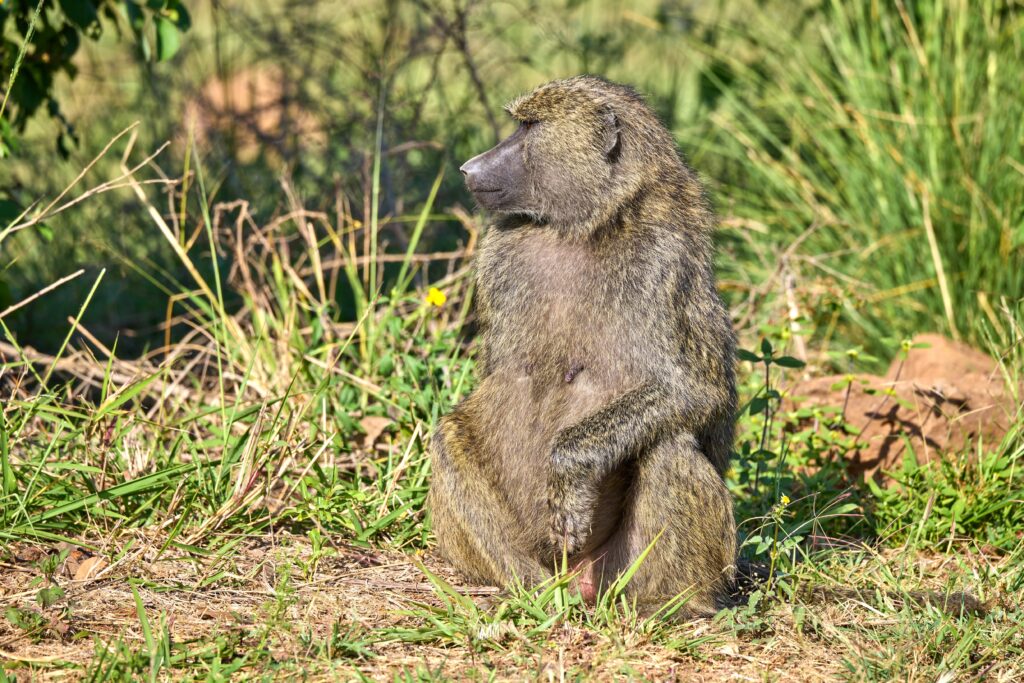
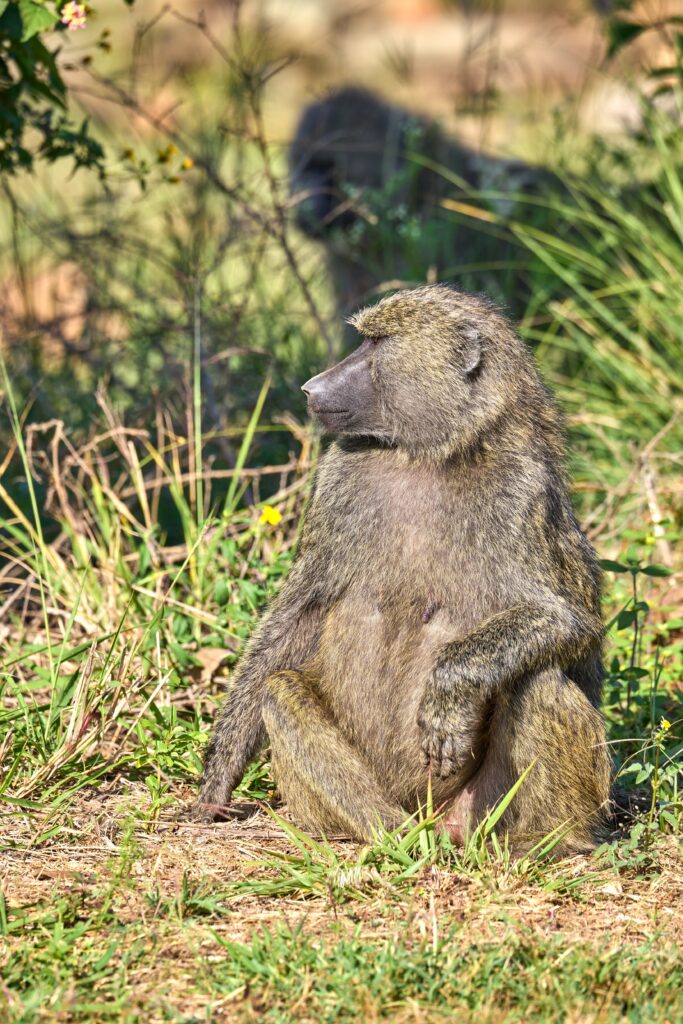
The baboons were a bit of a problem because of the acclimatization to humans. One large baboon jumped onto the hood of a safari jeep and then into the jeep from the open air top, scattering the tourists inside who ran screaming from the car. I was sure, but I kinda hoped that that was the same van load of people that had left their trash behind at the picnic table.
From our safari, we went to the local elephant orphanage run by the Sheldrick Wildlife Trust. The Trust. was established in 1977 and focuses on elephant and rhino conservation, preservation, and rehabilitation. The site we were visiting is an elephant and rhino orphanage where abandoned babies are brought to recover.
There were easily over 200 visitors when we arrived, all around a ropes off circle with a small pond in the middle. Once everyone was set, a group of 13 young elephants, ranging in age from less than a year to about 3.5 years, came out of the forest about 200 meters away, all in single file, nearly running to what we now realized was the feeding circle.
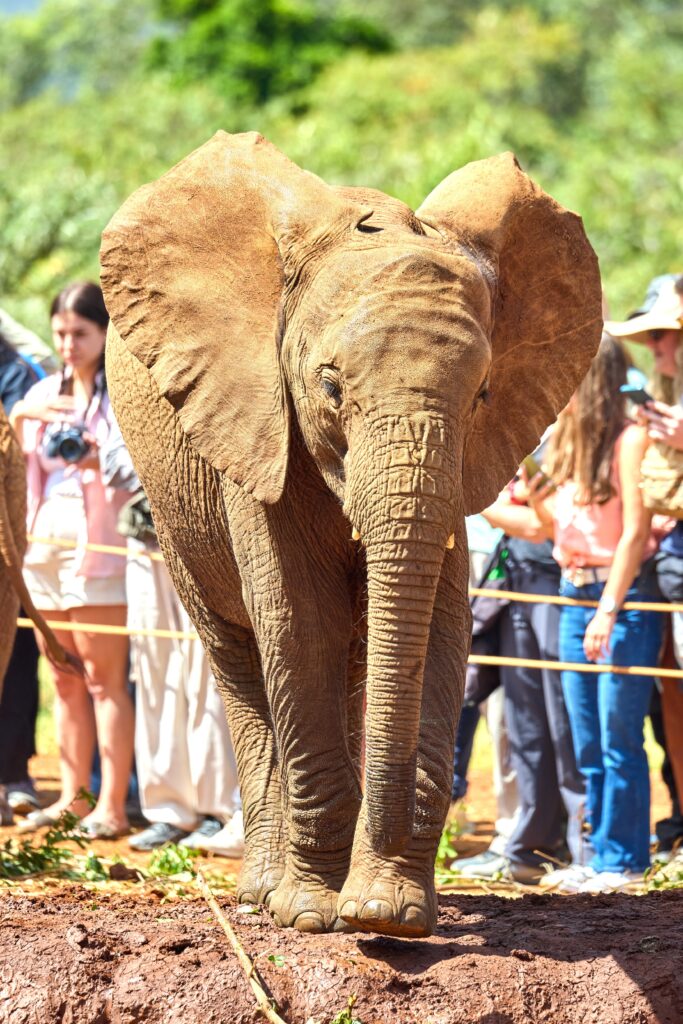
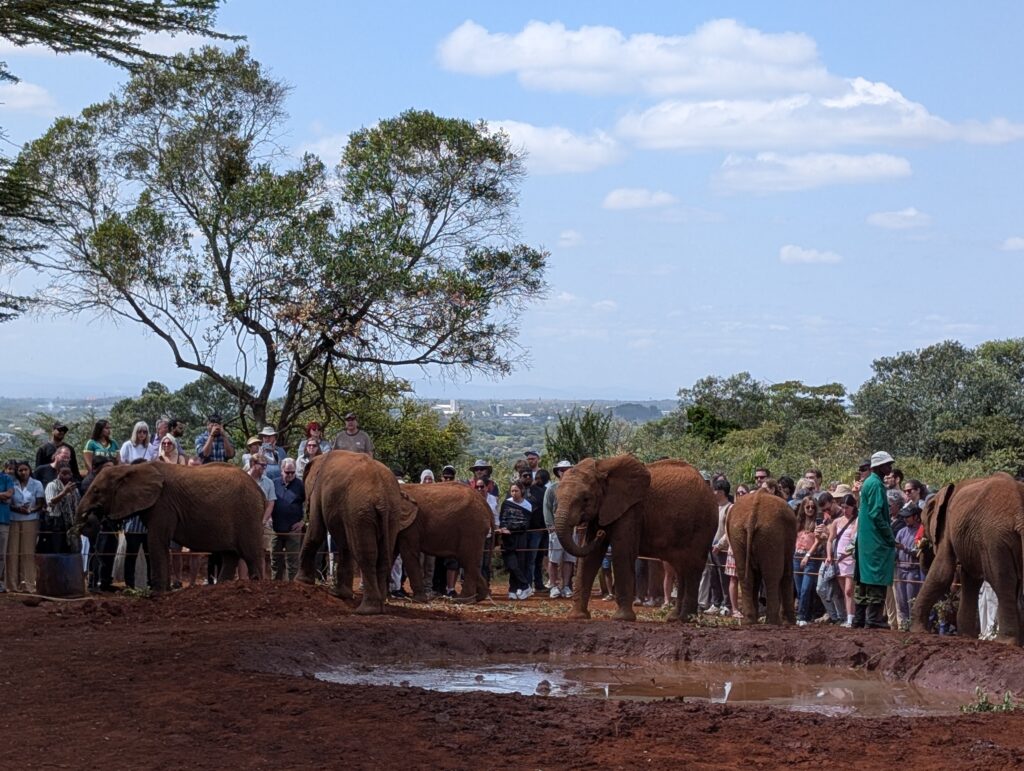
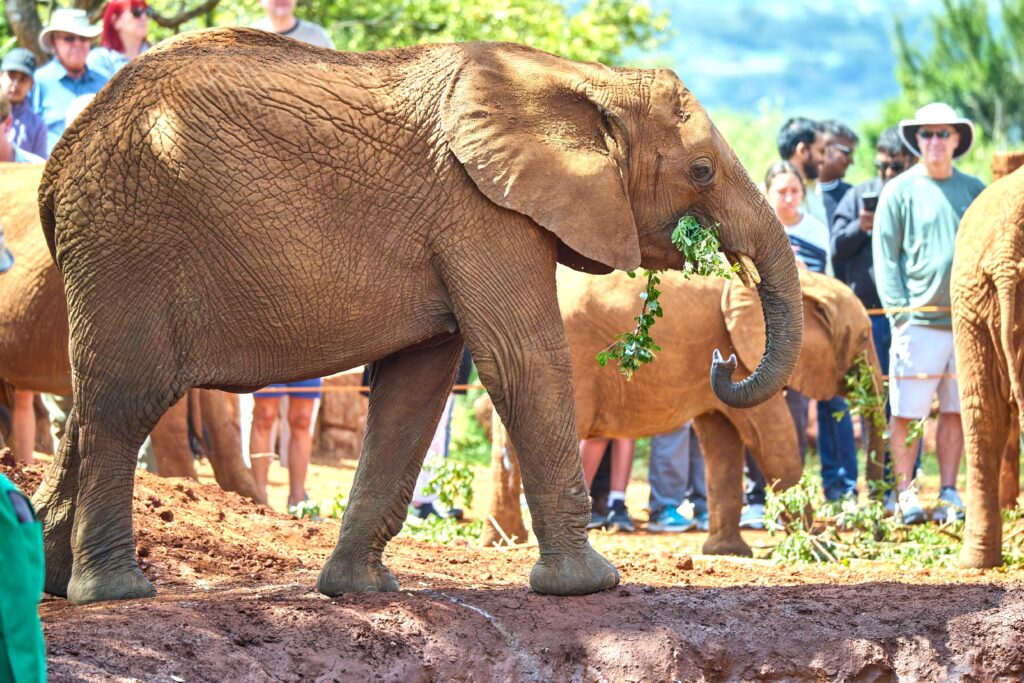
Caretakers brought wheelbarrows full of two gallon baby bottles with huge nipples and handed them to the hungry elephants who grasped the jugs of human baby formula with their trunks and slammed each bottle like a college frat boy chugging a 32 ounce mug of beer. When drained, the elephants dropped the bottles on the ground and went to the leafy limbs scattered around the dirt arena.
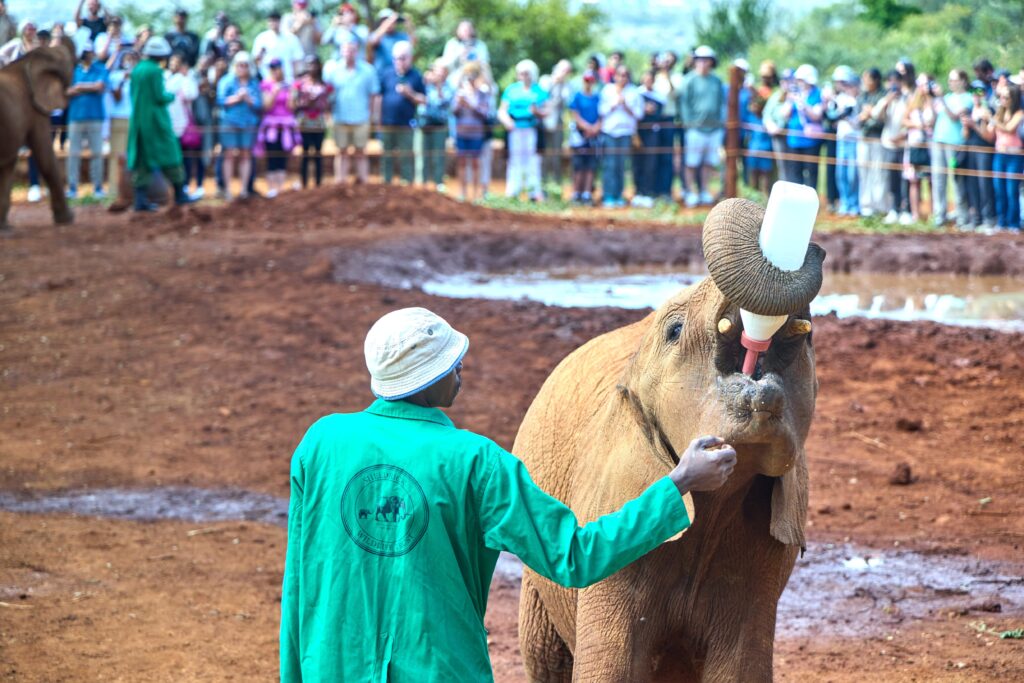
One of the caretakers had a microphone and began explaining the SWT’s background and mission. He introduced each of the elephants and the where, why, and how they were rescued as well as their ages as names.
The fascinating part of their mission to me is how they ultimately reintegrate these elephants back into family herd units within their other units located at Tsavo National Park, southeast of Nairobi near the Tanzanian border.
After the age of four, the young elephants are transported to a “halfway house” at Tsavo where they are cared for every night, but released into the wild during the day. Initially, the elephants return every evening. Eventually, though, they stay away longer and longer as they meet other elephants and become more accepted or adopted into new family units. The process can take up to five years, but the orphans all become acclimated to life in the wild and ultimately join their new friends in Tsavo.
From the elephant orphanage, we went to the Giraffe Center where a band of Rothschild’s giraffes were ket for captive breeding and study. We didn’t get the same level of mission explanation here, but did meet the giraffe’s in this local band led by a large, very dark male named Eddie.
We all had to wash our hands before going in and we were each given a half coconut shell filled with feed pellets for the giraffes. There were detailed feeding instructions on signs around the feeding platforms, showing us how to not be head-butted by the females or bitten by the males.
The Rothchild’s giraffes are bigger than the Masai species, but not as large as the reticulated giraffes of Samburu. They are distinguished by their all white lower legs (below the knee) and the difference in spot darkness between the males (very dark) and females (much lighter).
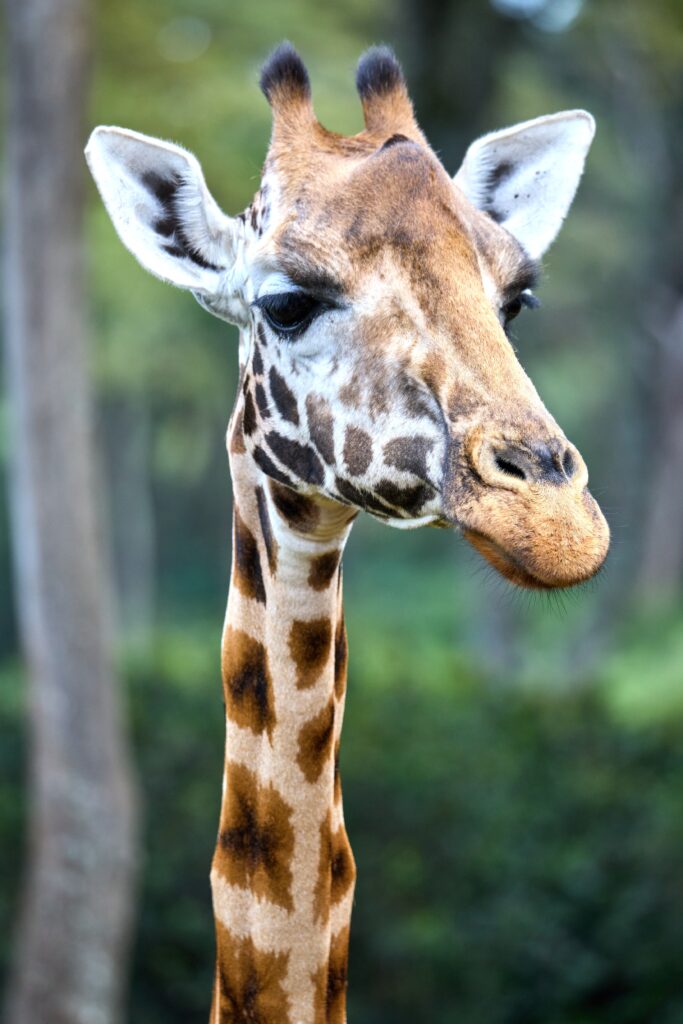
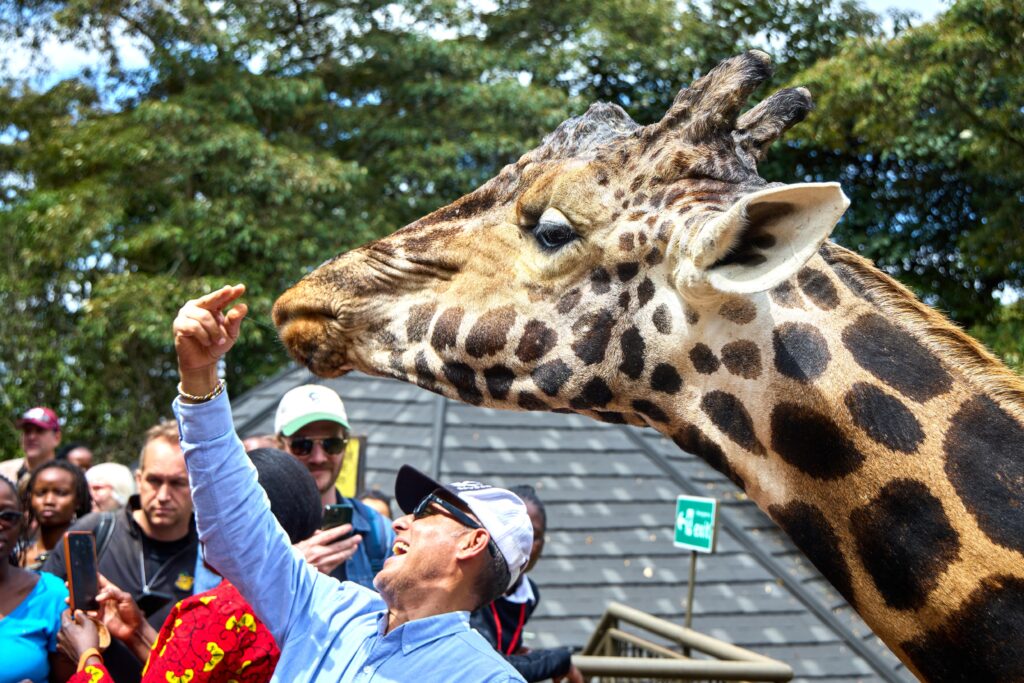
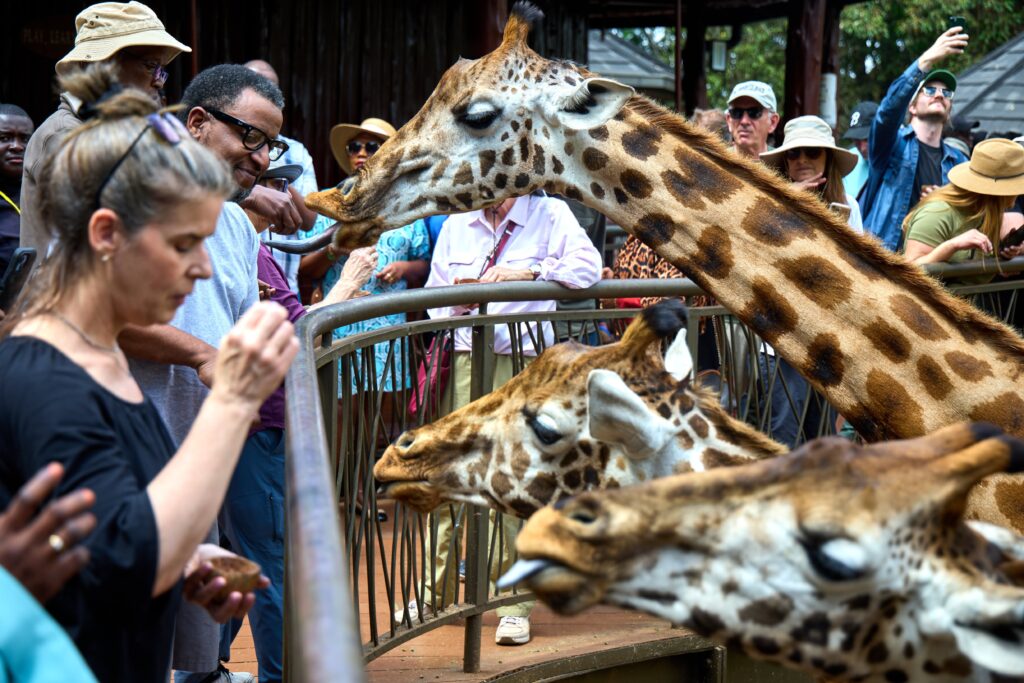
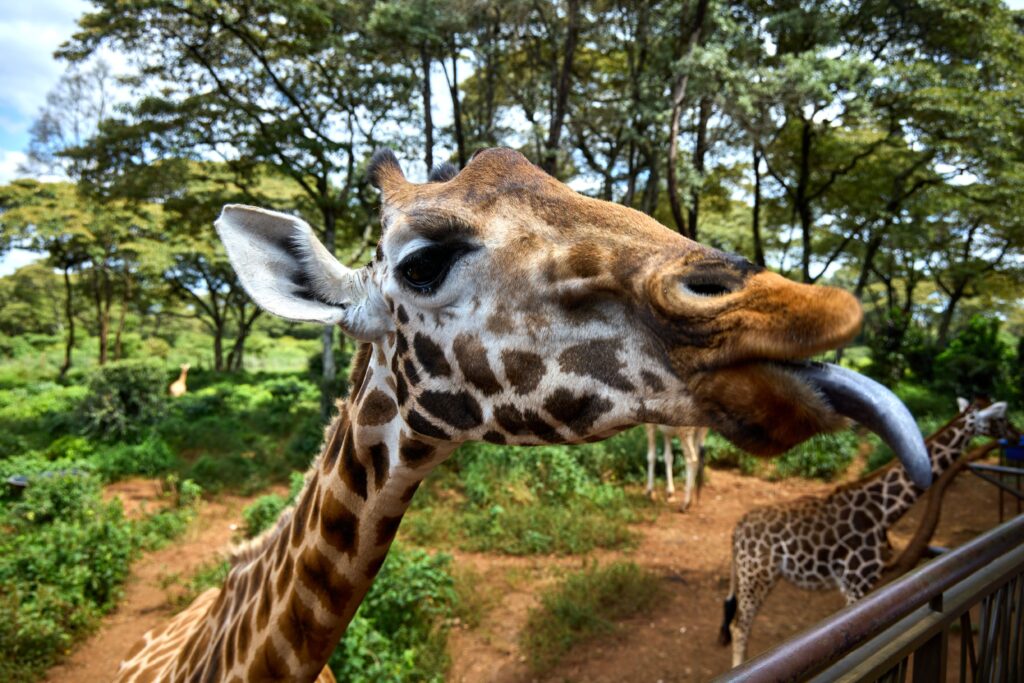
The highlight of the group was a one-month-old baby of as yet undetermined gender that quietly stiff apart from the feeding giraffes waiting for its mother to return so that it could nurse.
We completed our day by returning to the hotel at about 2:30pm. Becky had been walking the neighboring area while we were gone and discovered a nice coffee shop nearby to help overcome the bad hotel breakfast coffee.
We all agreed to meet in the top floor hotel bar after cleaning up to share some Tusker beer.
Over beers, I monitored the flight progress of DT and Katja as well as the new flight schedule for Hollis. All now seemed to be on track. Kate joined Beef, Becky, and me and we talked politics and the upcoming parade in DC as well as the counter-protests around the country.
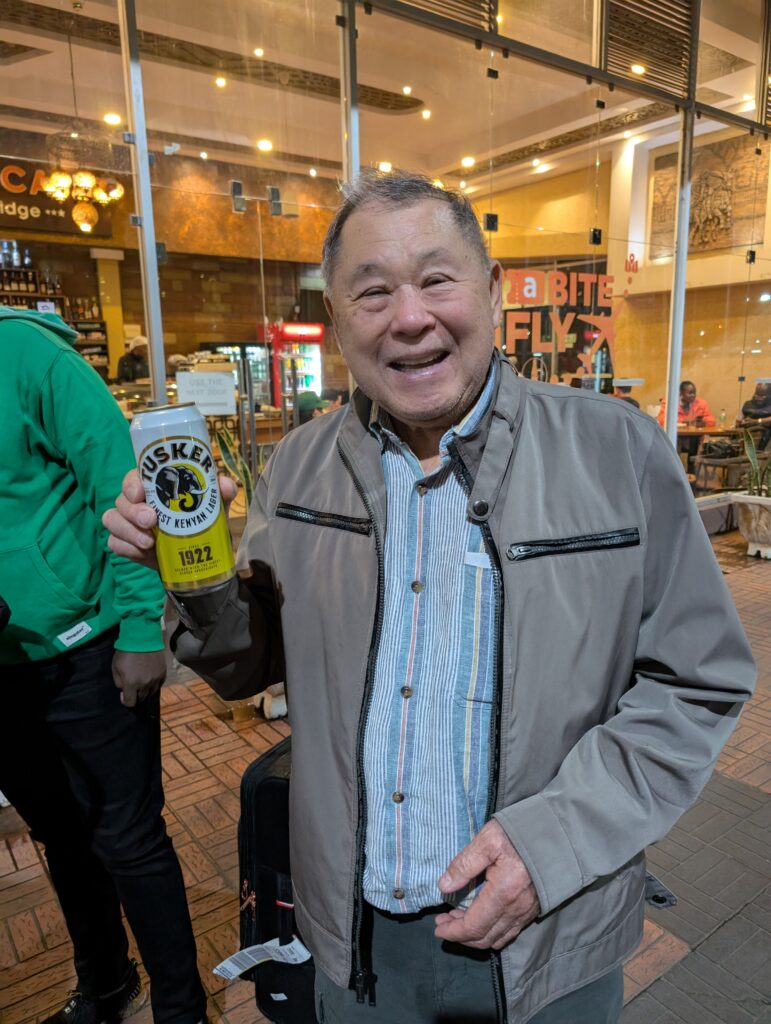
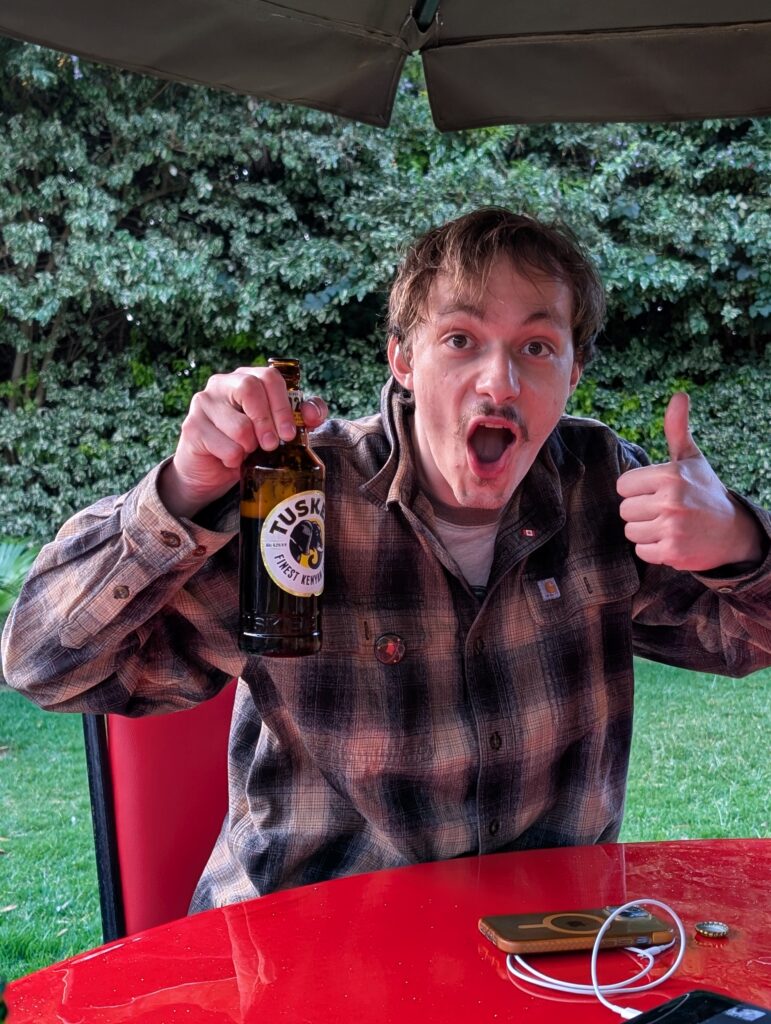
Becky made dinner reservations at The Carnivore for the evening and we made plans to meet in the lobby at 5:30pm. Ginger begged off of dinner as she was in pain from her recently fractured collarbone, exacerbated by the bumpy safari jeep ride from the morning.
I booked an Uber and five of us (Yami joined) squeezed into what was advertised as a six-passenger Toyota Sienta. Our driver, Samuel, maneuvers deftly through cameras Nairobi traffic and we arrived only a few minutes late to the restaurant located very near the airport on its civil aviation side.
The Carnivore was just as we remembered it from two years before, in the style of an Argentina all-you-can eat meat house with carvers maneuvering between the tables with long knives, but more exotic meats. The “Dawa’ served honey-lime-voska cocktails at table side and we could also order wine and Tusker beer.
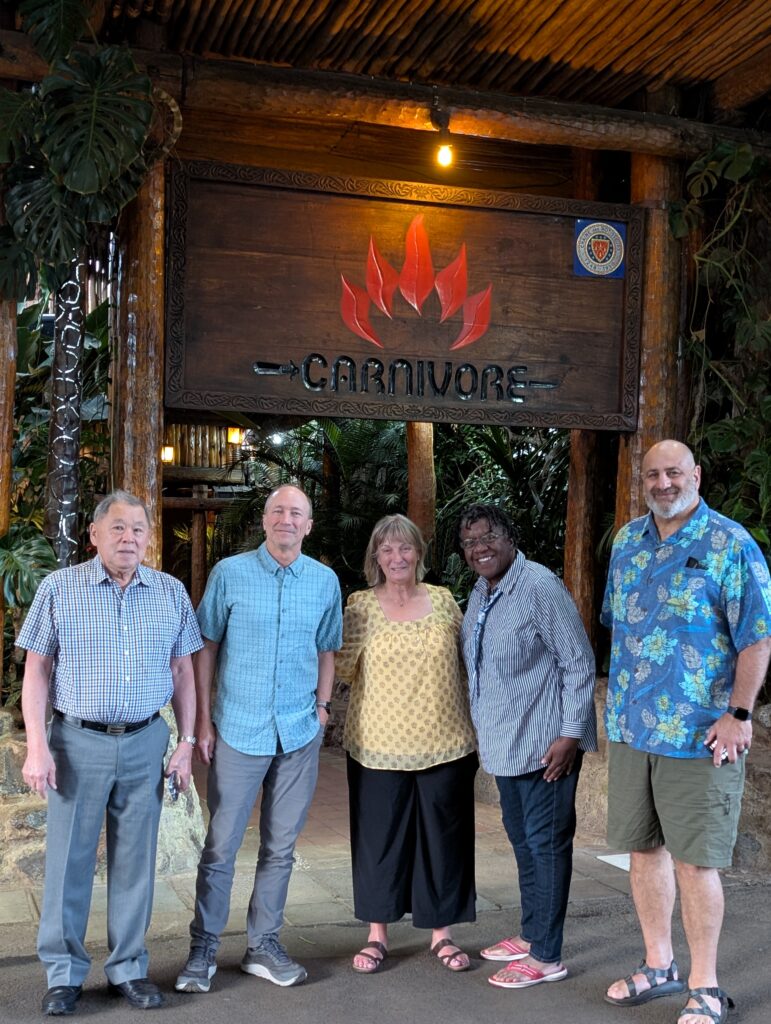
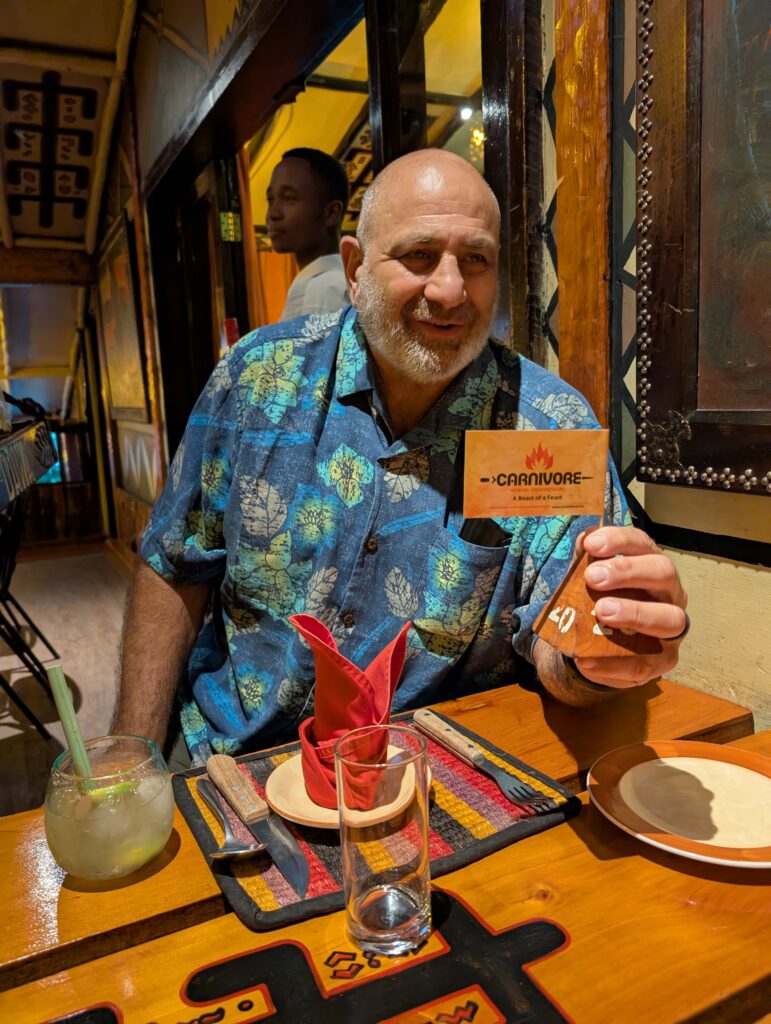
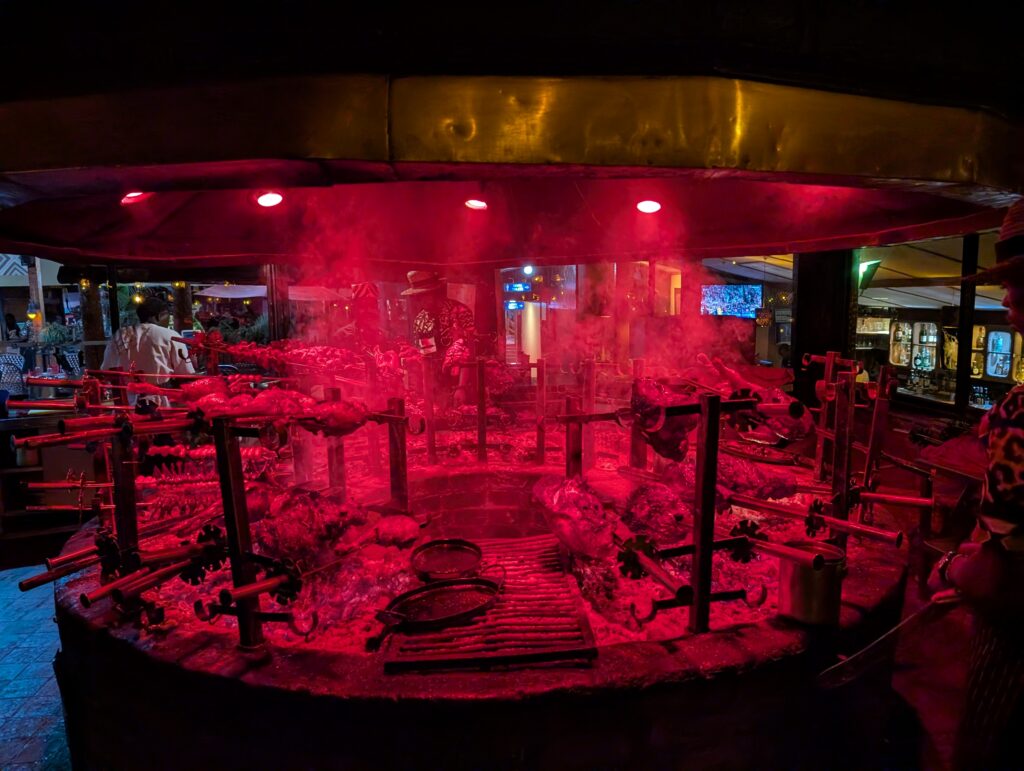
All of the meat was good, but the ostrich highlighted the meal three ways: carved medium rare roast; meatballs; and grilled liver. The crocodile was a bit chewy, and the ox balls seemed blind in comparison. We had pork and chicken sausages, roast beef and both pork and beef ribs. The lamb was excellent and tasted very similar to the ostrich.
Dessert was included, but we couldn’t finish all of it, sharing crème brulée and Sacher torte.
We took another Uber back to the hotel and, as we went to bed, monitored the progress and pick-up of DT and Katja at the airport. Mark was arriving even later, but I was not worried about him nor that Joseph would be ready to pick him up.
Sunday 15 June 2025
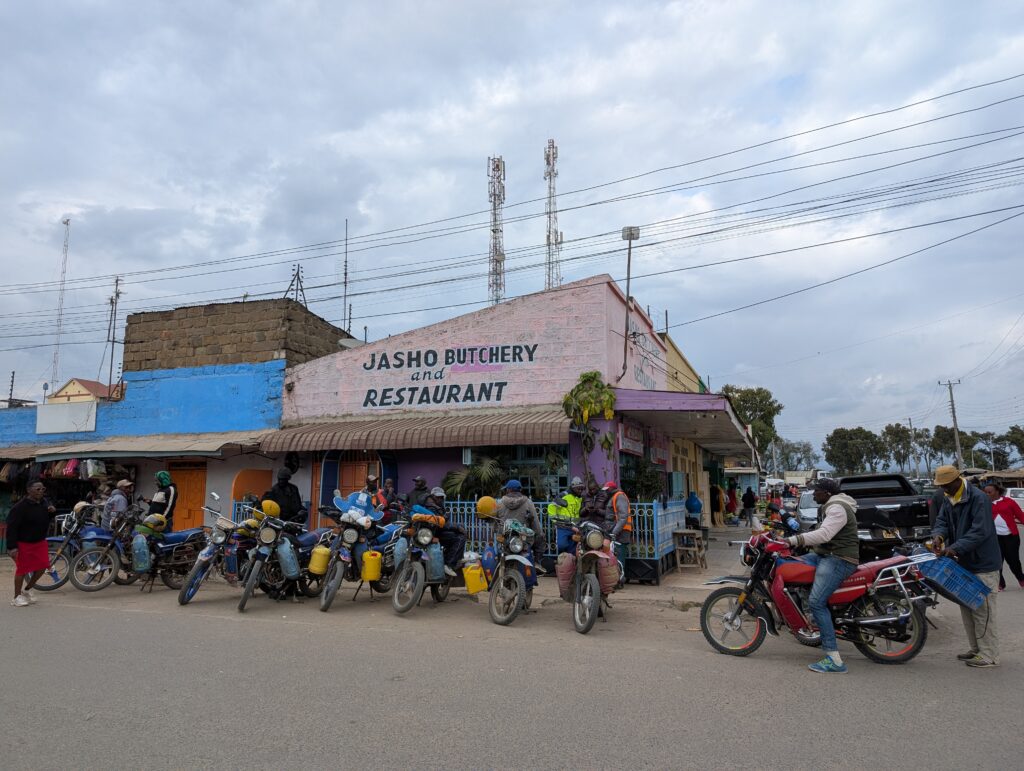
I slept fairly well aided by an Ambien, but Becky didn’t do as well. I checked messages that confirmed the arrival of Kat and DT and, since I saw nothing to the contrary, assumed that Mark had arrived safely.
Hollis was laying over in Abu Dhabi and set to arrived in the early afternoon. He would get an individual car and driver to join us at the Lusoi Resort in Naro Moru while the rest of us would leave the hotel at 10am.
I finished processing the previous day’s photos and uploaded them to my Google photos album to share with the others, then we went down to breakfast.
We were the first in our group to the breakfast area, but DT soon joined us. He planned to go for a neighborhood walk after eating since we had plenty of time before departing.
I did some trip accounting work in the dining area and met Kat, Beef, Ginger, and Kate later there. Becky finished packing and we all met on time in the lobby.
James arrived first as he needed Yami to sign a release form for his lost luggage that would be picked up today and delivered along with Hollis. DT has a delayed bag from the night before, too, but it wouldn’t arrive until Sunday night. He made arrangements for it to be delivered by the airline directly to the Lusoi.
Joseph and Isaac came with the vans just before 10am. It was great to see Isaac again as he’s been such a great driver and guide two years ago.
We left on time, but then stopped at a Carrefour to buy large bottles of water for the worksite. We also used the stop as an opportunity to buy some beer, wine, and liquor to consume at the resort as well as some additional snacks for the team.
We were on the road again any about 11:15am driving along the major highway to the north that had largely been under construction two years ago.
We were pleased to see that the highway construction that we’d suffered through two years ago was complete–at least for the first 100 km. The Kenyans do put speed bumps in the divided highway, though, at regular intervals slowing things down considerably. Still, we made good time and stopped at about 1:15 at the coffee and curio shop we’d visited in 2023.
Several of us bought coffee at the shop and did a preliminary souvenir viewing. I assured the staff at the shop that we would be coming back in two weeks and that was when we would buy.
Our barista’s name was Kate and she and our Kate immediately bonded. The local Kate had a beaded bracelet with her name and the Kenyan flag on it and so she promised our Kate that she would have one for purchase when we came back.
Once we left the shop, the highway construction began a new. The road was reduced to one lane in each direction, which, in Kenya, means at least two cars squeezing by each way, plus bicycles, motorbikes, and pedestrians.
Along the highway, we saw many vendors selling a variety of fruits, vegetables, and other products. Near Nairobi, pineapples were plentiful. We saw oranges and other citrus, roasted corn-on-the-cob, and arrowroot, as well as large white woven plastic bags of charcoal. Some spots sold mangoes. At higher altitudes (nearly 6000 feet, we began to see coffee plantations mixing in with the more common bananas and corn.
We arrived at the hotel before 3pm and checked in at the lobby. It hadn’t changed a bit in two years. Young ladies at the front desk greeted us with hot face towels and cool glasses of juice as they processed our passports and assigned us to rooms. Daniel, the operations manager, introduced himself and told us to find him if we needed anything.
Once the rooms were assigned, Mark Kijowski led the group through the outdoor guest area past the restaurant and then the indoor and outdoor bar areas. We met the vehicles in our little compound area that was the same as in 2023 and we went to our rooms. I chatted with Isaac and Joseph and let them know that we would be leaving for work on Monday morning at 8am after a breakfast starting at seven.
Becky and I unpacked and asked for assistance in getting the extra bed removed from our room so that we had more space. We connected to the wifi and relaxed a bit before heading to happy hour. Hollis was on his way from Nairobi and we expected him to arrive at or near about 5pm.
We met Yami and Mark at one of the outdoor tables for happy hour. Katja arrives soon after, then Hollis showed up. I bought him a Tusker and we did introductions. Beef, Ginger, and Kate rounded out the team.
Dinner started at 6:30pm and we had a set menu from which we could choose several items including beef, chicken, pasta, or fish along with vegetables, rice potatoes, and then sliced fruit for dessert.
Near the end of the meal, we held our trip briefing discussing safety, the work site, expectations, and other parts of the project. We left agreeing to meet for breakfast at 7am for an 8am departure.
Becky and I returned to the room and prepped for the night. I had a phone call scheduled with Dan Miller, the DWC Board Chairman, at 8pm–or so I thought. I called him as planned but he didn’t answer. He called back a few minutes later and I realized that we planned the call for Monday evening and I’d confused the dates. Anyway, we talked about DWC in general and the offer of a board of directors seat for me. I gladly accepted and was told that it will probably be confirmed at their 27 June board meeting
Monday 16 June 2025
Becky and I slept fairly well. The compound was very quiet until about 5:55am when, it seemed, all of the birds just turned “on” and started chirping.
After cleaning up, I met DT in the courtyard and we walked to breakfast together. Beef was there already and Yami and Kat arrived shortly thereafter followed by Becky. We had eggs to order, fried potatoes, vegetables and peas, toast, and cut fruit (watermelon and oranges).
The coffee was better than in Nairobi, but still not great. They also served hot Africa milk tea and Becky had. Cappuccino.
On the way back to the room I knocked on Hollis’s door and reminded him when we would be leaving. He ran out for breakfast at 7:40 and was ready to go at 8, as was the rest of the team.
We pulled away at 8:05am, not bad for day one.
The weather was cool and cloudy. We could see the foothills of Mt Kenya but not much else. Along the road, workers wer cutting down grass with hand scythes, bent at the waste, one every hundred meters or so. Cattle were doing similar work at a slower pace, some attended by their owners, others roaming free (or so it seemed), still more tethered by a rope tied to their ankle.
The drive to the worksite took a total of 40 minutes. The Marcharia Comprehensive School was located only about 100 meters off of the highway a few miles after Naro Moru.
When we arrived, we were met by our local lead, Gladys, the school’s principal, Jane, and then the work team led by Simon and the foreman, John.
We put our bags under the tent and then went to the main school yard where we were greeted by all of the students and teachers. They lined up by grade level from preschool through grade nine. Theynere all in school uniform with the primary school children in bright red and white and the junior high teenagers in grey.
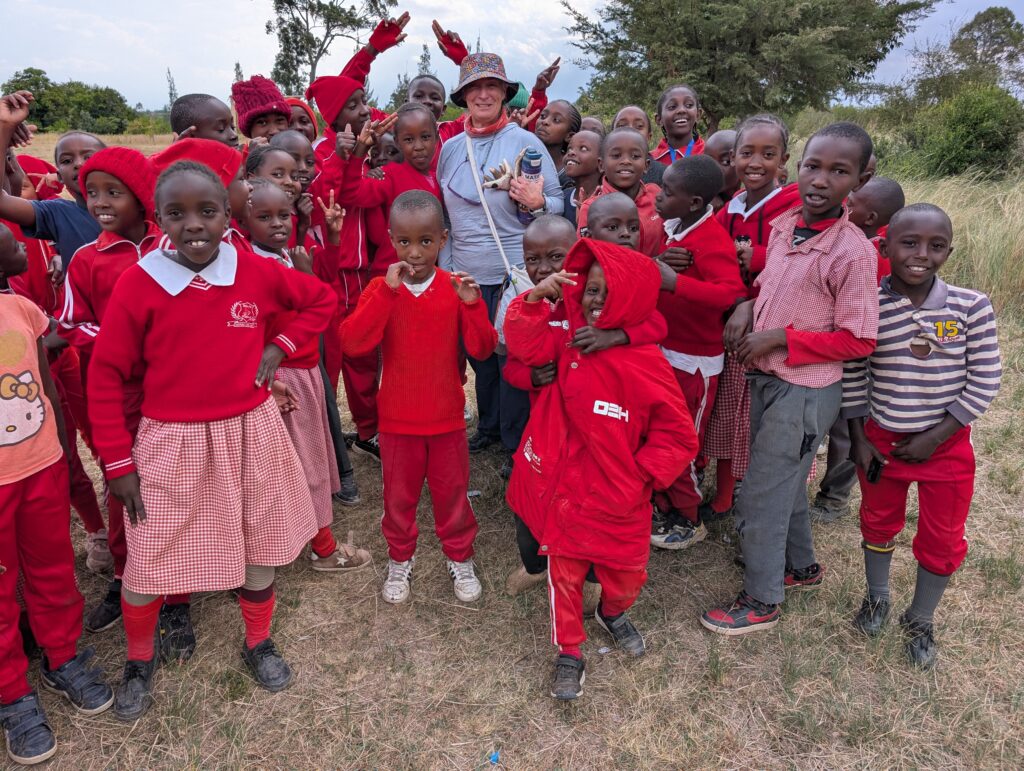
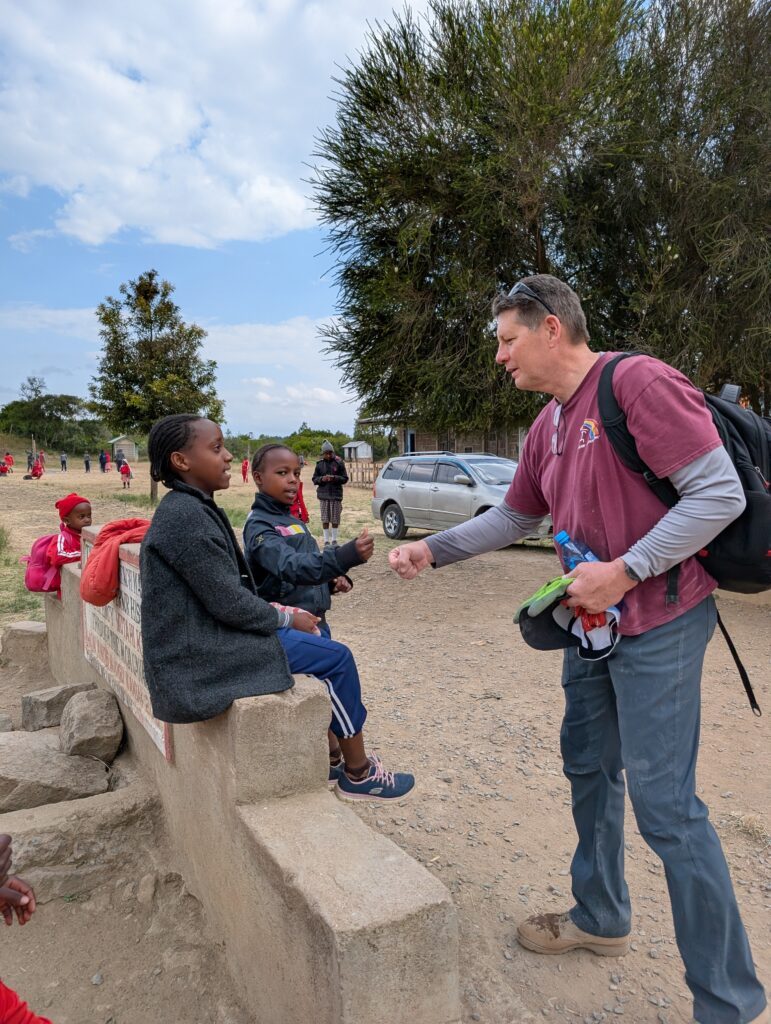
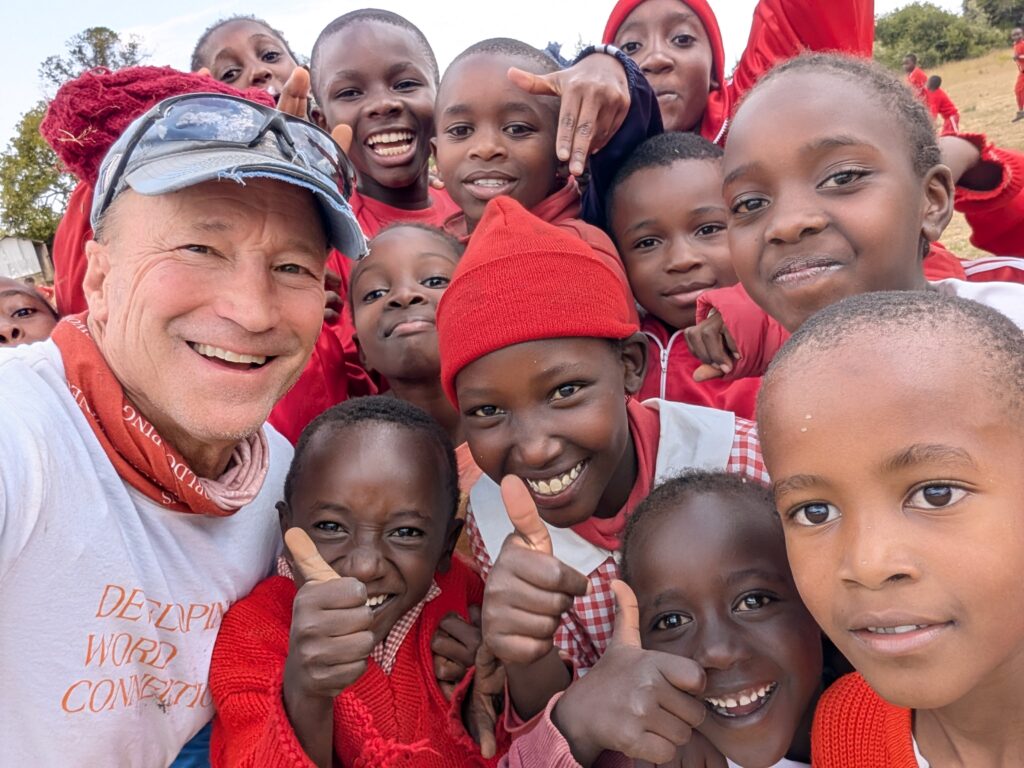
I introduced the team to all of the students and then they greeted us with cheers and a short version of “If You’re Happy and You Know It.”
Next, we went to the work site to meet John and Simon. We saw that the classroom pillars had been completed, as well as the foundation and floor, but the first, base set of stone blocks were not in place.
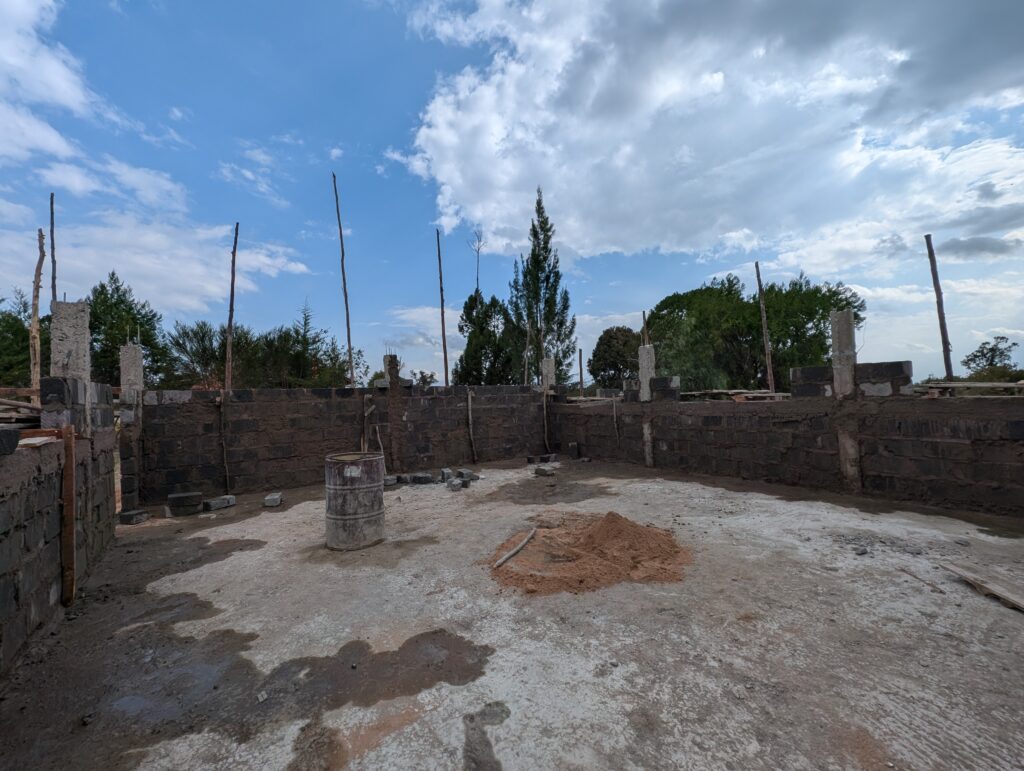
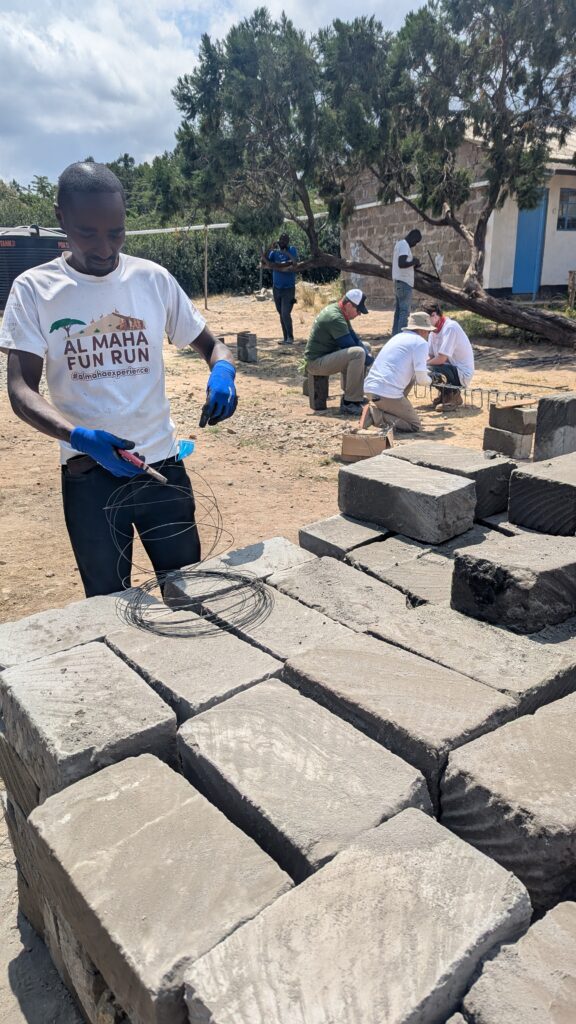
After introducing the other workers to us, Simon explained to us that we would have two jobs to start the day: mixing concrete and washing the stone blocks. He chuckled and then looked at Becky, joking about much he knew she enjoyed that task.
The other half of the team would be mixing concrete and prepping the area to see stone blocks, just as we had done two years before. In fact, Simon told me that the work would be identical for this new classroom.
The good news was that this classroom was really an addition the an already operational wing of the school with several classrooms. We would be adding the three walls needs for the addition and that room would be only about three-quarters the size of the previous project.
The teams split up, with Kat, Kate, Yami, and (for a while) Hollis scrubbing the bricks with new steel brushed and a wheelbarrow. Things we’re already better than last time.
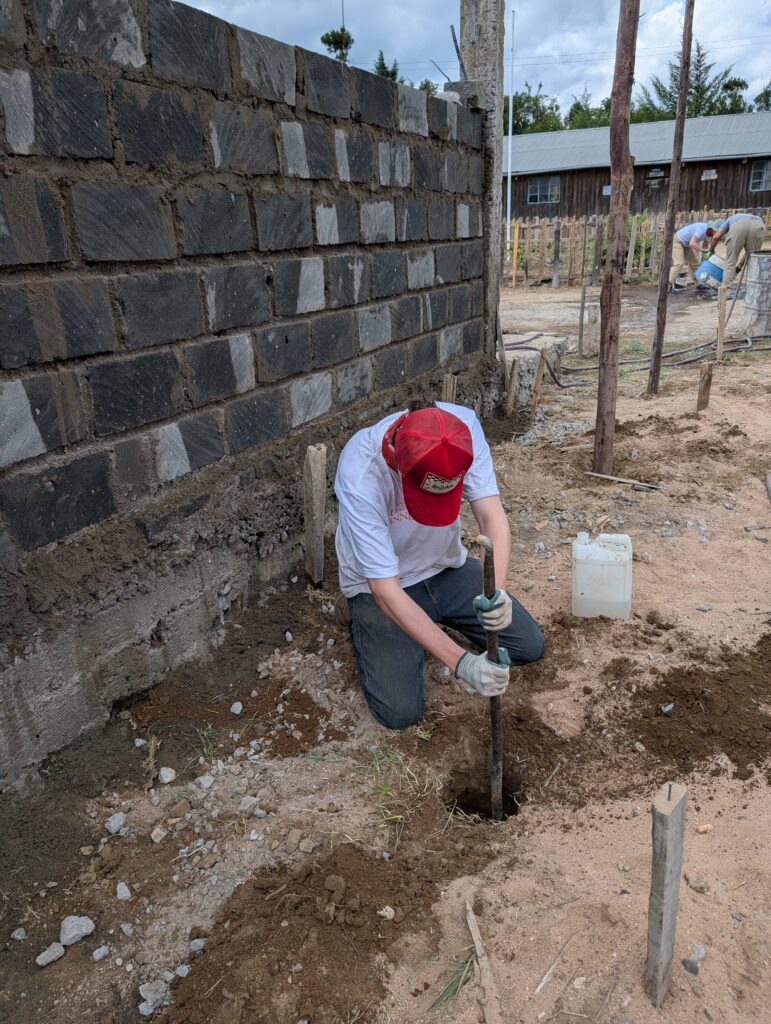
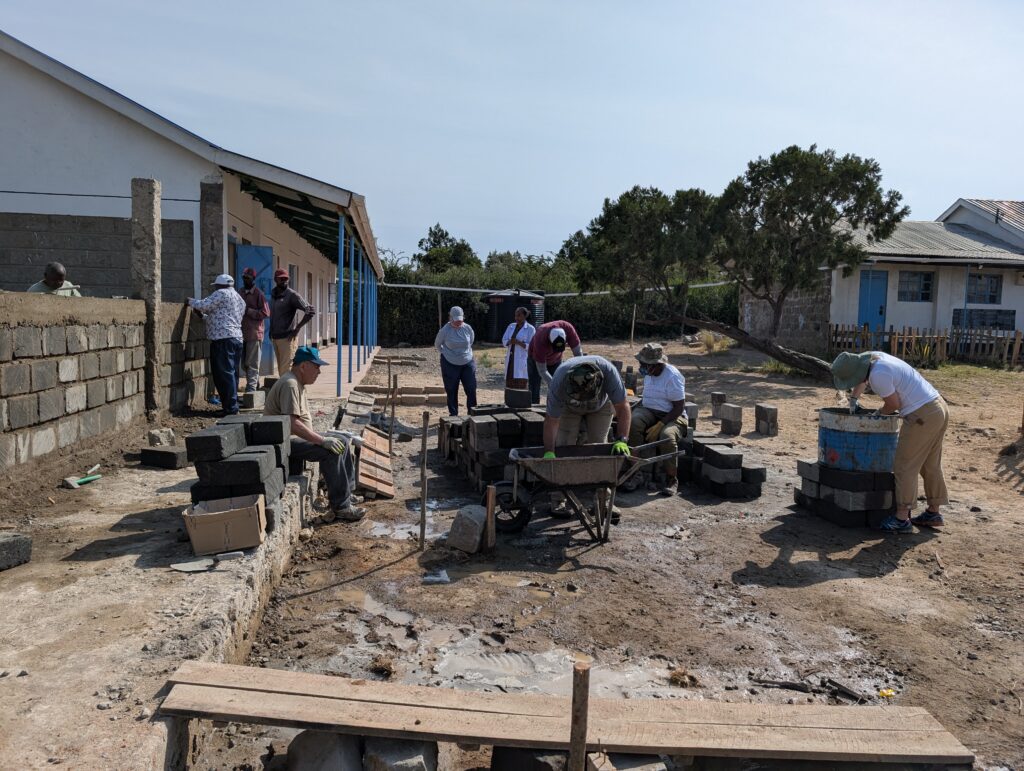
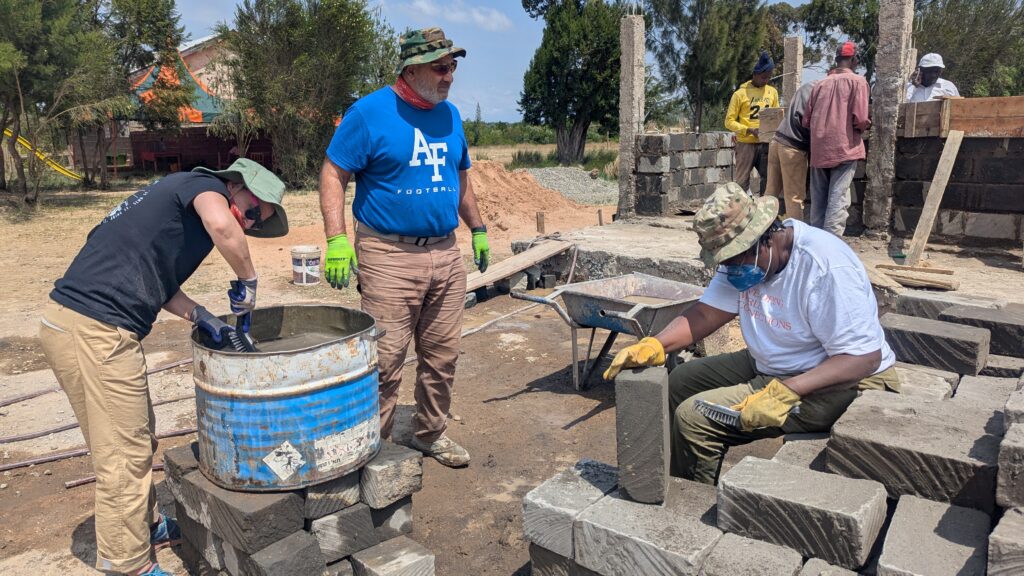
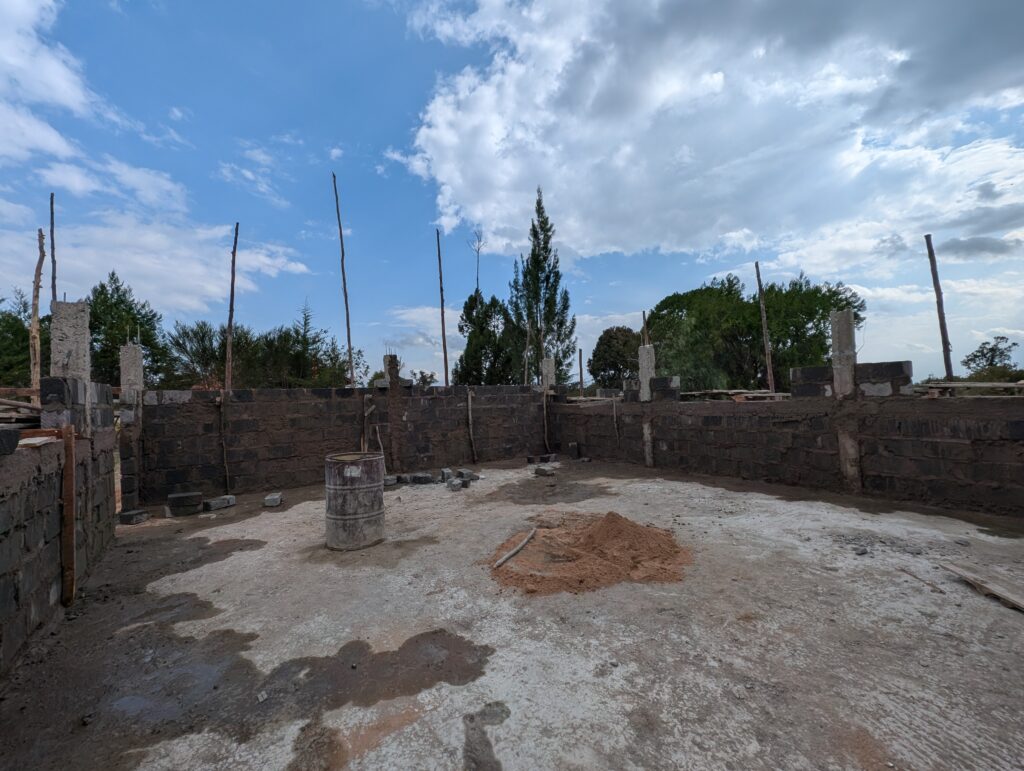
The concrete mixing was huge undertaking. We started with 12 wheel-barrows of sand and the four 50 lb bags of Portland cement. The raw pile was huge and we moved it four times to dry mix it.
Ten, the work began setting the first layer of stone. Two side we’re distinctly lowest than the front, so we had to break each block in half the long way to fudge the same level height as set by their clear plastic tube level.
This first set of stone took hours to put in place. We all worked on cutting stone with the locals and letting them set them. We filled the gaps with concrete. Once complete, and after tea break, we laid the first full layer of stone, finishing just before lunch.
The team was doing very well, but also working very hard. Beef had had some digestive issues the day before and wasn’t full speed. Coming from Florida, the altitude zapped him quickly. Kate was feeling nauseous and light-headed and stayed in the shade for a while before joining the stone-washing crew with Yami, Becky, and Kat.
Hollis learned to fill masonry gaps with concrete, as did DT and Beef. Mark was using a chisel to tear into the end columns of of the existing building to find the rebar columns that we would tie into with more rebar, more effectively locking the new structure to the old.
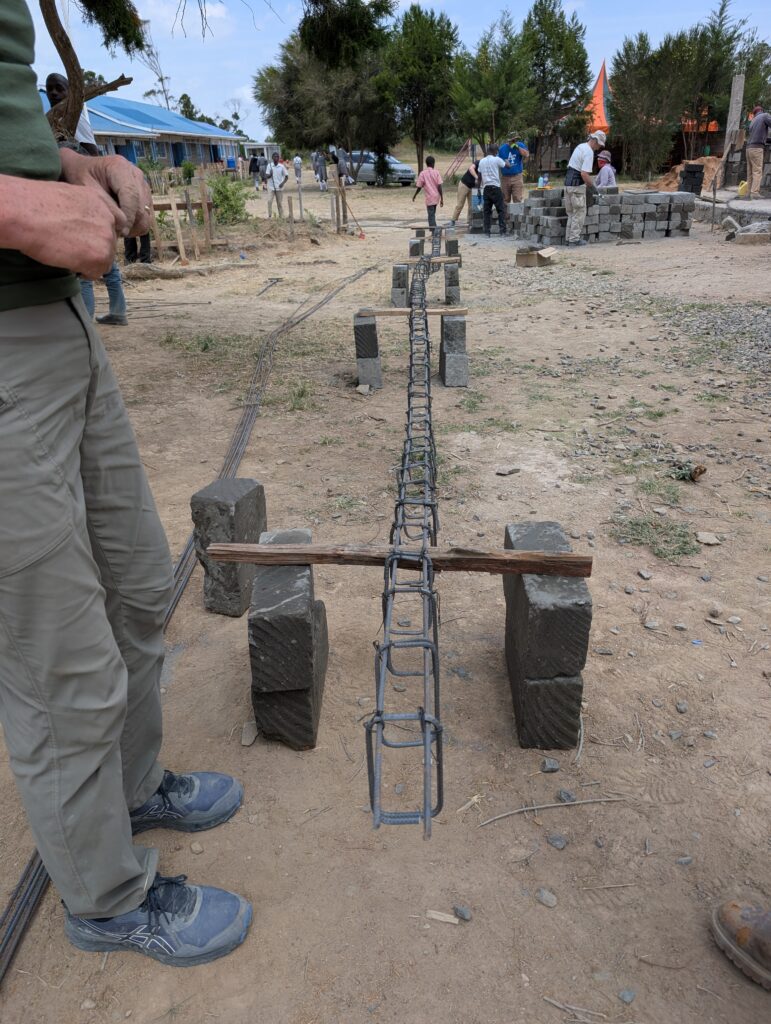
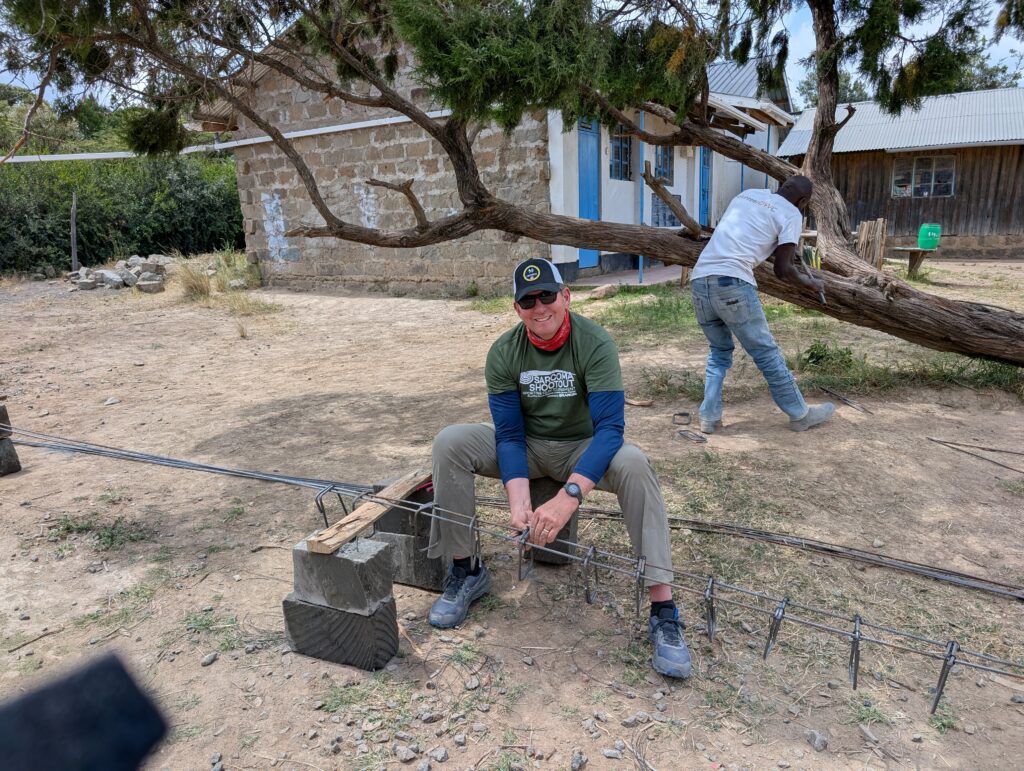
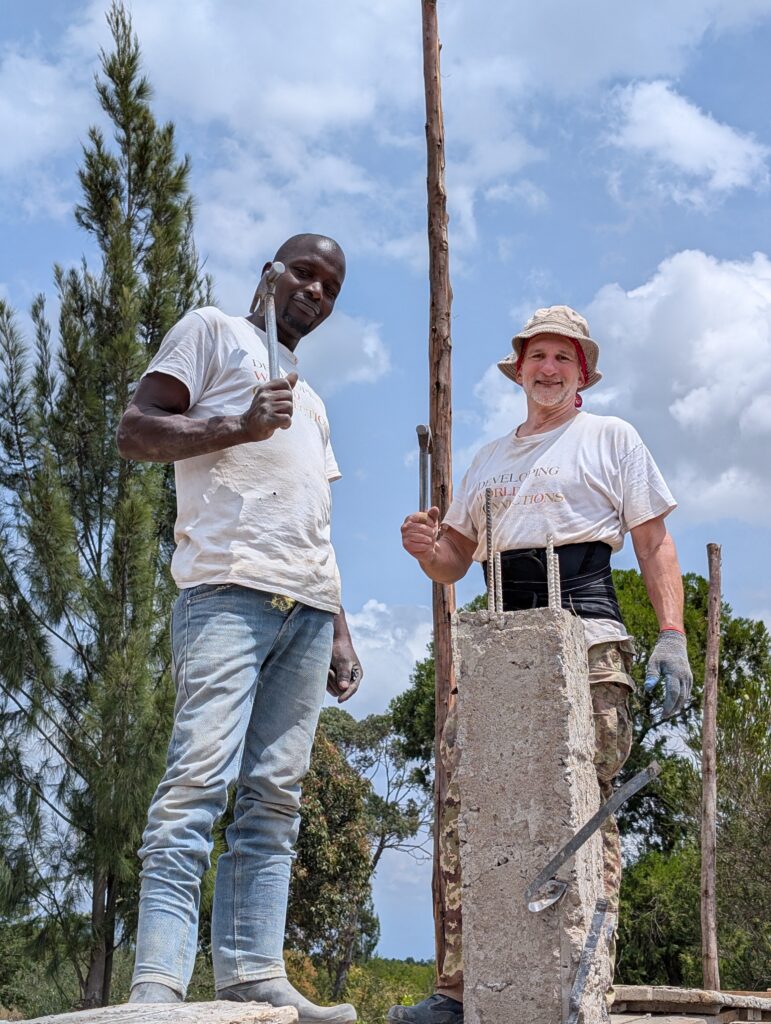
We accomplished quite a bit before lunch and were happy to be moving quickly. All of the teams were working well together.
Lunch consisted of spinach, rice, and a ginger beef stew that was excellent, LL prepared by Lucy, Nderitu ‘s sister and a young chef. We also had orange wedges and tea.
We went back to work at 2pm expecting to finally use up the giant concrete pile from the morning. Now that the base layers were set, we made excellent time, completing two more layers in just over two hours.
At the end of the day, Gladys called us all together so that we could quickly discuss the day’s progress and allow Simon to tell us the plan for tomorrow. I thanked everyone for the hard work, too.
Simon said that tomorrow, we would continue with the work as we had done today, but that we would add curing of the walls with water–again noting how much Becky enjoyed that task!–and saying that we would work on constructing the rebar rings that would reinforce the block structure.
We left at about 4:15pm, all exhausted but happy with our first day. It had helped that the weather was breezy, cool, and partly cloudy. Also, our work area was somewhat shaded on one side. We had completed a base plus three full layers of stone. Isaac thought we were well ahead of schedule and that, at this pace, we might finish early and have nothing to do the last day or two. We told him that we were good with that!
We were back to the resort shortly before 5pm and agreed to our usual optional outdoor bar meet-up for happy hour. I arrived first with a couple of cold Tuskers, followed by Hollis, then Beef, Ginger, Kat, DT, Becky, and Mark.
Yami’s lost bag finally arrived, but DT’s had not. We hoped it would get here during the day, but now we were holding out for sometime late tonight. He’s such a big guy that the option of buying clothes locally didn’t sound feasible.
Dinner was a buffet with fried chicken, vegetable curry, beef teriyaki, pasta, mashed potatoes, and an excellent pumpkin soup. Just as before, the soups were great.
Dinner was fun and everyone was energized by our first day’s accomplishments. We did a little research and discovered that the stone we were using is called Ndarugo stone from a unique quarry in Kenya. We used it two years ago and again for this project. I couldn’t find an explanation of exactly what kind of stone constituted Ndarugo cut stone, but it was clearly a very soft rock not unlike a solidified clay. It is easily chipped and broken into pieces and seems to bridge the gap between brick requiring considerable manufacturing and processing and a hard cut stone like granite. This will take a little more time and research.
At dinner, DT asked to speak to the whole group and gave a very gracious shout-out to Kate for persevering through some sickness and not feeling well to contributing substantially to the day’s stone cleaning and other work. As usual from him it was a very well done and heartfelt note that was well-received by all.
We broke up before 8pm and all retreated to our rooms looking forward to the next day and adding more layers of stone to our first four as well as constructing the rebar frames that would circle the structure at two different levels.
Tuesday 17 June 2025
In the morning I was not as sore as I thought I’d be and the rest of the team seemed to feel the same way, at least according to early breakfast reports.
The breakfast buffet included crepes and cooked carrots along with the usual potatoes, English beans, and eggs to order.
On the way back to the room, I dropped by the front office and asked that extra clothes hangers be put in all of the rooms by housekeeping.
Unfortunately, DT’s bag had still not arrived from Brussels (or Nairobi) and he continued to get the run-around by the baggage agent that was supposedly handling the case for Brussels Air. Beef gave him an extra T-shirt, but he really needed some pants. Finding something in his size in Kenya would be a challenge if his bag never materialized.
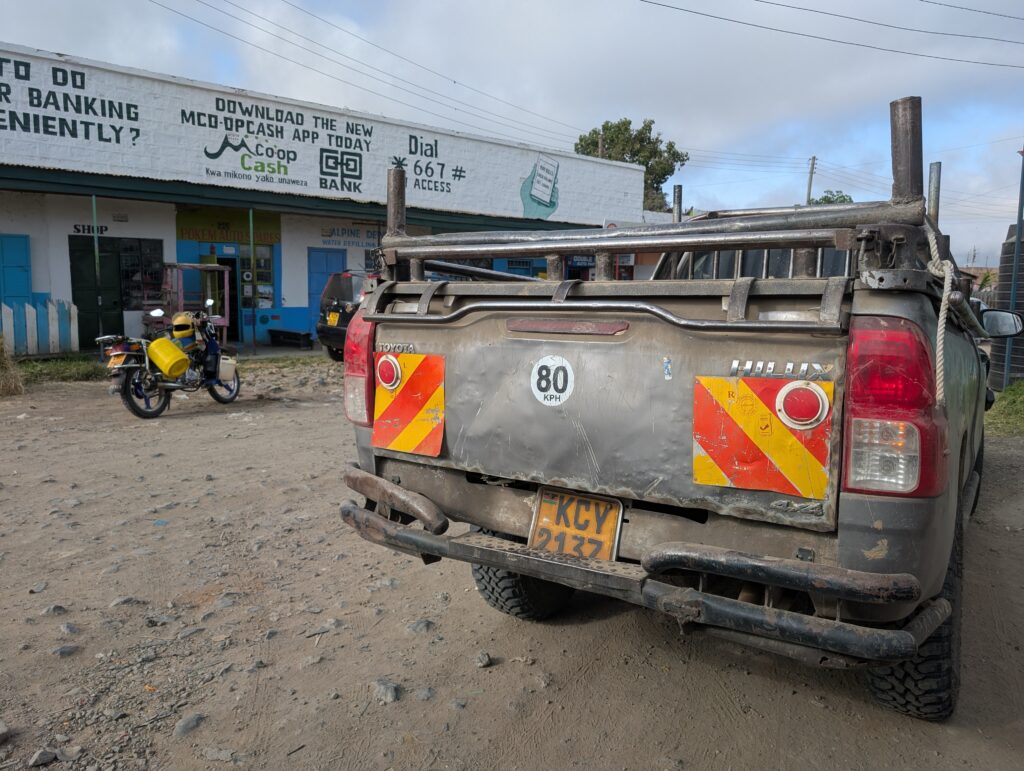
The weather was cloudy, but began to clear as we left at exactly 8am. The forecast called for some drizzle and then about a 40% chance of rain in the afternoon–nicer than the record heat expected back home in Colorado.
We decided to stop at a hardware store in Naro Moru to pick up some extra buckets and gloves to help with the concrete curing and rebar cage assembly, respectively. Beef also asked Isaac if we could stop on the way back in the evening to buy some soccer balls for the school.
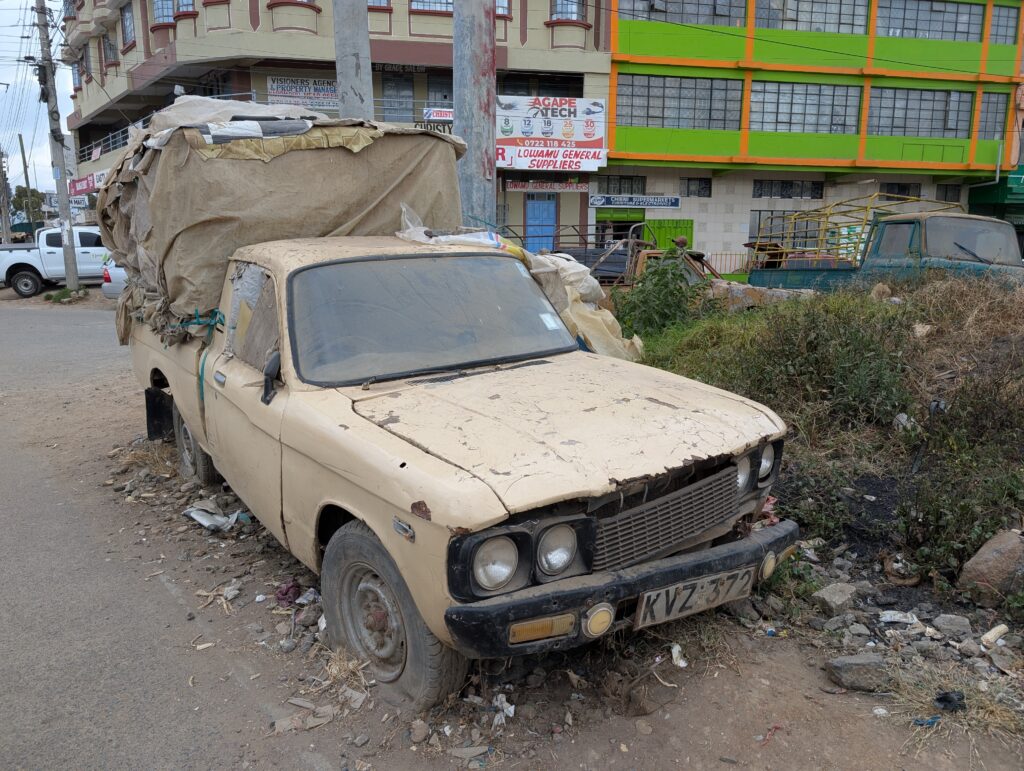
Somehow, the road connecting the resort to the highway had gotten worse. The approximately two miles took 15 minutes and had huge ruts, some filled with rocks too big to smooth the ride.
This morning, we saw large chalk arrows in the road out down early this morning. They looked like what you would see for a cross country race, but Isaac said they were directions to a funeral that would occur later in the morning.
We found cheap leather gloves for Kat and Hollis at a hardware store in Naro Moru, but no spray nozzles or extra buckets. The gloves were 300 Shillings per pair of about $2.30
Wednesday 18 June 2025
Becky and I got up at 6:30am and joined Beef and Ginger at breakfast. The others followed shortly. It was another cloudy, cool morning just like the previous ones. The forecast was identical to the previous days, but with each day the predicted chance of rain seemed to be creeping towards 50%.
Our van stopped in town to buy water and arrived a few minutes behind Joseph’s team. Once again, my Float card (both virtual and physical) was declined and both cards “paused” by Float, despite them being reactivated by DWC with an explicit message to Float that they would be used in Kenya. Very frustrating…
The skies cleared quickly and most of the morning was sunny and warm with almost no breeze. The stone washing crew went back to work and was making great progress. The team’s job today would also include setting up the scaffolding with the locals as well as completing the next two layers of block.
We brought over about forty poles that were really eucalyptus tree trunks about four inches in diameter at the base. Symon showed us where to dig holes around the structure and Mark, Hollis, and I dug 12 holes about 15 inches deep using long crowbars. The logs were set into each hole and then the dirt was packed around them as the primary vertical components of the scaffolding. Before this, Mark and I had removed the forms from the previous day’s reinforced concrete pour and then taken the nails and other supports off of them. These forms would be used as the scaffolding platforms for installing the higher courses of stone.
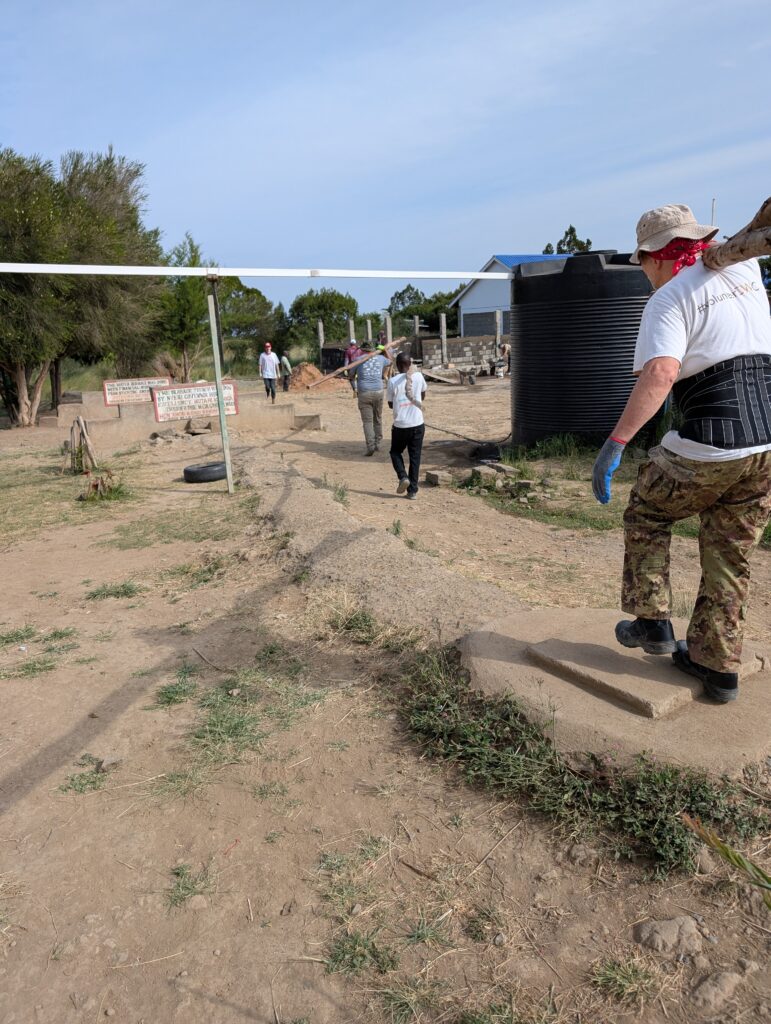
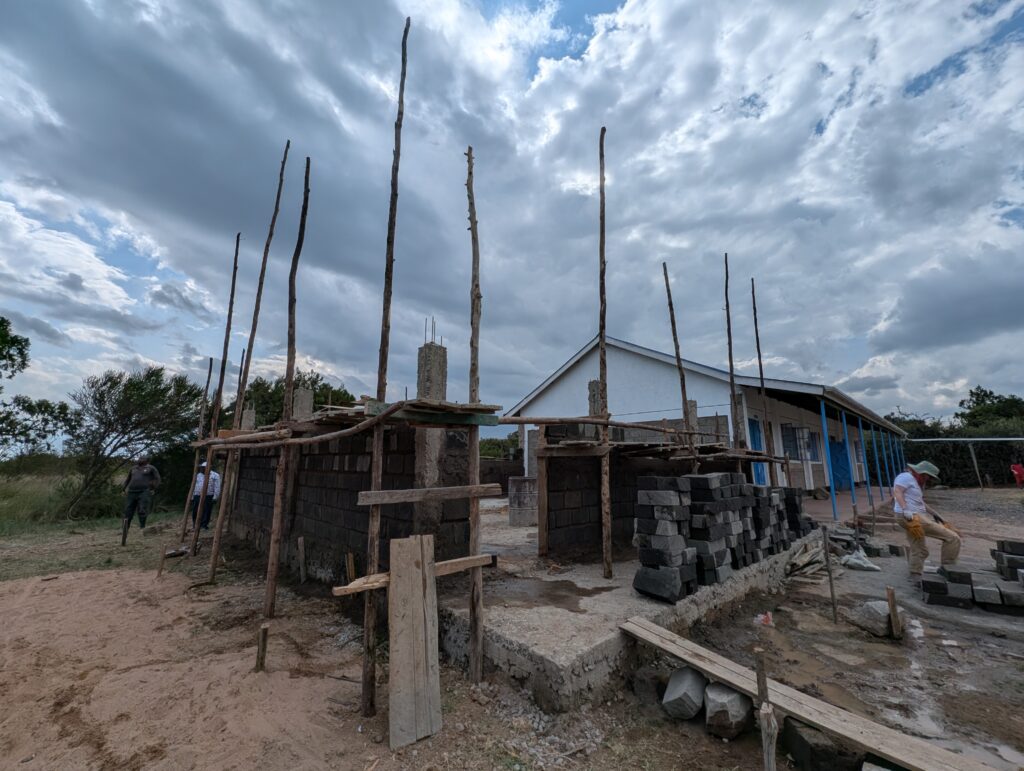
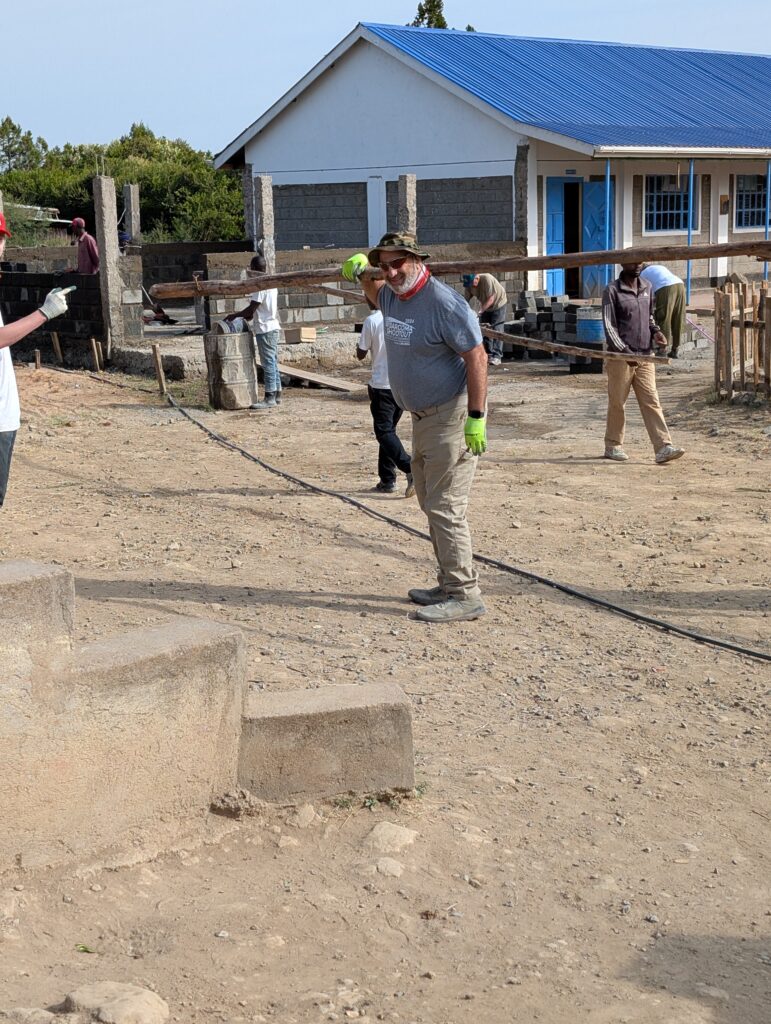
We removed as many nails as possible from the pieces of lumber that had been used as braces for the pour, too.
After the verticals we’re in place, horizontal pieces were nailed into them, followed by braces that locked the scaffolding to the structure. The scaffolding assembly would take all day with the sone masons setting the next two layers of stone while fixing the positions of the window frames front and back.
At the end of lunch, we found the head teacher and told her that we wanted to pass out balls to the kids. They assembled the whole school in the main courtyard as before and the principal and I spoke to the kids. Selhe and I made it very clear that the balls belonged to the school and that they shouldn’t be taken home.
The moment the balls began to be passed out bedlam (and a lot of dust!). But every time one of the school leaders spoke, the kids instantly quieted and listened closely. They sand one song and then did a couple of cheers. The head teacher asked if the children remembered any of our names and they called yelled “Beef!” in unison!
After passing out the balls, we went back to work doing the same tasks as before. A few rain drops cooled us but, but did not disrupt our work. The block cleaners were really working together well and almost everyone cycled in for some of the work. By the end of the day only a single full layer remained, plus about another half layer.
We went to gather our things and we’re thrilled to see all of the kids in the field playing with the balls. There was no organization or teams at all–they we’re just chasing after the balls with the nearest one kicked it. One group of middle school boys was playing a game of volleyball without a net using one of the two “net balls” we had given them.
We walked into the field and I took some video and photos of the kids including the usual selfies that they seem to love.
With our things gathered, we met near the work site and Symon thanked us for our hard work and said that tomorrow we would concentrate on getting the next three courses of stone set, up to the tops of the pillars. Of course, we should also finish cleaning the blocks and may get started on building the rebar cages for the top ring. Tomorrow would be our last work day of the week as we planned to leave for Samburu at about 8:30am Friday morning.
We left right at 4pm and we’re back to the Lusoi at 4:40.
Thursday 19 June 2025
Breakfast was similar to most mornings with the exception of a plate of cooked peas and carrots. Kate said she was skipping breakfast but asked if someone could bring her a banana back to her room. Most had their usual cappuccinos, while I ha taken a liking to Africa Tea, which might better be described as hot milk with some tea flavor.
Yami came to breakfast and looked like he was doing well, which was good to see.
I brought Kate a banana and fruit bowl and she was out to the vans on time for our usual 8am departure.
The weather was as it had been every morning: cool with low clouds slowly burning off. We had still not had a good view of Mt Kenya!
The goals for today were fairly clear: finish cleaning the last of the stones; mix concrete and set the remaining three courses of stone; construct the rebar cage to go atop those three courses; and build the forms that would frame the poured concrete around the rebar cages. Mark and I thought that that last stage would be the slowest work as we didn’t know from where the boards would come to build the frames.
As expected, we started by mixing large batch of mortar while the other half went back to wire-brushing the last of the stones.
As the sones were set, Mark and I filled the gaps between the stones from atop the scaffolding. Things were moving fast and we were done with two courses of stone on all but the front of the classroom before tea time at 11am.
Since we were moving quickly, we convinced Symon to let us get started on the rebar cage for the top ring. Team members went to the storage area and brought the size 8 and size 10 rebar to build the cages. DT led the effort of cutting the smaller rebar into 60 cm pieces so that Symon could form them into the cages.
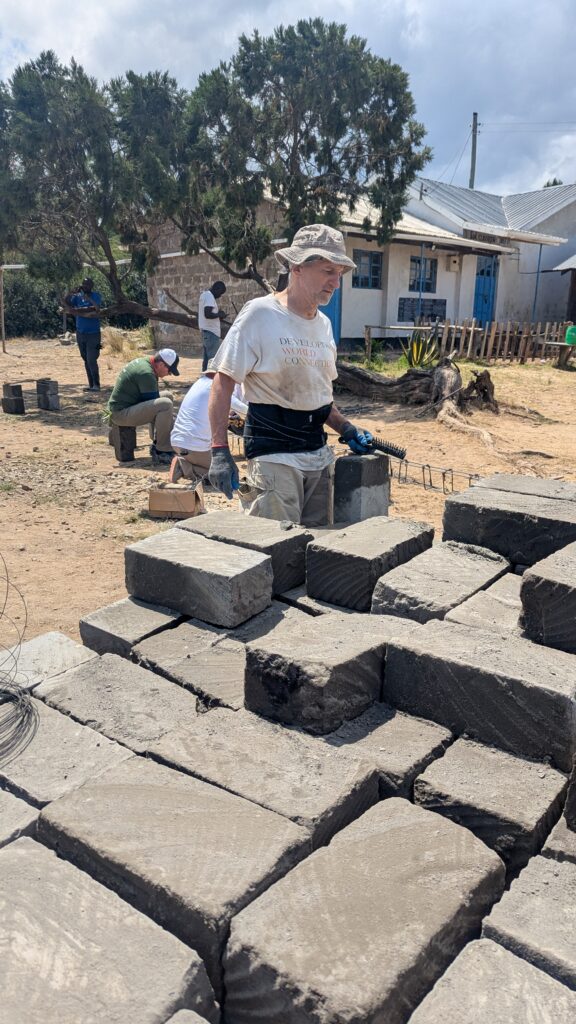
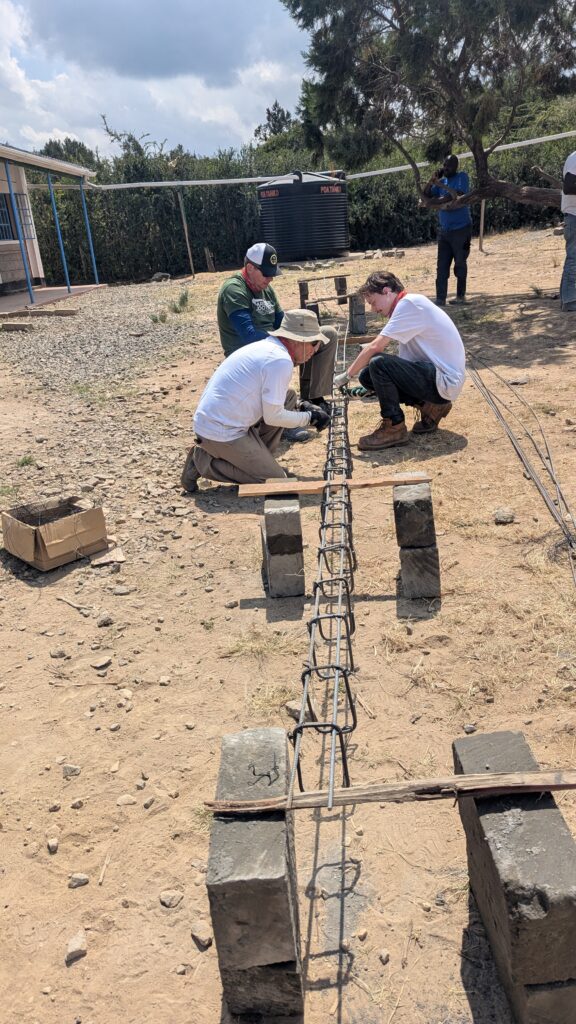
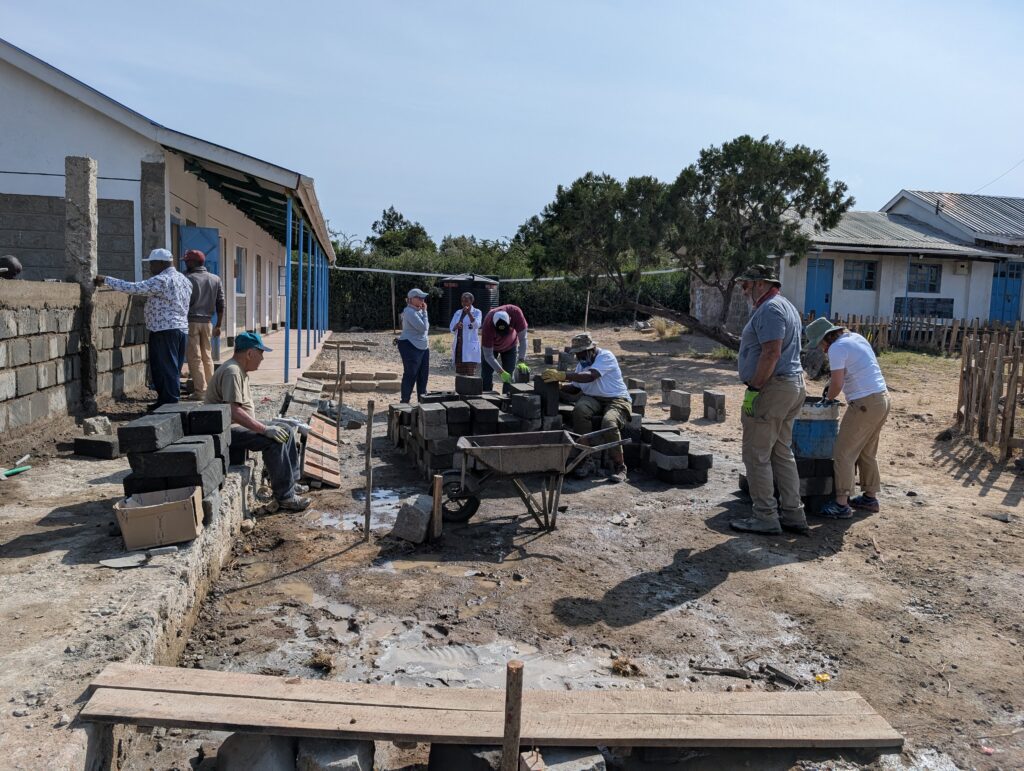
For lunch, we had spaghetti with a chopped vegetable and tomato sauce base as well as cut fruit.
Mark worked with Joseph in the afternoon filling the mortar gaps in the stones while DT worked with Hollis and Symon the the rebar cages, twisting wires to complete the long, single piece.
The rest of us worked on completing stone washing as the end was near. Yami was working on one pile, as were Becky and I while Beef, Kat, and Isaac did the final washing and stacking. Kate moved to the rebar and cut wires for the twisters.
By about 3pm, we finally completed washing the more than 750 (according to Symon) stones. It felt great to complete such huge, tedious task. Becky and Kat had, in particular, been working on that part of the project since the very beginning and they were both proud and relieved–and covered with dust and mud–to be done.
By 3:30, I moved over to the rebar DT and Joseph had finished one half of the cage assembly with some help from Hollis. Now, more of us moved in that direction to compete the whole thing. Again, the work went very fast and we finished well before 4pm.
By then, the team had begun the clean-up, putting away tools and preparing for three days off. Several of us spent time talking with the kids, and I walked over to see a coach teaching a group of girls how to bump a volleyball. We took more photos and talked with the kids. Kat and DT received hand-written letters from a few of them.
They were disappointed that Kat, Beef and Ginger were leaving and not coming back next week, but we told them that the rest of us would return on Monday after our weekend in Samburu.
We all took a few more photos and then Symon gave us his usual end-of-day status report and pep talk. He said that next week would be pouring the reinforced concrete ring and then setting two more courses of stone above that, as well as completing the table on one end. Becky asked if we would be building the rafters, but he wasn’t sure that that was part of our plan. The foreman would have to weigh in on that.
We left at about 4:20. We’d had no rain today despite variable clouds all day. The drive back was uneventful and quiet, as usual.
After our showers, rain was threatening and it was a bit cooler outside. Beef and DT found seats in a private, round, indoor tent-like building with a fireplace and a very elaborate thrown-like chair made of twisted natural hardwood. We took turns having our photos taken in the chair as several of the others arrived and Beef and Kate had their first Boilermakers of the evening. The manager came to chat with us and said that he would have a fire set in the fireplace when we returned after dinner.
Dinner started with cream of mushroom soup that was very peppery. We also had fried tilapia, spaghetti, and green mashed potatoes. The wine was flowing again with a bottle each of Malbec and Cab shared around the table.
We talked about the plan for tomorrow. I’d set things up with the front desk before dinner. Breakfast would begin at the same time on Friday. Then, each of us would check out and settle out laundry and bar tabs. The hotel was nice enough to allow us to use a vacant room for storing our bags over the weekend and I was given a key to room 320, in the same gated “compound” as our current rooms. That meant that we wouldn’t have to schlepp our bags down to the reception area (about 100 meters) and then back again on Sunday. We could plan to leave early the next day at 8:30 for Samburu.
Mark was traveling on his own to Nakuru to visit the national park there and was helped by the receptionist to find a car to take him there Friday morning, leaving just after we’d planned to go.
At dinner, DT announced his “warrior of the day,” award for hard work and general gallantry at the work site. The previous three winners had been Kate (for overcoming nausea and digestive issues, but still “bringing it” at the worksite) on Monday, Beef for overcoming the altitude (that really hit him on Monday) to perform well on day two, and Yami on Wednesday for overall toughness at age 84.
Tonight’s winner was Katja for, along with Becky, working constantly at scrubbing the huge piles of over 750 cut stones over four days and seeing it to its end. She has really done an amazing job doing very tough and tedious work and has been a huge part of the team, in general. She’ll make an excellent team leader for future DWC projects.
After dinner, we went back to the room with the fireplace for more stories and conversation. Kate told two riveting stories about her younger years in Los Angeles when she was stopped by police while driving, but really because she was Black. The stories were from 49 years ago, but seemed timely given recent events in the US.
We left the fireplace room just before 9pm and went back to our rooms to pre-pack for the next day.
Friday 20 June 2025
As Becky and I were packing before breakfast, I realized that I couldn’t find my passport. I didn’t remember getting it back from the reception while checking in, so, after searching my camera backpack, where it is usually stored, and coming up empty, I went to the reception desk.
They assured me that they had returned my passport, so I went back to the room and tore through the bags again. This time, I found it in our large blue Osprey bag. I now remembered that on Sunday, Kat had brought, as a gift from DWC, a labeled bag tag and a leather passport wallet. I’d put my passport in the wallet and then thrown it in the bag–in its usual place. My panic subsided and I could enjoy breakfast.
The team straggled in for the usual breakfast. Beef and Ginger said goodbye to the staff as they would not be returning for the second week after Samburu. I asked for large one liter water bottles to go for each of the team members.
Everyone was on time, room 320 was loaded with bags, and we were moving by 8:35am. As we were driving, we noticed that we could finally see the peak of Mount Kenya through the haze and glare of the low Sun. Kat was happy to finally be able to see it.
About an hour after leaving, we passed through the larger city of Nanyuki and then into Meru County. Along the route, small shops of every kind lines the highway. Most had homes behind the front commercial building where to proprietors lived. Cattle, sheep, and goats were almost everywhere on the roadside, even in downtown Nanyuki.
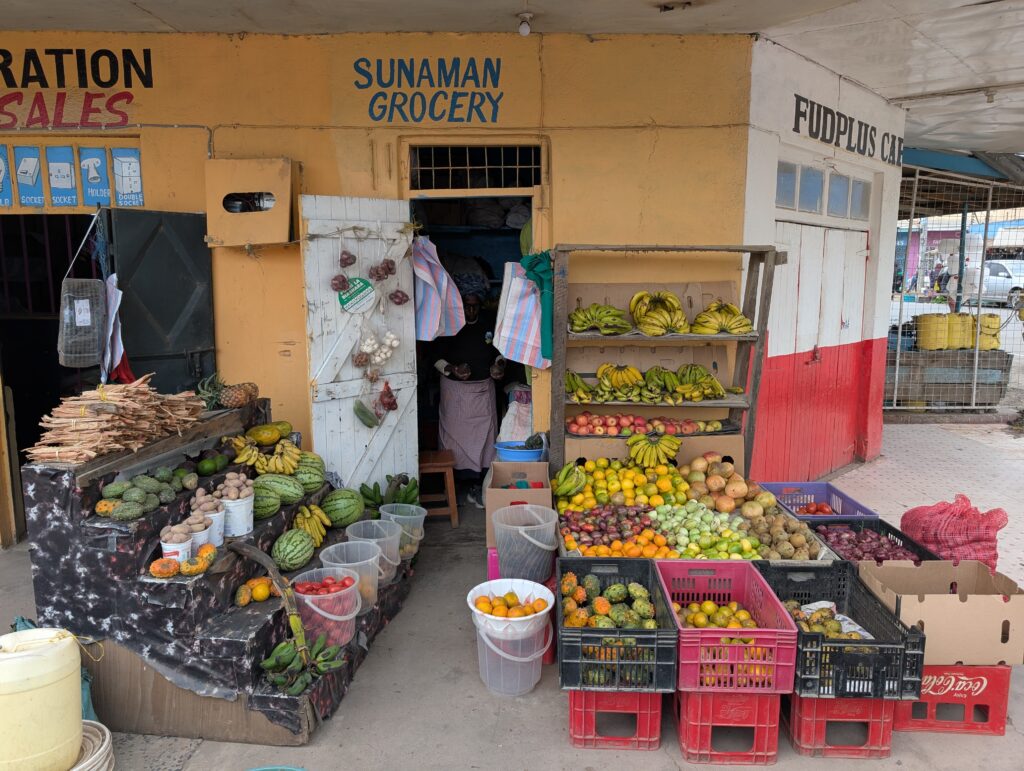
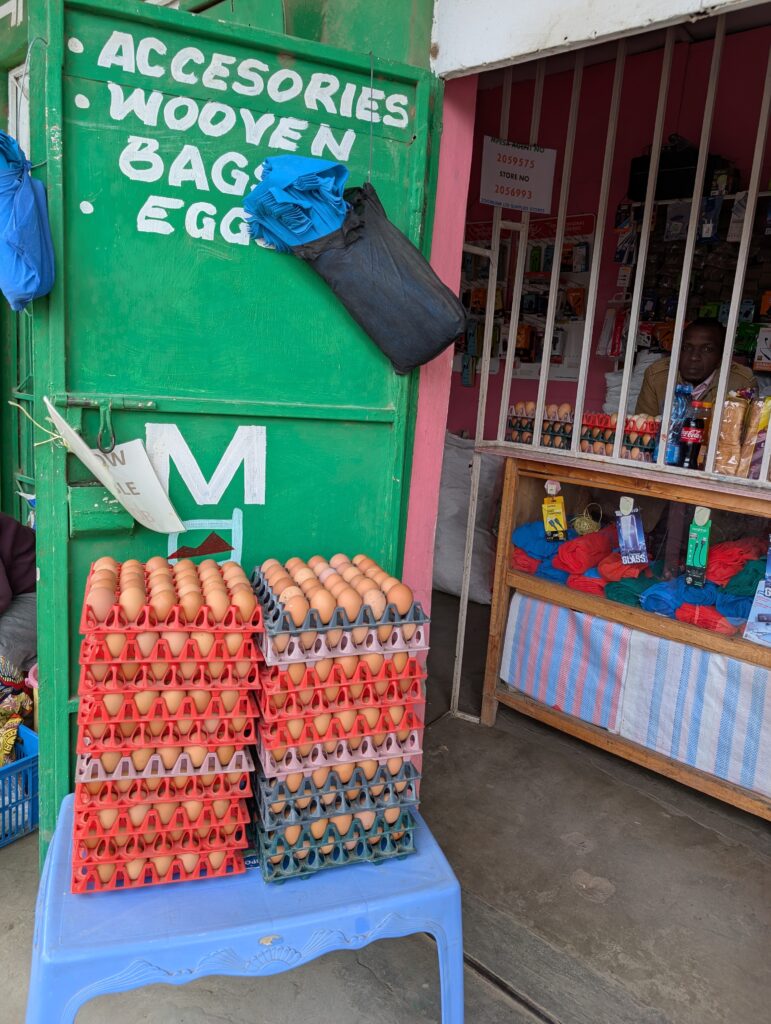
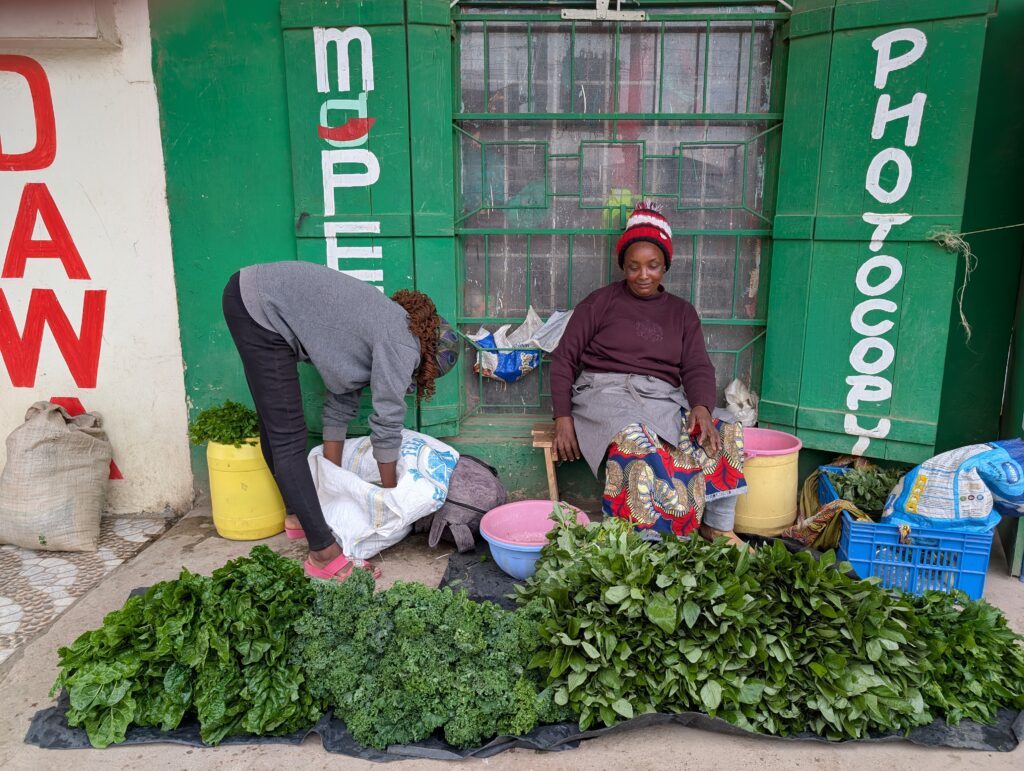
We stopped at a curio shop and cooperative to use the restrooms and do a little shopping. The prices were ridiculously high. Becky wanted five refrigerator magnets and the first price ordered was the equivalent of $120. Yami tried to do the same as was quoted $25 per magnet. Kat bought a few bookmarks and small items, as did Hollis (a carved back scratcher) but I did not ask the prices they paid. It was clear that this was a standard safari stop where they counted in tourists to just pay whatever price was quoted in Kenyan Shillings without checking the true price. When asked to negotiate, they would not come down more than about ten percent either.
As we left town we began climbing, eventually reaching almost 8500 feet in altitude. The air was very cool and the highway was lined with greenhouses for herbs and flowers as well as agricultural fields growing wheat, corn, mustard, sunflowers, and lumber (pine, cedar, eucalyptus).
After reaching 8480 feet, the descent was very fast and steel. We could see the brown valley below us and in just a few minutes we went from misty alpine weather to a more Southern California or Mediterranean landscape. There were no longer wheat fields and now, at 6000 feet and below, we saw tall cactus, acacia trees, dried brown grass, tall agave or century plants, and herds of goats grazing.
We stopped for gas (petrol) in Isiolo, a larger town that was lined with market stalls. Isaac pointed out new construction of a very large building that would house the market in the near future. Now we began to see tuk-tuks in addition to scooters and more of the population appeared to be Muslim based on the dress of both men and women.
I’ll write about our safari later and include photos. For now, though, we reconvene on Monday for week two of our efforts.
Monday 23 June 2025
With Beef, Ginger, and Kat safely arrived in Nairobi last night after our safari, and ready for their departing flights Monday night, we loaded into the vans on time and the remaining seven of us departed on time.
Yami brought a bag of used crutches, canes, and walking sticks from Canada to donate to a local charity. He’d spoken with Isaac who said that he would take them to an appropriate organization with Yami today.
Beef, Ginger, and Kat left some things for us to donate to the workers, school, and others–leftovers that they did not want to transport back.
The weather was the same as we’d seen on the other days with low clouds burning off. I was surprised to see Isaac who had driven back from Nairobi already after dropping the three at the Lotos Hotel. He said that he left Nairobi at 5am to get here by 7:45.
We were all recharged from our safari weekends. Mark enjoyed Nakuru and had a chance to see something there that we didn’t in Samburu: lions!
We were all concerned and worried about the growing conflict with Iran and had received warnings from the US State Dept via our travel alert messaging set up before we left. These warnings were global for Americans and locally here in Kenya we were warned of nationwide demonstrations on Wednesday protesting police brutality, specifically in Nairobi.
When we arrived at the work site, it was cool and cloudy. Symon briefed us that today’s goal was to put the top concrete ring frame around the top of the structure. We would finish the reinforced concrete caging, too. That turned out to be more work that we expected, especially with our smaller crew.
Yami and Kate went with Isaac to the local orthopedic treatment and rehabilitation facility for kids. They received a tour and explanation from a nun there and were quite impressed by the operation.
At the work site, we retrieved more boards for the concrete framing, more rebar, and plenty of tools. We all started on the rebar, but Mark was called away to chip concrete from the pillars to make them flush to the stone walls for the concrete frames.
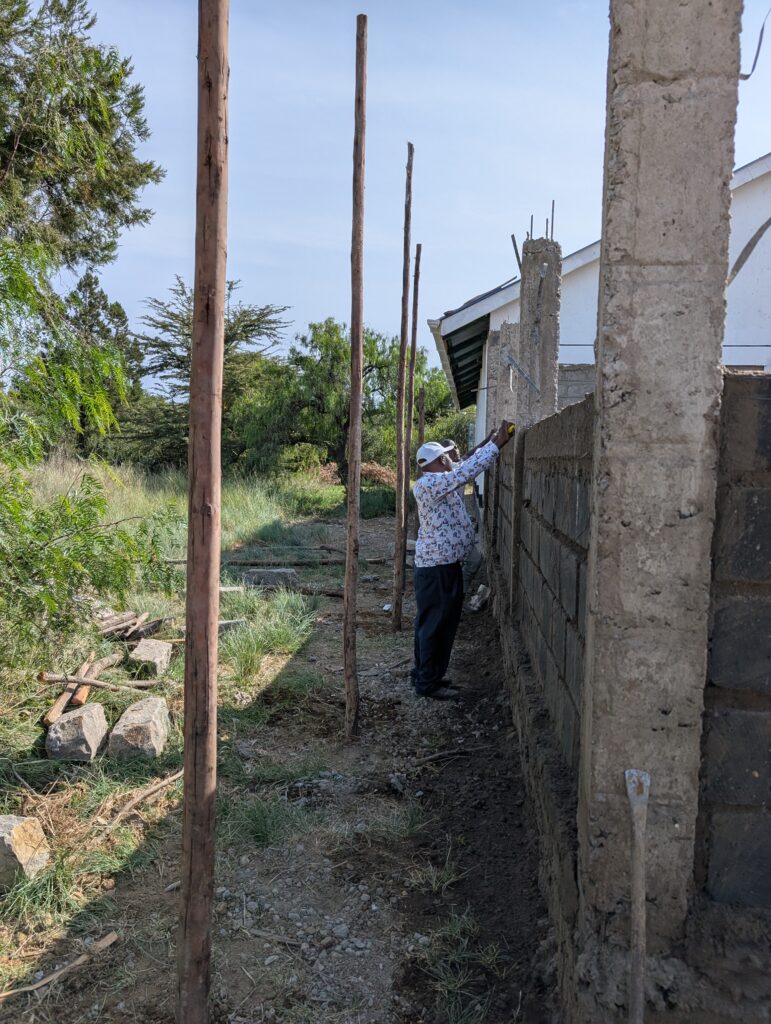
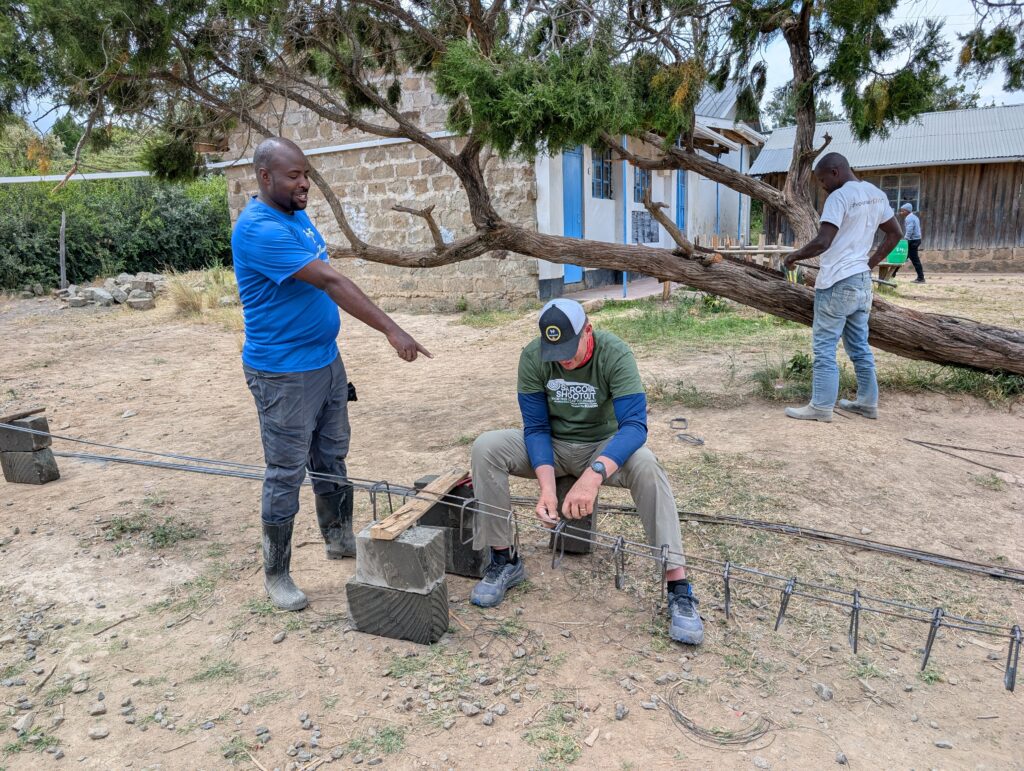
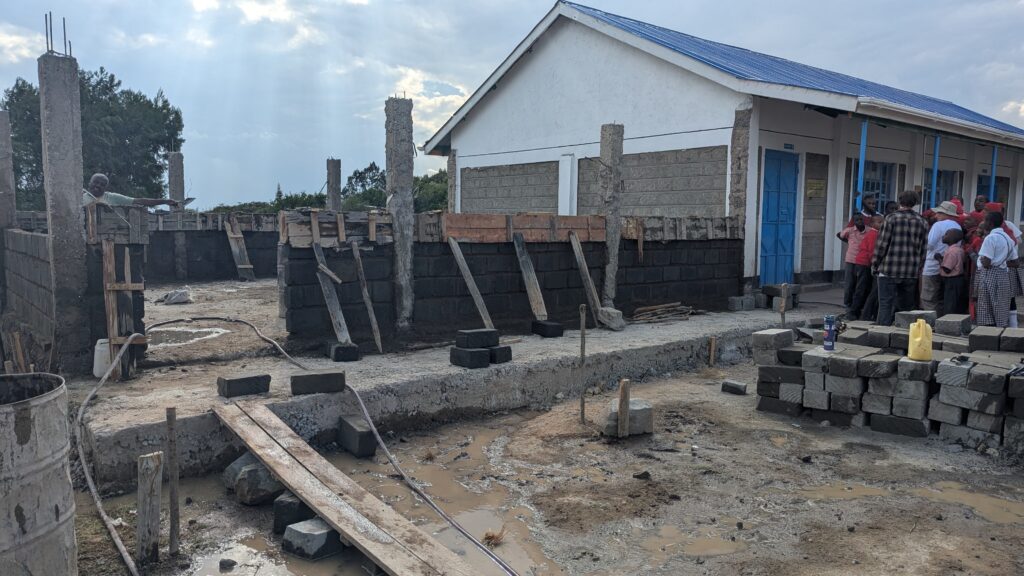
We cut more rebar for the cages as well as wires for twisting. The large, long three pieces included two bent at a 90-degree angle to slide into the outer corners of the building.
Becky went to the lunch area and helped dish out ladles of porridge for the kids’ lunch. They could get a half or full pour and there was enough for seconds.
At tea time, I spoke with Jennifer, the head teacher, and Jane, the principal about the following days. They said that tomorrow was the kids’ last day before a break and that they wanted to say goodbye to us after tea time on Tuesday. Since this is a Catholic school, they also said that they would be celebrating a mass at 8am Tuesday and we were welcome to attend.
I told the team of the plans and Kate said that she wanted to attend the mass and would be ready to leave the hotel at 7:15am. Others might join her, too.
The rebar work continued with Hollis cutting wires and DT and I cutting more rebar for cages.
I took a break and spent about 45 minutes in an eighth-grade classroom to talk about space. I talked about the size of the Earth, gravity, and other aspects of space then opened it up to questions. The kids had lots of good questions about rockets, planets, the Sun, and many other things. I was impressed with the curiosity and willingness to ask questions.
I returned to work and we finished the cages before lunch. At lunch, we had green lentils in coconut sauce, rice, cooked onions and spinach, chapati, and watermelon.
The Sun came out and it was was much brighter. The lunch break went a bit long, but we were back to work by 2:15pm.
Our final work of the day was helping hoist the rebar atop the walls and within the form channels being assembled. The long, bent cage structures were heavy and awkward, but with about eight of us we were able to get them in place. Mark, Isaac, and Symon used wires to splice together the three pieces while the other locals were securing and finishing the forms.
Then Symon called for curing the walls and we all pitched in to fill buckets, pass them around, and wet the walls. We finished on schedule and on task, leaving right at 4pm. We knew that the next day would be filled with concrete mixing, lifting, and setting within the forms. Once that work is done, though, we’ll be done for the day because nothing else can be done before that pour is set overnight.
Back at the hotel, we met for happy hour after clean-up and had the usual political and other discussions. Beef sent photos of their day in Nairobi touring the Nairobi National Museum. They were all three departing on late night flights Monday and were happy to have a chance for more touring before departure.
At dinner, DT gave his daily warrior award toast to Becky for her willingness to step into any job and for being the “glue that holds the team together.” We adjourned a little earlier than usual, anticipating a big day on Tuesday. Before leaving, though, Mark and I talked about meeting with John the foreman to see if we could get started on the rafter trusses on Tuesday or Wednesday. We thought that without that task, we may not have enough to do to keep us all gainfully employed and working until Friday.
Tuesday 24 June 2025
I felt a cold coming on (scratchy throat and some sinus issues) so I took some meds overnight and in the morning. It certainly was nothing severe, but I wanted to catch it early before it goes worse.
I arrived at breakfast early and met Yami and DT there. DT was joining Kate and me on the early bus to the school for the end of exams Catholic mass at 8am. We rejoined in our compound parking area and left with Isaac at about 7:20.
There was a heavy dew on the grass and the temperature seemed colder. Clear early skies fogged over, then began to burn off as we drove through Naro Moru.
When we arrived at St Michael Marcharia Comprehensive School, the Catholic mass was already underway. Everyone was seated in classroom chairs assembled in the common area between classroom buildings. The attendance did not seem to include all of the students as the number seemed much smaller than what we’d seen on previous days with school in session. There were several adults there, presumably faculty and staff.
The children were singing a low chanting verse that seemed repetitive. Kate, DT, and Isaac took seats in the back. I used the opportunity to walk around and take some photos of the empty classrooms, buildings, and our construction.
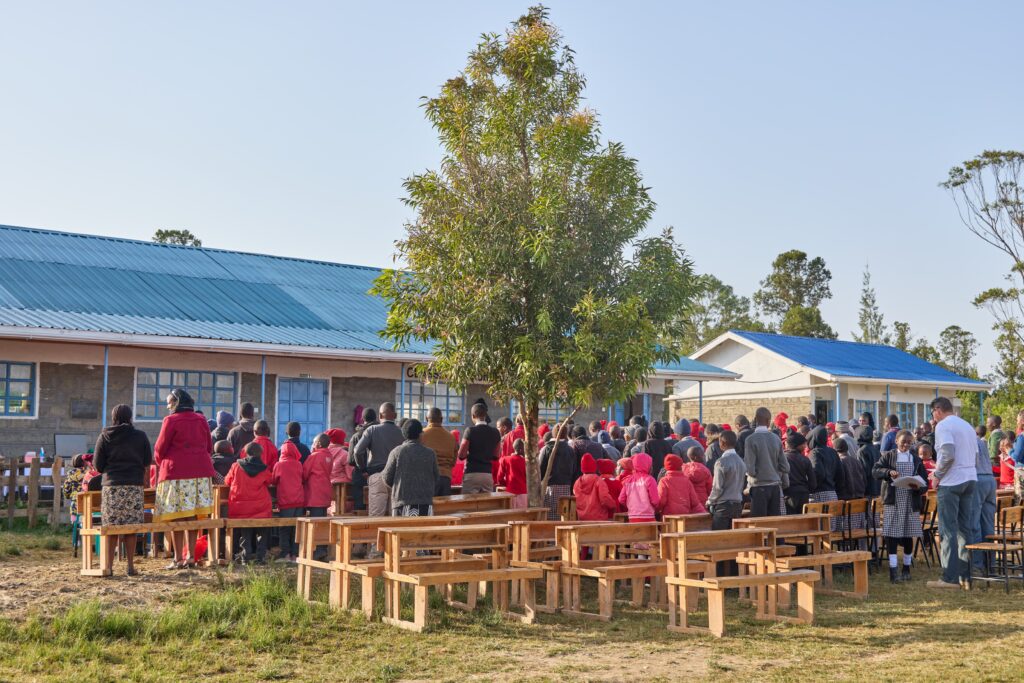
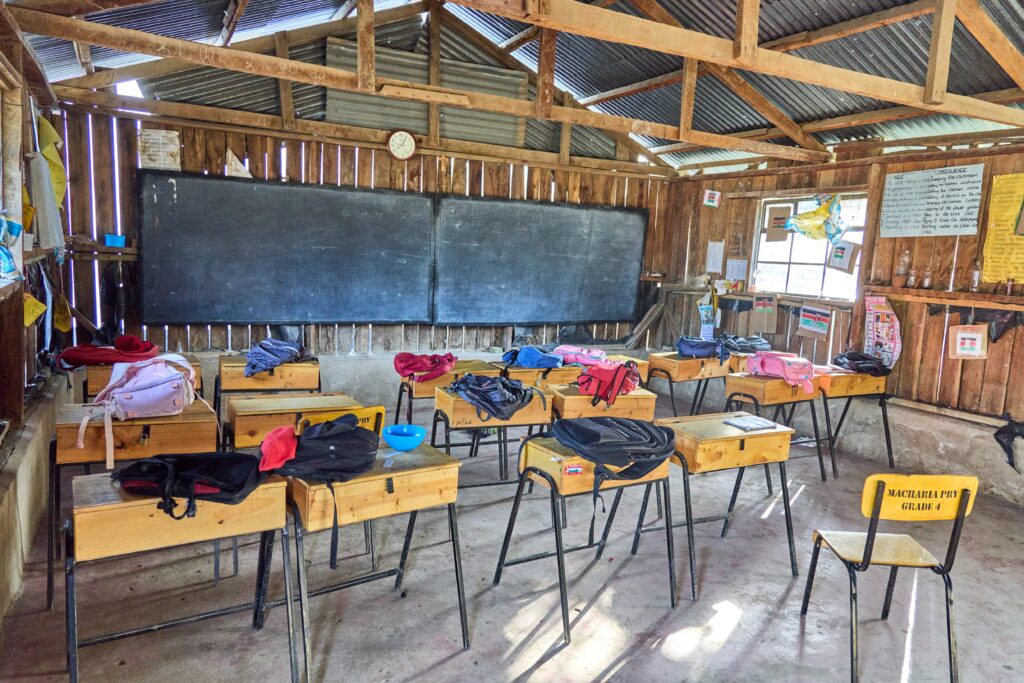
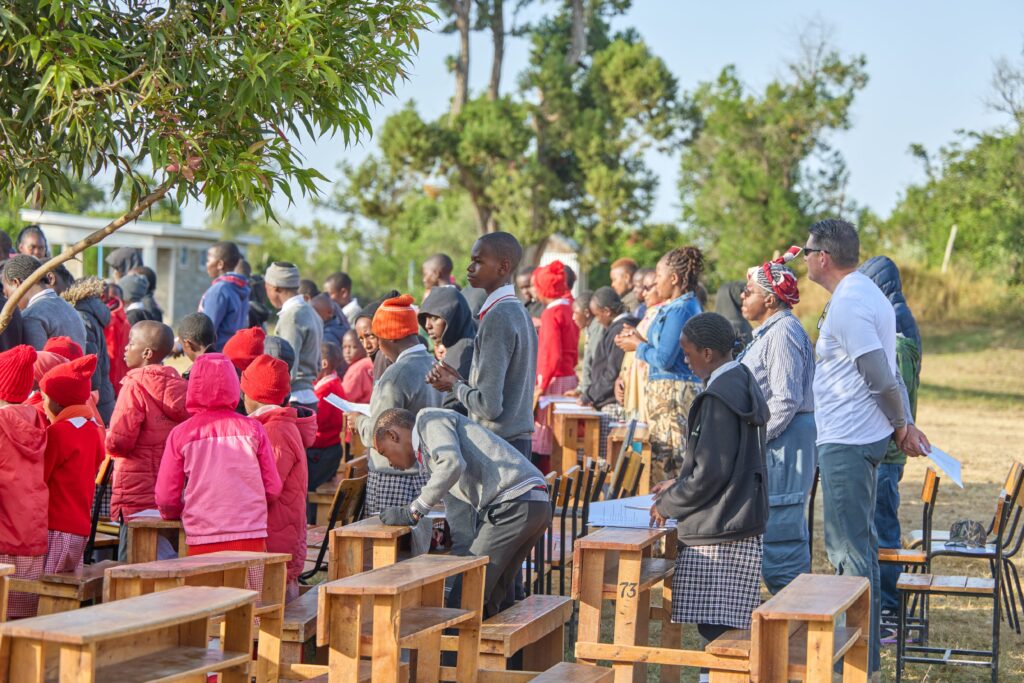
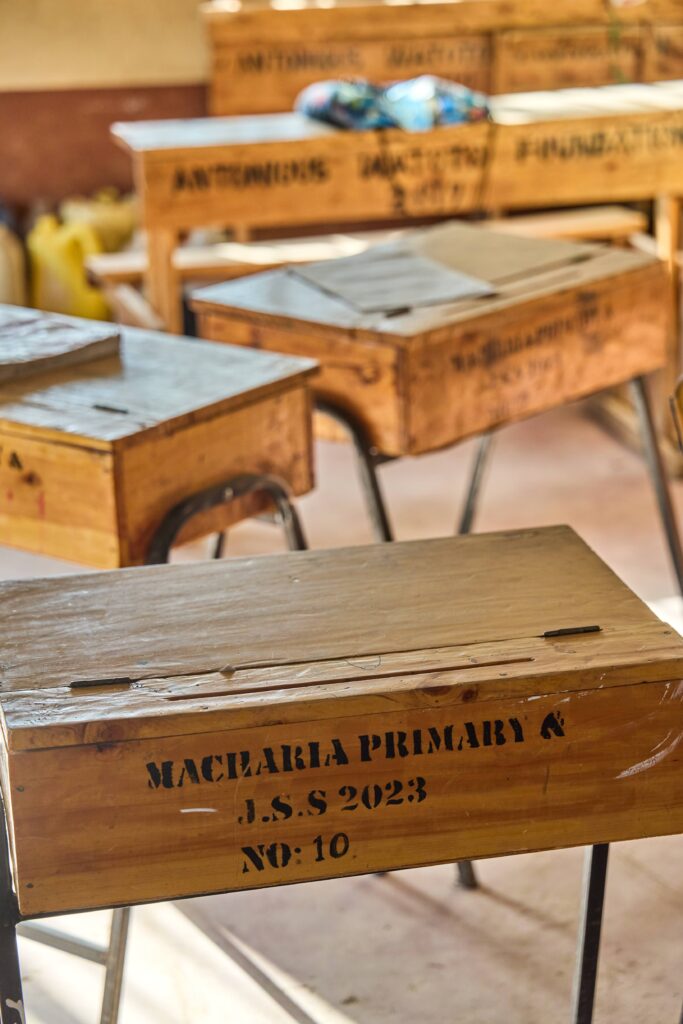
The service began in earnest with a couple of songs sung in Swahili with all standing. Three students did Bible readings in English and then the priest did a gospel reading focusing on John the Baptist followed by his sermon on the same subject. He alternated between English and Swahili throughout the service and the students responded sometimes in English, others in Swahili.
The sermon continued with a focus on education and it’s importance–appropriate given that the students had just finished their national exams and were preparing for a few days of break.
During the sermon, Symon arrived on his motorcycle. He had large yellow buckets strapped to his motorcycle. They were really the cut bottoms of large yellow plastic vegetable oil jugs. I presumed that we would be using these to lift concrete into the top ring forms later in the morning.
The priest spoke for well over 20 minutes, during which time the second van also arrived. The other workers weren’t here yet, so we had no choice but to wait until the mass was complete before doing anything.
The congregation seemed to be growing restless as several kids got up and ran around the back of the group, probably to go to the bathroom.
Finally, the service was over and we could get to work. We brought bags of cement and tools from the storage area using the wheelbarrows and the locals put the finishing touches on the top ring forms while we brought five loads of sand into the room’s interior for mixing. Once that was complete, we worked on wetting the walls again, inside and out, to cure the concrete.
Then the mixing began. We started by spreading the mixed sand and concrete into a wider area than usual and then brought in five loads of rock that was dumped on top. Now, we could quickly mix sections of the flat, rock-covered concrete quicker with water without disturbing the entire pile. Kelvin led the charge on the ground while Joseph and Symon worked on dumping the concrete into the forms. We formed an assembly line of sorts with Isaac and one of us shoveling concrete into buckets and then the others moving full buckets forward and up to Joseph and Symon as well as passing back the empties. We needed a stand three blocks high for the final lifter to hand the heavy buckets up to the top of the wall.
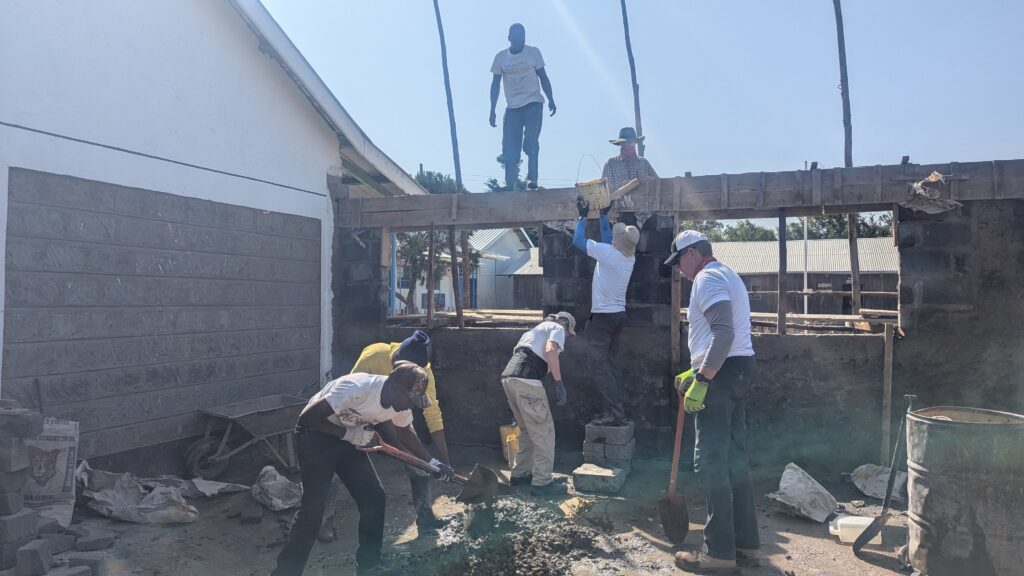
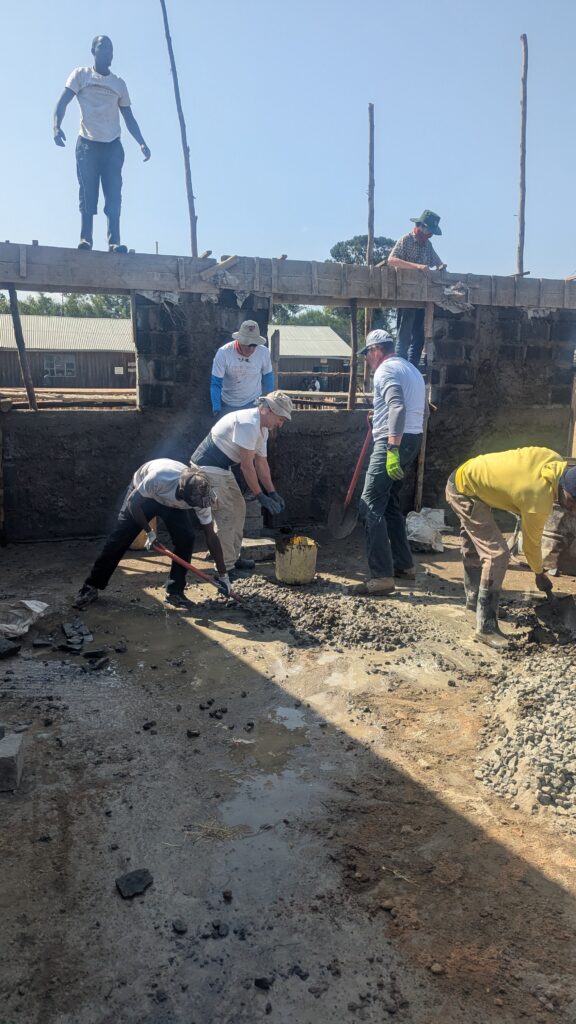
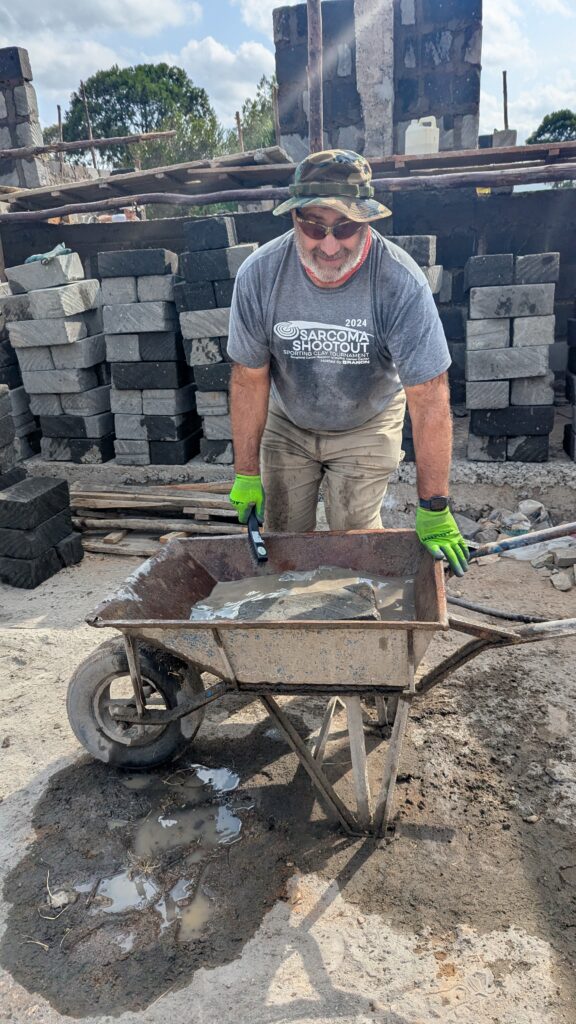
Once a section was filled, Symon and Kelvin fired up a small gasoline motor that powered a large steel vibrator that was used to work the air, water, and voids from the poured concrete. This caused water to come out of the cracks in the forms, cascading down the sides of the walls. We’d plugged most of the holes with pieces of empty cement bags, but still some leaked.
We moved very quickly and were half done by tea break. At 10:30.
Shortly after 11am, as planned, the head teacher and principal call all the kids into the center courtyard for the planned farewell. The head teacher, Jennifer, is really full of energy. She led the kids in some songs first and then the deputy head teacher came forward to give a prayer. The prayer lasted about 10 minutes, but seemed like an hour. Some of the kids kept their eyes completely shut in full prayer mode the whole time. Others were not so serious and I smiled and winked at several of them.
Next, the principal came forward with some very nice words of thanks to all of us and to present us with a carved wooden piece of a mother and a baby elephant along with a heart that said Machiara School 2025. I asked that she present it to Kate and we took a few photos as she did. They unfurled a banner thanking us, too, and then a group of students came forward to recite a poem thanking us for our work. It was all very touching and heartfelt and I know the team was overcome–several had tears in the eyes.
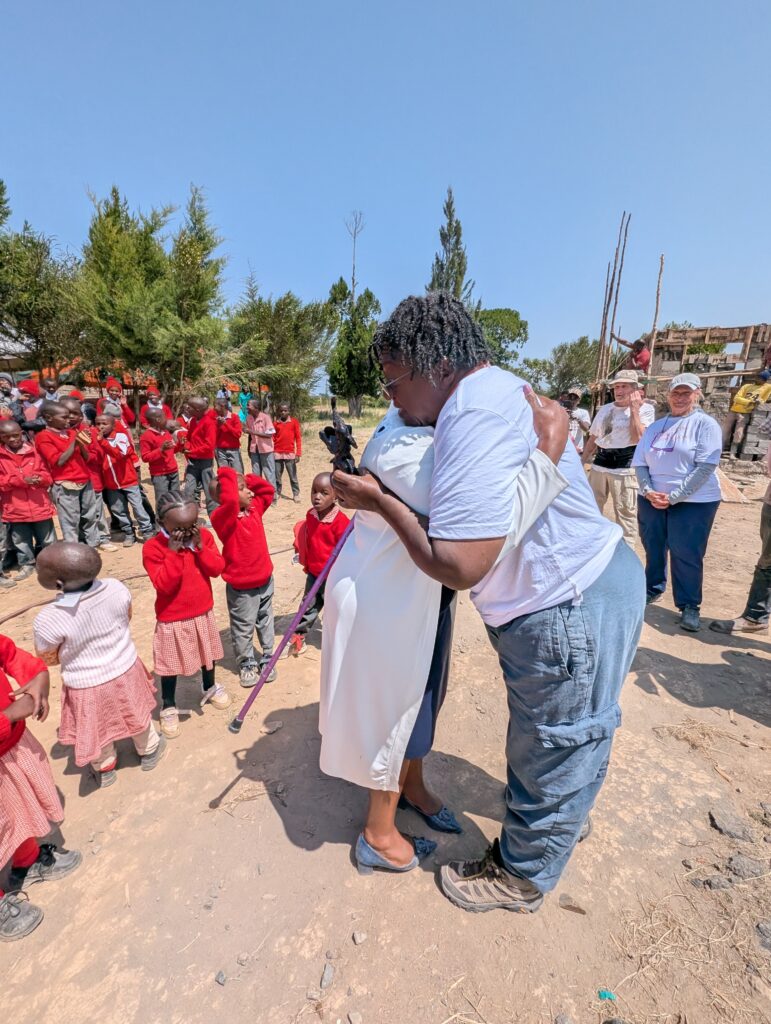
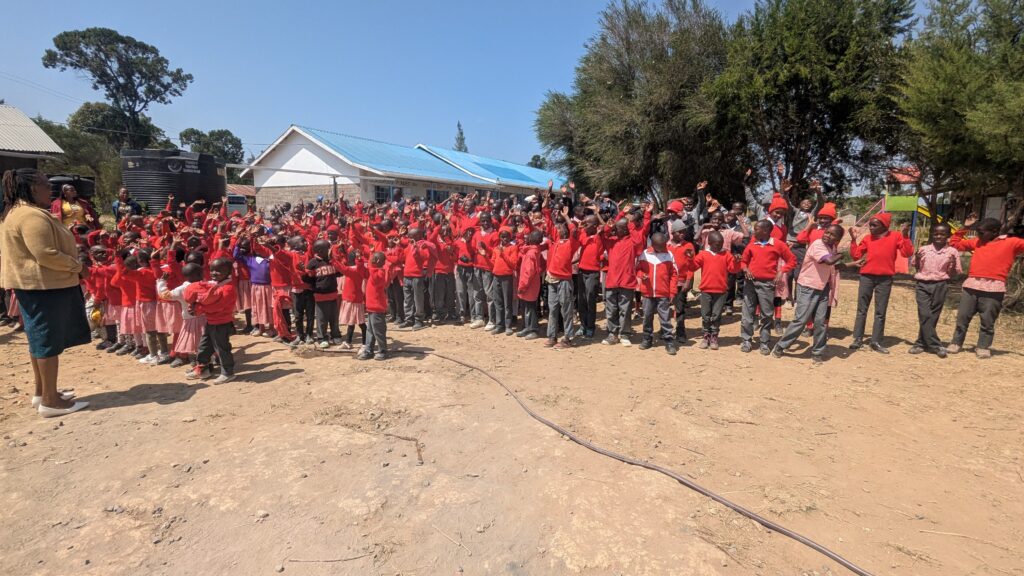
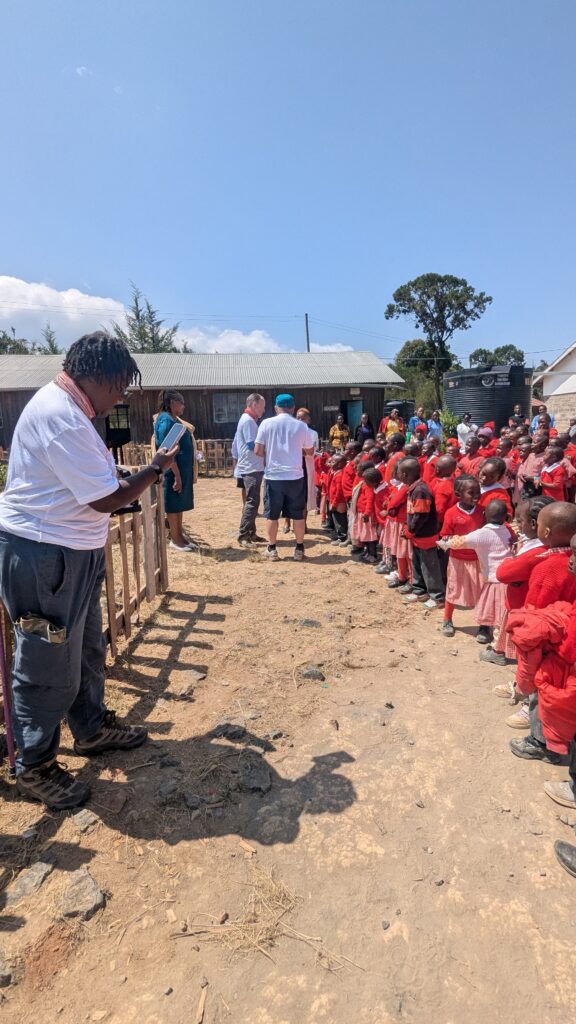
I said a few words of thanks and then Yami came forward with some gifts for the school including coloring books, pencils, markers, and crayons that the principal accepted. We were done by about 11:30am and went back to work. We mixed more concrete for the forms quickly and restarted our concrete bucket brigade. Symon and Joseph were working fast up above and we were done with all of the work by 12:45.
There was nothing left to do now except cure the concrete on the walls one more time with water. Mark and I had talked to Joel, the foreman, shortly before the school assembly and asked if we could start on the wooden rafters and trusses tomorrow. That would give Kate, Becky, and Yami something productive to do as they could stain the wood and start cutting it, too, while the rest of us mixed concrete and set stones above the reinforced concrete top ring. The latter work involved some pretty heavy weight plus the need to be on the scaffolding up quite high. The work would only get tougher after those two courses were done because that left only the gable on the south wall. To complete that, higher scaffolding would have to be assembled, too.
Joel told us that he couldn’t move forward on the trusses until Nderitu authorized that work. So, I sent a text message and email to Nderitu–who is back in Colorado–hoping that he would approve the work and we could get started on that over our last three days.
We went to lunch and relaxed in the shade. Lunch was late, not arriving until almost 1:30pm. We had chicken, fried potatoes with onions and green peppers (which they call “potatoes lyonnais”), mixed vegetables, “African mix,” (mashed potatoes, corn kernels, and spinach), and fruit.
With nothing left to do for the day, we left the work site at about 2:15 and came back to the hotel. We agreed to meet at the usual happy hour time and place after getting some rest after a lot of work hauling, mixing, shoveling, and passing a lot of concrete–not to mention curing the walls two times.
The hot water wasn’t turned on yet, so Becky took a cold shower. I decided to try out the swimming pool and met Joseph and Isaac over there. The pool was very cold–probably only about 68F (20C). I went in twice while Isaac, but not Joseph, also dared the cold. After two dips, I was done and went back to the room to write and do more cleaning.
We met at the usual time and place for happy hour and we’re pleased to learn that Nderitu HD approved our request to start on the wooden rafter trusses. We discussed buying some extra saws and brushes and Mark said he would buy the saws on the way to work Wednesday.
At dinner, DT crowned Hollis as our warrior of the day for his hard work helping the concrete mixing and movement.
Back in the room early again, I checked transportation options for Becky and me and our “after trip” to Zanzibar. It was then that I realized that I had never purchased our one-way tickets there–I’d just made a reservation (now expired) and not paid for it. It took a little time, but I was able to book the same flights through the Kenya Air website. I also used the “Welcome Ride” app to pre-book our ground transportation from airport to hotel.
Wednesday 25 June 2025
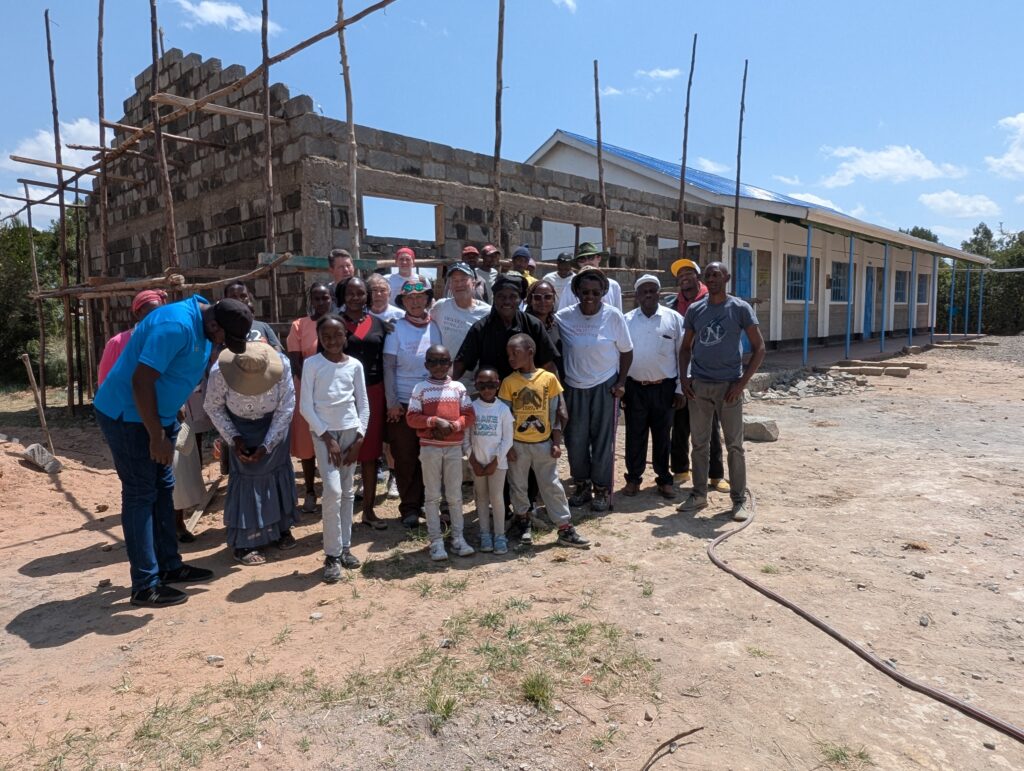
As we assembled to leave, Isaac told us that the wood for the trusses would be delivered today and that we could start work on them in the morning. He confirmed that the team had brushes to treat the wood, but that we would need to buy wood saws. So, Mark and Joseph’s van would stop in Naro Moru for those.
Yami decided to take the day off. He was feeling better, but didn’t want to overdo it. I think that he really wants to be at the school for the last two days and saw this as a chance to rest us and be ready.
We left right at 8am and were happily surprised to be able to see the summit of Mt Kenya for only the second time on our trip.
As soon as we arrived, we began taking the forms down from the now set reinforced concrete top ring. We took the forms, that doubled as scaffolding platforms and removed all of the nails from them and any other pieces of wood that held the form assembly together. We removed a LOT of nails. In Kenya, nails never die. They are reused, unlike every other piece of construction hardware over and over again. I’ll bet some of our nails are over a decade old and have been pounded into boards dozens of times. If they are bent, someone straighten them.
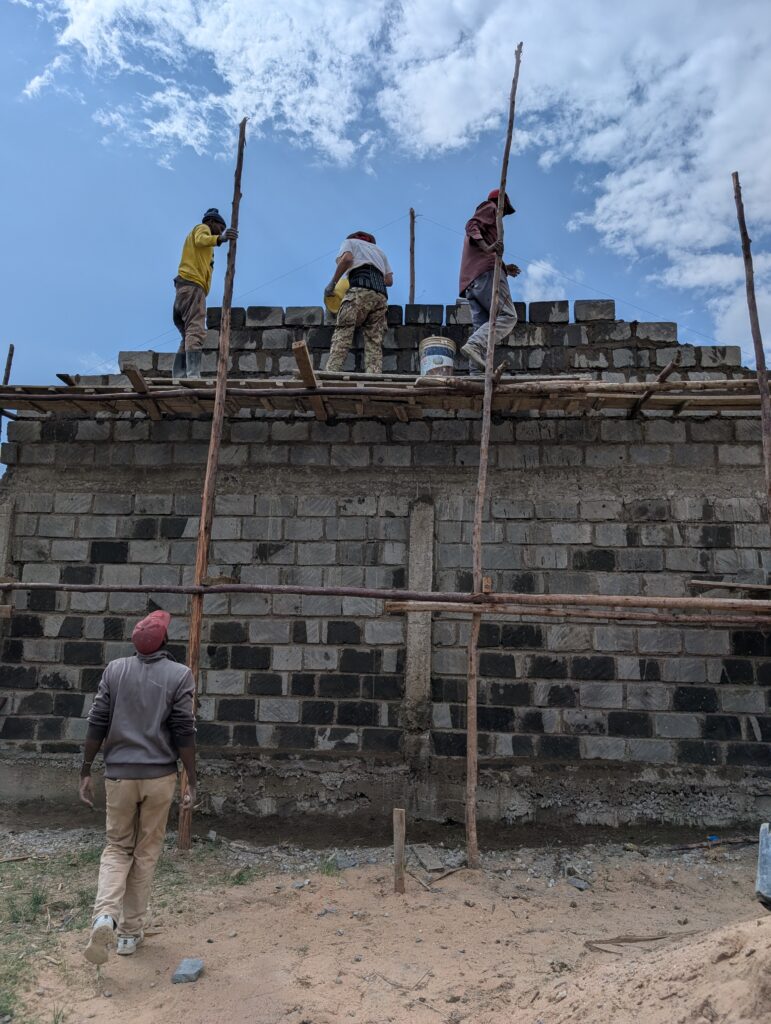
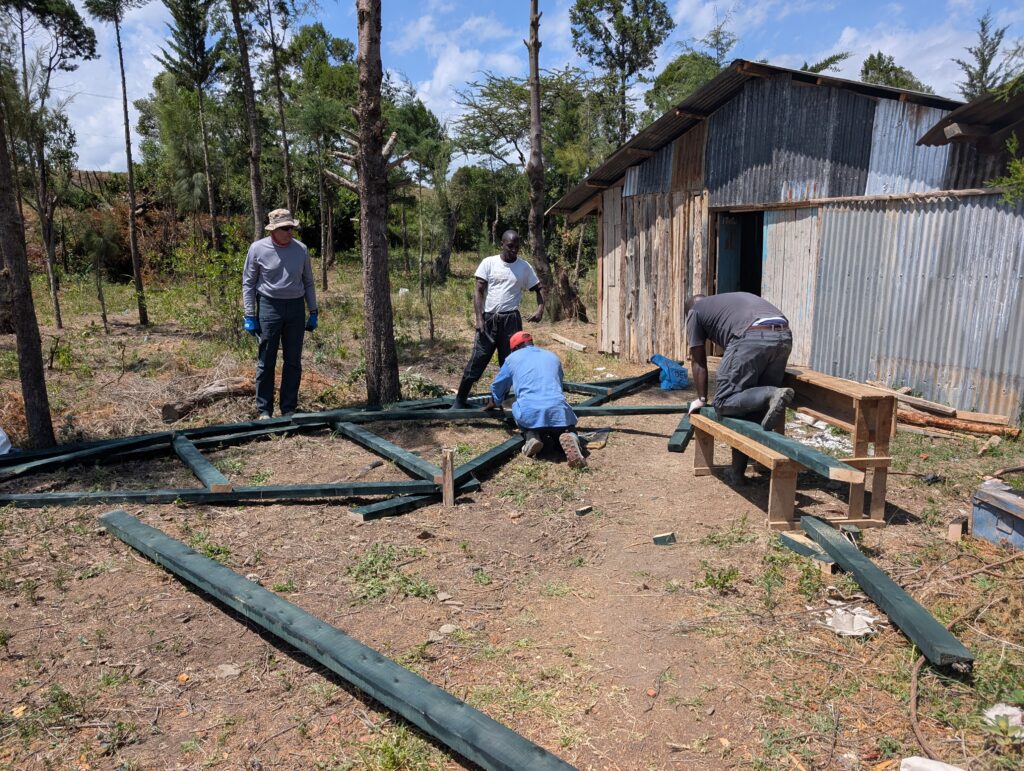
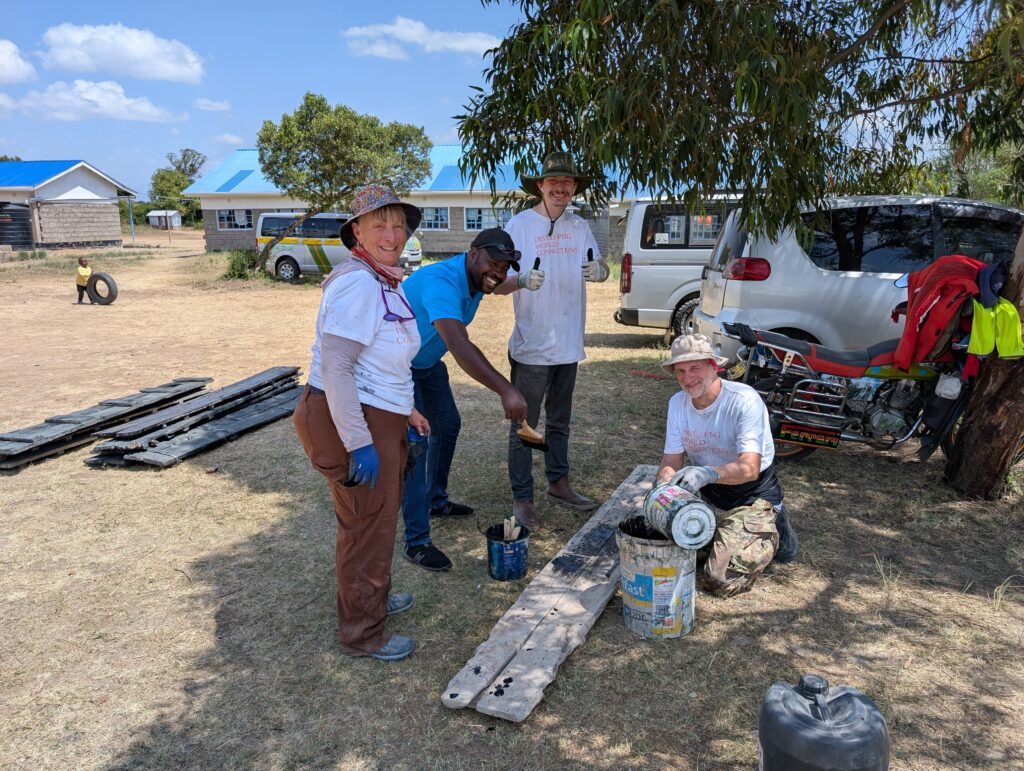
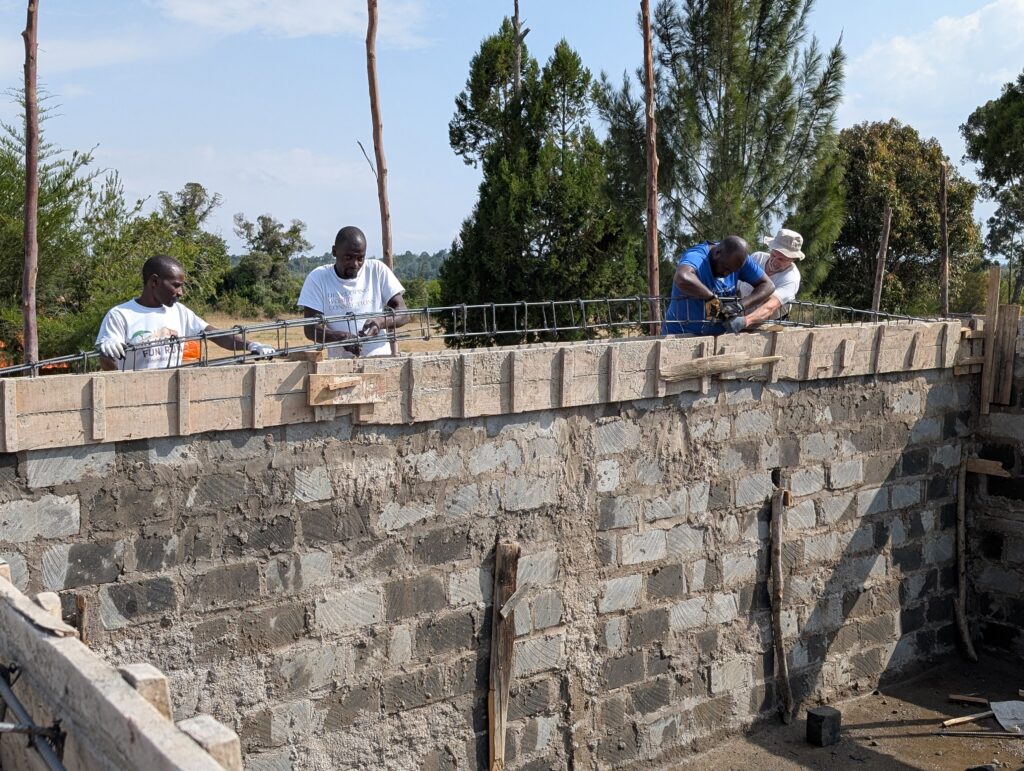
When the forms were off, we began curing the walls as usual. The school was eerily silent without the kids and seemed a bit sad. Soon after the wetting was done, we mixed mortar for the top two courses of stone.
Then, as if on cue, the beams arrived in a large truck–40 of them ranging from about eight to fifteen feet in length. We were given brushes (five new ones, shockingly) and then we set up stones like sawhorses, out the beams atop them and started painting.
By lunchtime, we were done painting all of the beams and the stone setting crew was about three-quarters done with their work. Mark was in the scaffolding with them filling the gaps in the set stones with mortar.
We had time to move all of our painted beams to the storage area that required quite a bit of cleaning and rearranging before we could stack the beams against one wall. I managed to step on a pointy-end-up nail that went through my shoe’s sole and punctured the bottom of my foot. It didn’t do very deep, though, and the pain wasn’t bad, so I continued to work hauling the beams to the shed thinking that I’d only have to worry if blood came out of my shoe–it didn’t.
Lunch was another mixed vegetable stew served over rice.
Immediately after lunch, more beams arrived including some very long ones that looked to be six meters or more in length. We knew that we would have to splice some beams together for the longest portions of the trusses, but thought these beams might be long enough to minimize that work.
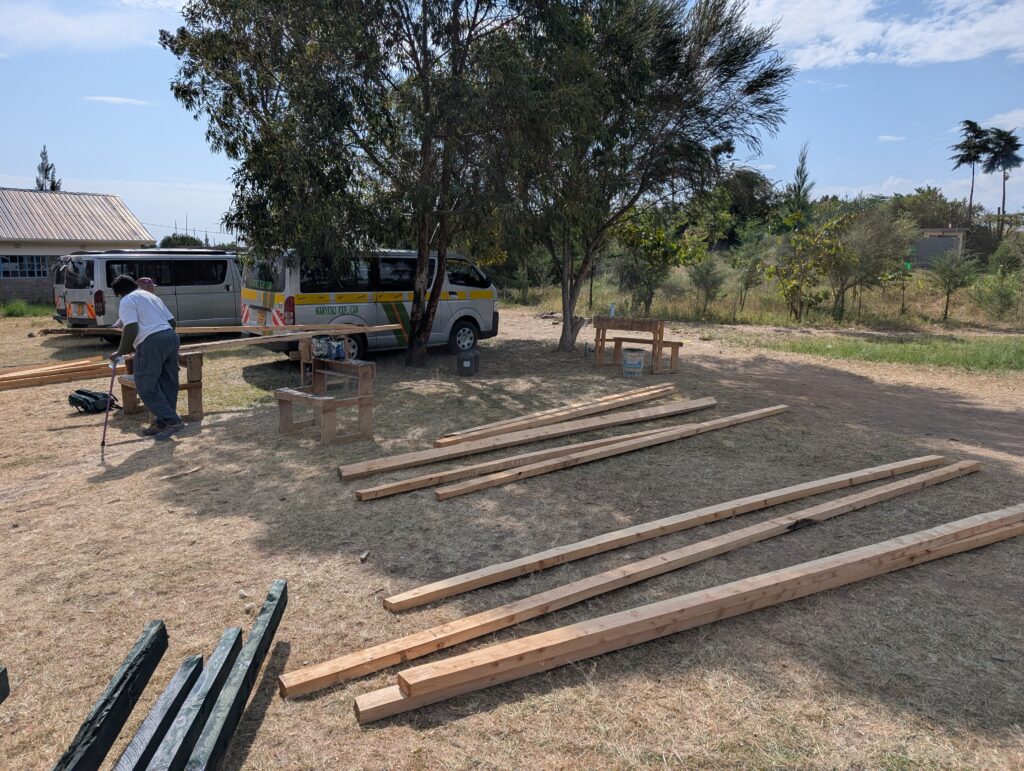
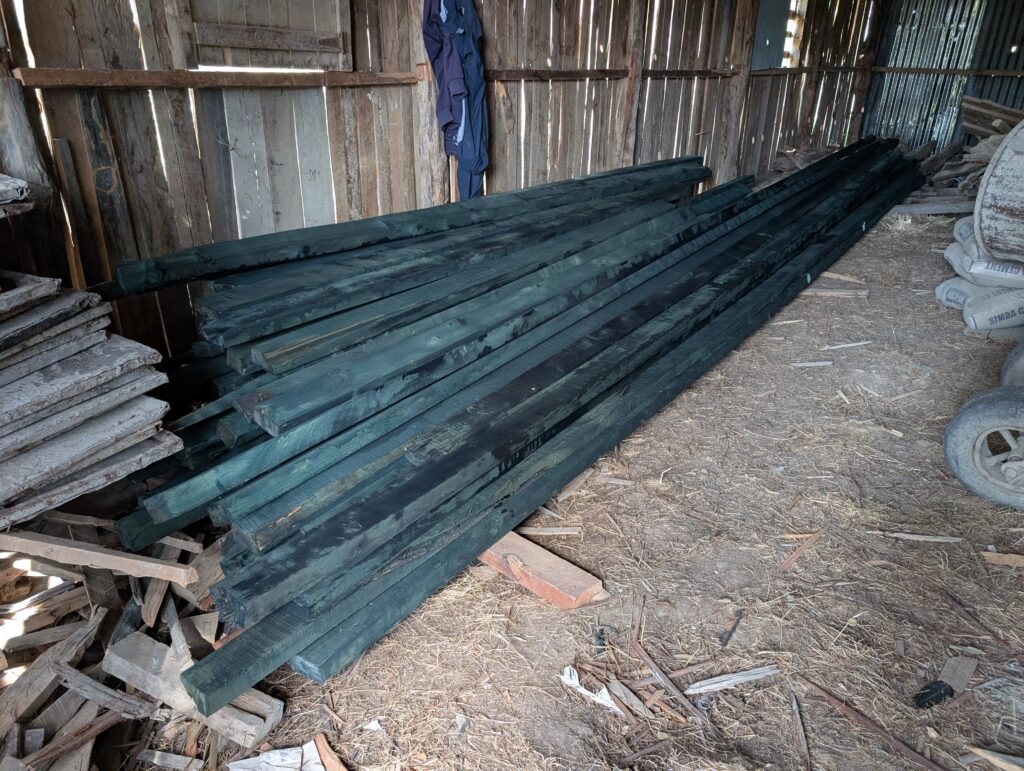
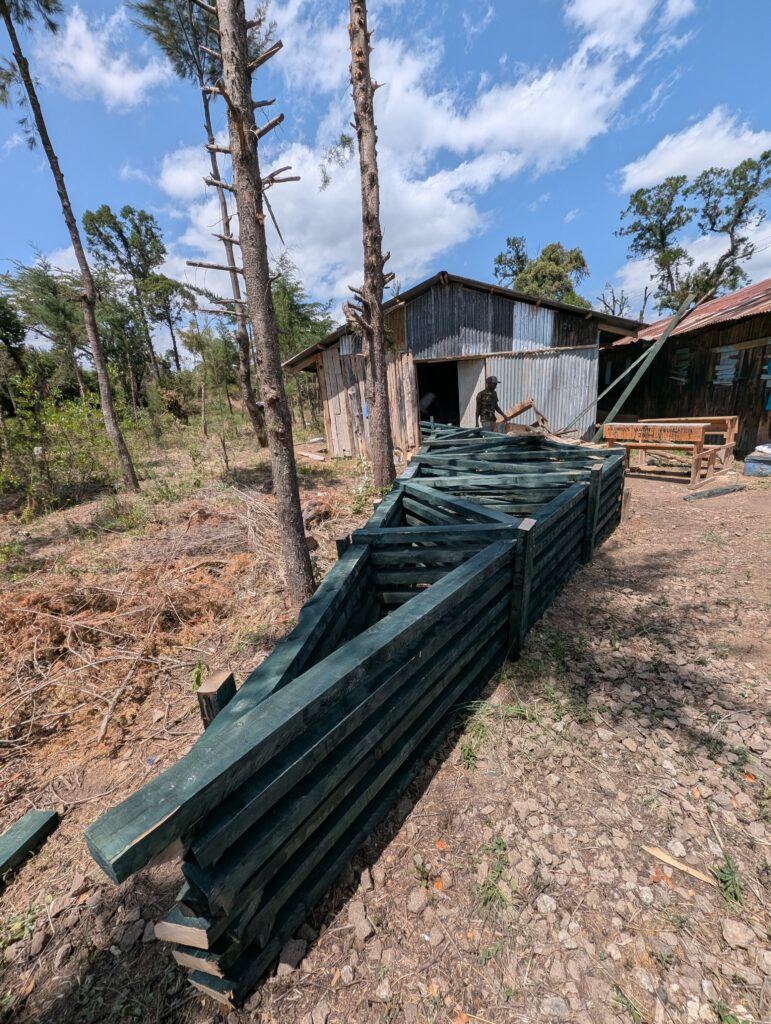
Nonetheless, Isaac worked on some steel banding that would be used in the splicing. He pounded nail holes through the one-inchwide band about every three or four inches. The band would be wrapped around the spliced pieces of wood at joints and then nailed into place as we’d seen done two years ago.
By 3:30pm, the stone setting was complete. We had worked through more than half of the wood painting in the afternoon and now it was time to clean-up. We put the painted beams into the storage area as well as the remaining 29 unpainted ones.
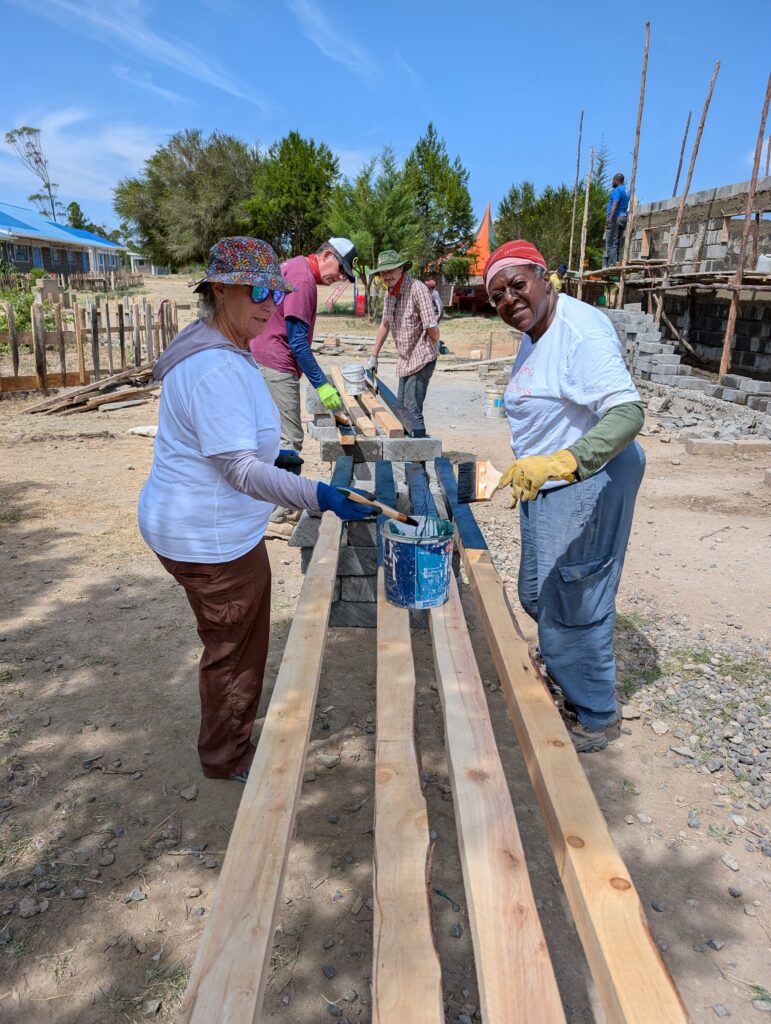
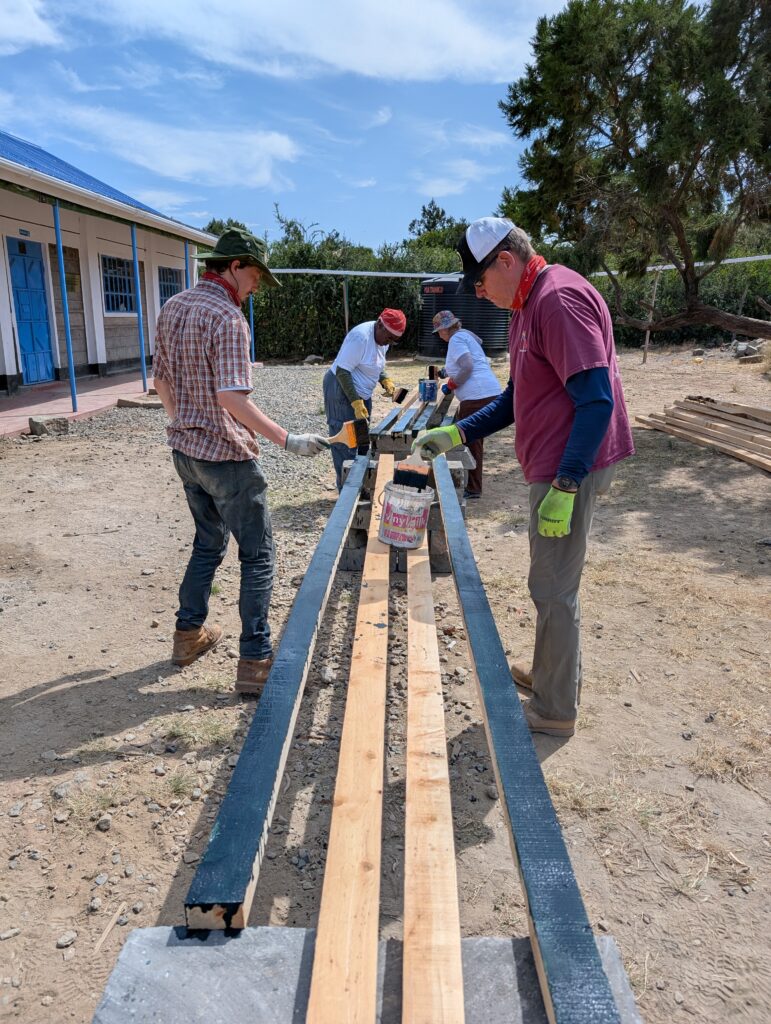
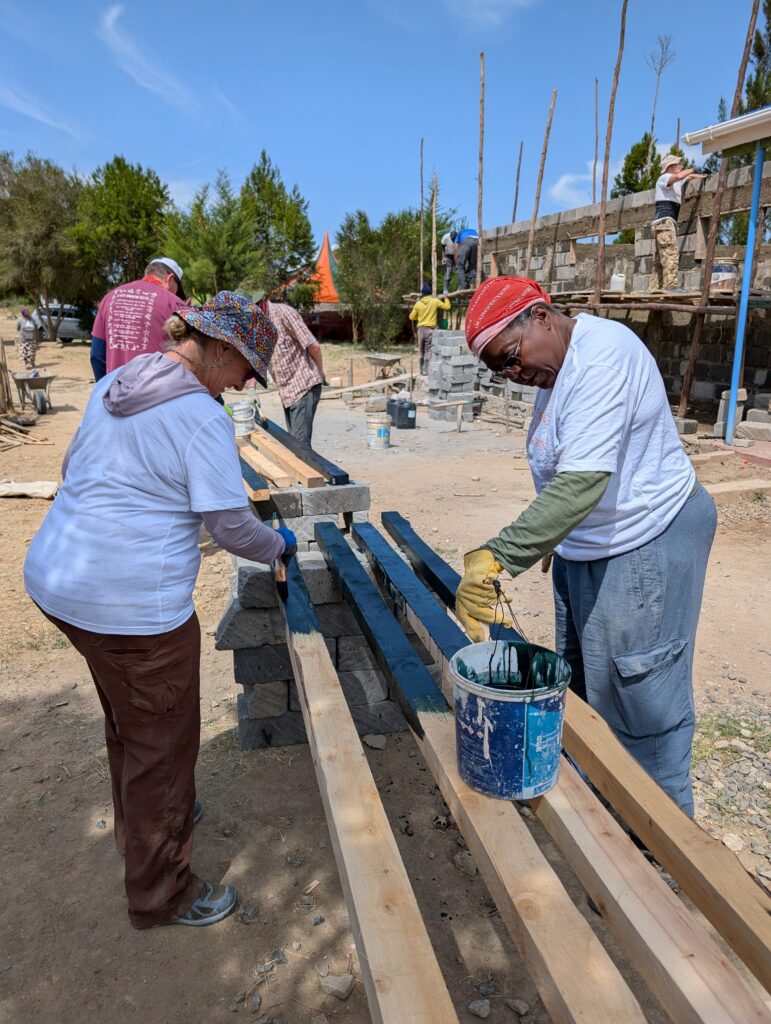
In terms of stone setting, we only had the gable to do on one side of the building. As. We painted almost all of the wood with preserver earlier and would finish within an hour tomorrow morning, we asked that we start on building the trusses with the completed wood first thing tomorrow (while a small crew finished the painting) and then we could finish those in time for a noon departure Friday.
Symon said that he would make that proposal to Joel. If we don’t do the trusses then we would only have an hour of work tomorrow and then we’d be done with our work, going back to Nairobi Friday morning.
I texted Nderitu with our plan and hoped that he would get in touch with Joel and make our plan happen.
On the way back to the hotel, police stopped us a checkpoint. We presumed it was part of the nationwide protests that were making international news. All day, the local workers had been listening to broadcasts of the protests and arguing politics stop the stone walls.
The policeman asked for what seemed like ID numbers of some kind from Isaac. He looked at me in the front passenger seat and ask what was clearly understood by me as “Do you speak Swahili?” I responded with “not a word,” in English. He said something to Isaac in Swahili and let us go. He seemed like a dick.
We arrived back to the hotel at 4:40pm and started the now normal routine of clean-up. Tomorrow would be our last day of available laundry, so we needed to plan accordingly. I’d already decided to wear the same clothes the next two days anyway, then put them in a vacuum bag and not open them until we got home.
Happy hour was attended by all. We discussed our plans for the next 48 hours while exchanging WhatsApp messages with DWC staff and Nderitu (our in-country charity lead who happened to be back at his home in Colorado.
They all approved a plan by which we would begin truss structure assembly on Thursday, finish treating the lumber, and help with the final stone setting in the gable. We would then continue that work on Friday until about a noon departure. Our plan was to check out of the Lusoi Resort Friday morning and then leave directly from the work site for Nairobi, sparing us another 40 minutes of out-and-back driving on the very rough road (trail?) from the highway to the Lusoi. This seemed reasonable as all of our painting and most of the heavy, sweaty work would be done on Thursday. We also wanted to have a chance to see our local team again Friday as many of us had plans to give away boots, shoes, shirts, DWC buffs, and other equipment that we didn’t want to bring home with us.
Andy, the DWC program manager for Kenya told me that the next group coming would arrive on 4 Oct for a two-week project that would finish any of the truss and roof work we didn’t get to and also begin work on finishing the interior and exterior of the classroom. The third and final team would come in early November for one week to complete electrical work, install the laptops, and hand over the slab to the school.
Thursday 26 June 2025
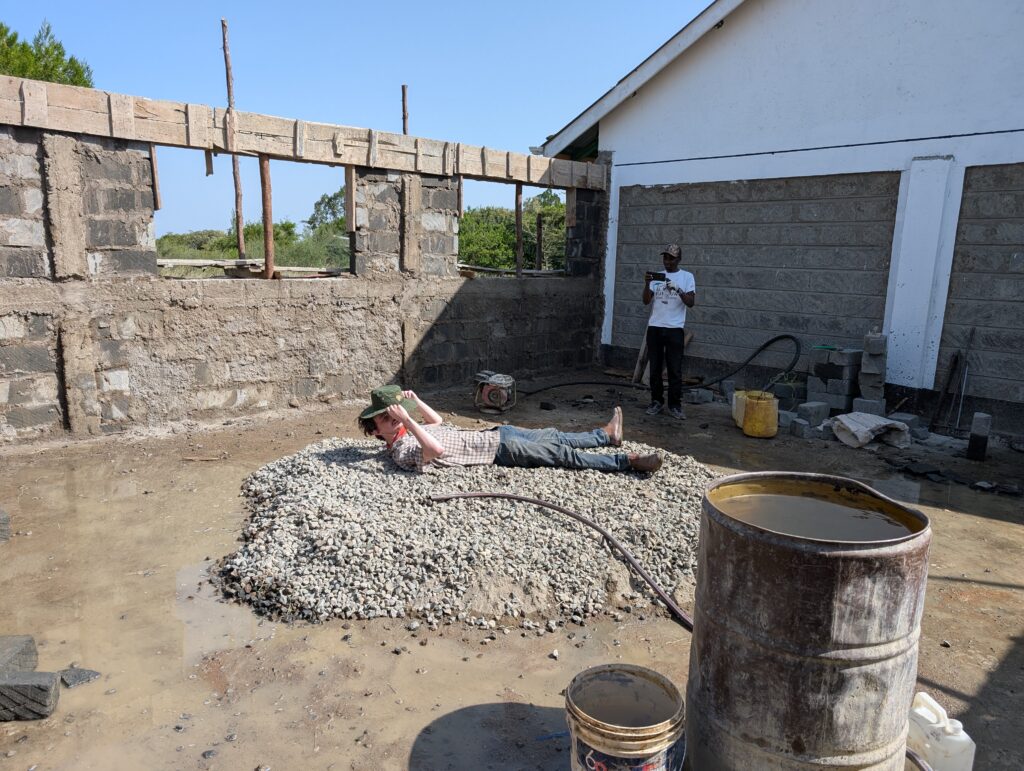
After breakfast, I told the Lusoi front desk about our Friday plans and then prepped to leave for our final full day. Mark suggested that one of us stop by Naro Moru to buy a few hammers to make sure we could build the trusses while the stone setters were using the other hammers resetting scaffolding to build the gables.
We were increasingly worried about the unrest in Nairobi and other cities stemming from both recent events and commemoration of this killed in anti-tax protests exactly a year ago. News sources this morning were reporting that between eight and 16 were killed at protest site around the country, but centered in the big cities. The BBC reported that tear gas and water cannons were used to disperse crowds attempting to storm the presidential residence of William Ruto, Kenya ‘s embattled leader. They were calling for his resignation for a host of reasons. Fortunately (or well planned) for Ruto, he was out of Nairobi yesterday attending a funeral or burial event in the coastal city of Kilifi.
During the protests, the government had attempted to shut down all media coverage of the protests, but that order was swiftly overturned by the Kenyan Supreme Court. We would keep a close eye on the events in Nairobi over the following hours and day.
The weather was typical again this morning with the same low clouds shrouding our view of Mt Kenya. As we approached Naro Moru, though, the summit could be seen through some haze.
We stopped at the “Jesus Is Lord Hardware Store” in Naro Maru and bought three hammers for Ks 1500 ($11.54 USD). One was very nice claw hammer for Ks 750 and other two were cheaper, with hollow pipe handles good for bending or straightening large nails and rebar.
When we arrived, the guys were bringing the wood out of the storage area. We helped with the unpainted pieces and started right to work painting. We were introduced to John, the truss builder, and he began by choosing the pieces that would be the long bottom boards of the truss triangle. We would splice together tick beams to form these six main truss pieces. We did this by cutting complementary “Z” patterns in one end of two boards using hand saws (which was a BIG effort), then matched up the “Z” and wrap about two feet of the spliced section (one foot on either side of the joint) with a steel band that was then nailed into the boards. This formed a very strong bond as the bands were each about four feet long and we used two bands per splice. Each splice also uses at least 40 nails.
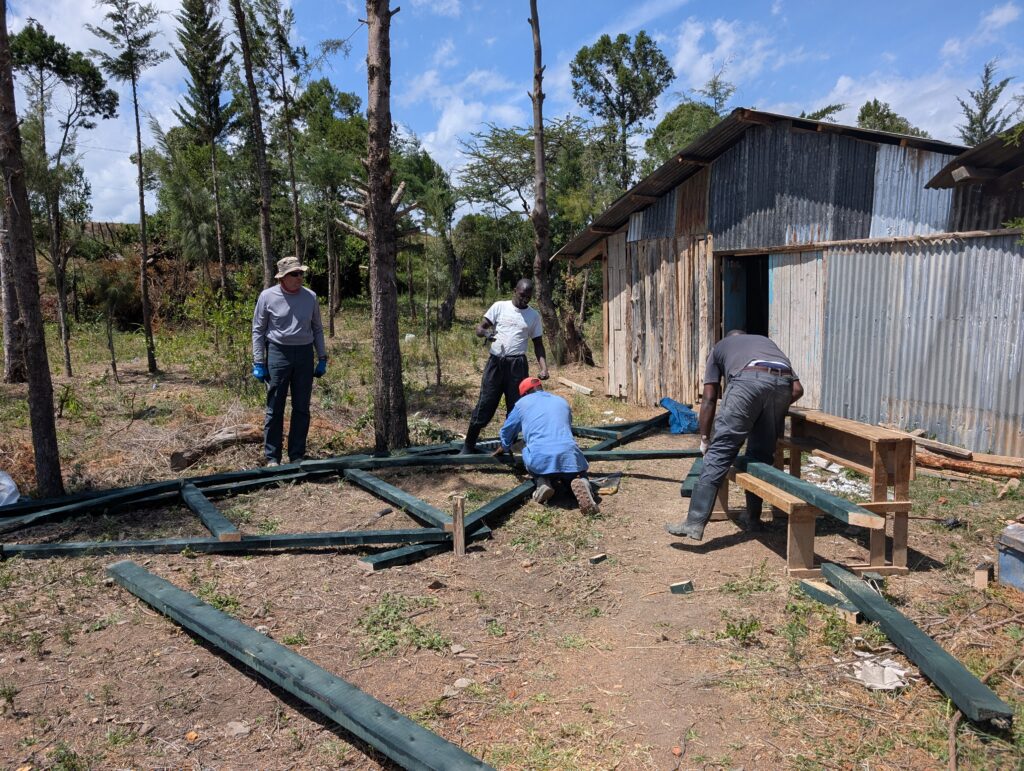
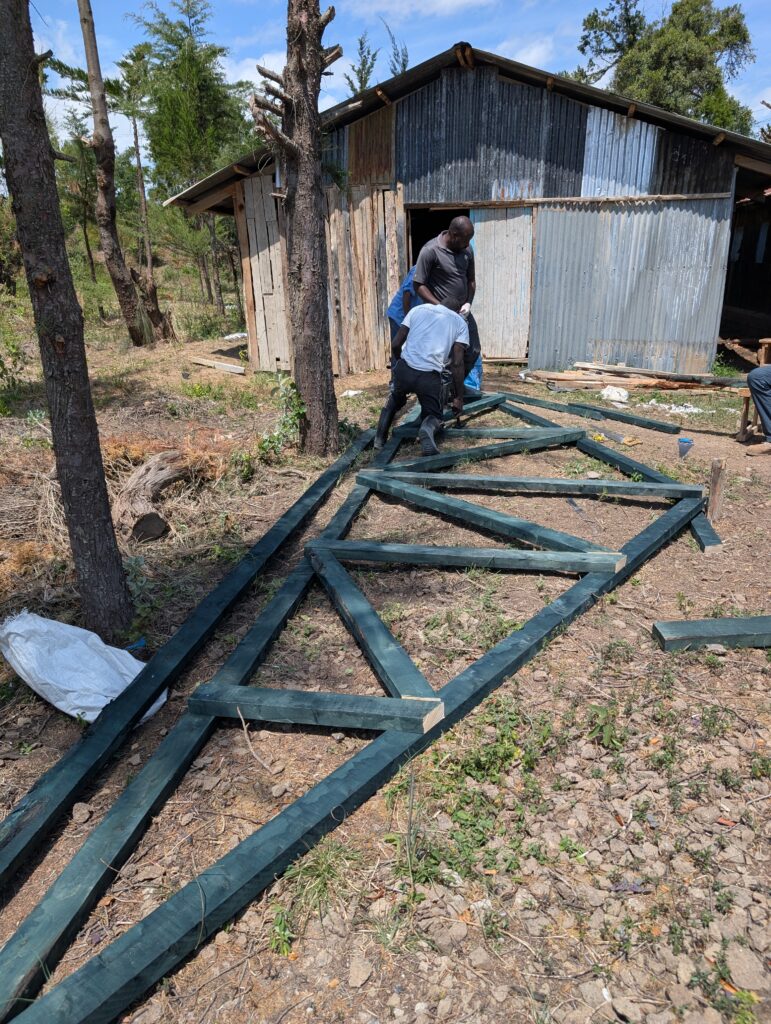
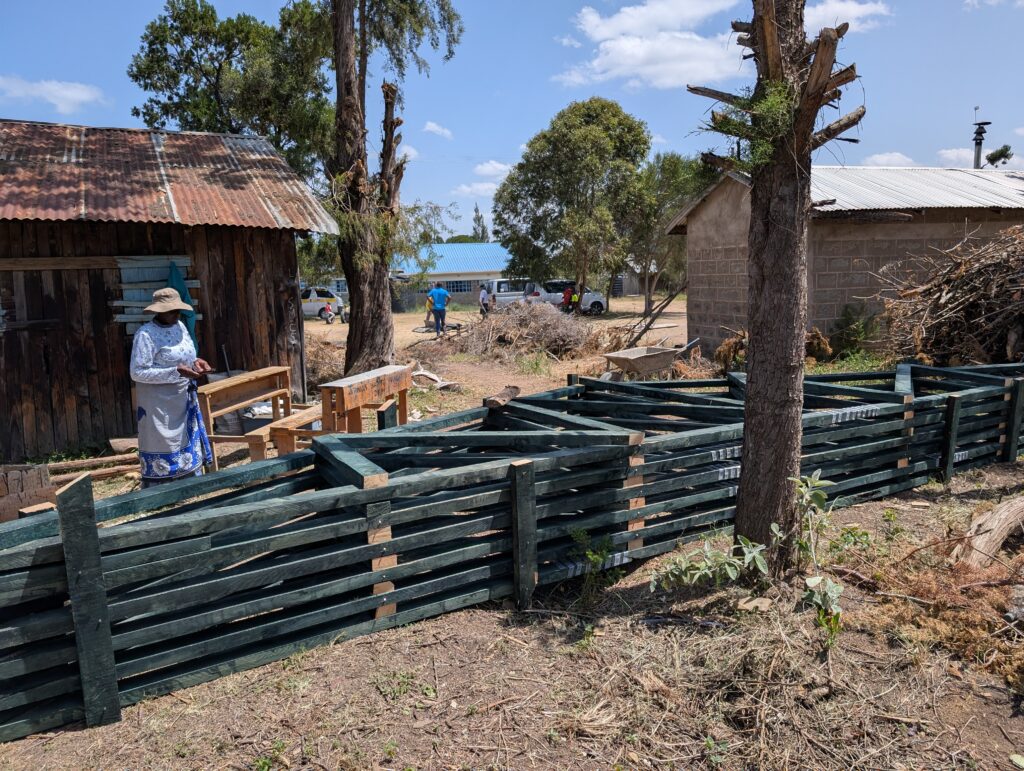
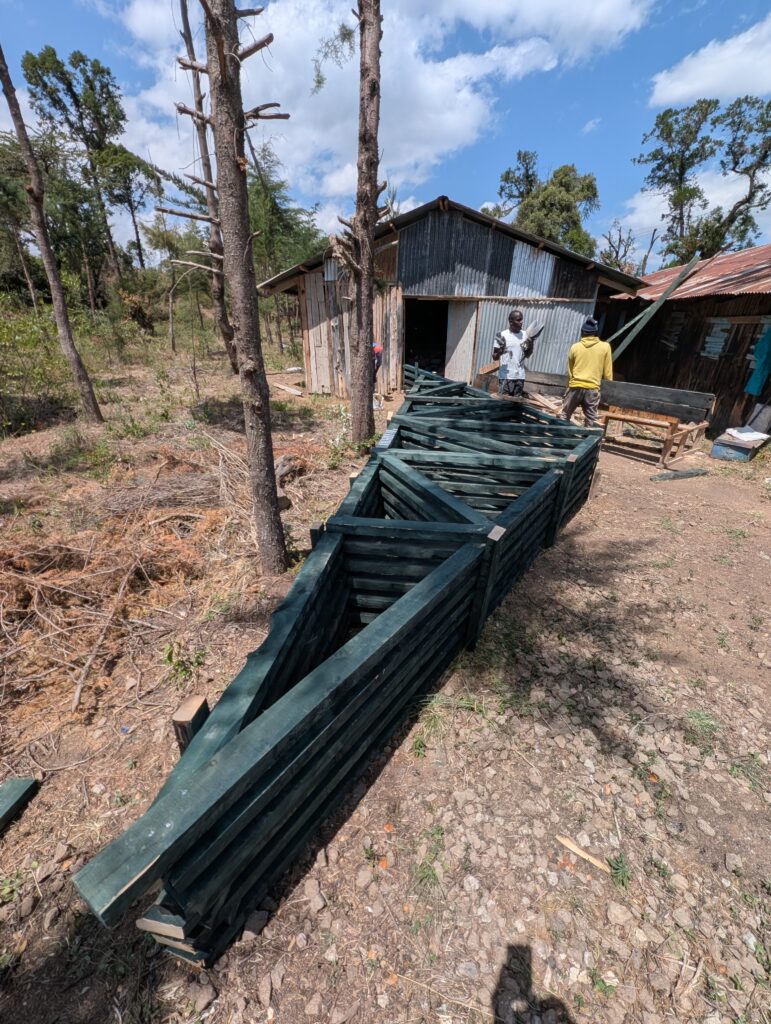
Kate, Yami, and Hollis finished the painting and then went to work pulling nails out of the scaffolding platform boards that doubled as top ring forms.
Becky and I worked on one together and finished quite quickly. John came over and declared ours the base form for the first truss. We started on another while Mark and DT were doing the rest. Isaac and Joseph were helping, too.
John brought the base piece to an area near the storage barn and stakes it to the ground. He then found to other long pieces that form the top two pieces of the truss triangle. He cut this to the correct length and made an angled cut so that would meet cleanly at the apex of the truss. He then nailed the triangle pieces together and further stakes it all in place on the ground.
The other truss pieces followed with DT, Symon, and Joseph helping with the cutting. I stepped in for a short time, but then returned to the platform cleaning. We were now painting them with wood preservative as we had the truss beams.
The platform pieces needed to be brushed and beaten with a hammer to remove what seemed like years of cakes on concrete. Kate was working hard on this as we’re Becky, Isaac, Yami, and Hollis.
By lunchtime, one truss was complete entirely and the second was being assembled directly on top of it. We would do the same until we all six trusses completed, stacked nearly next to the barn.
Meanwhile, back at the classroom, Mark was working his butt off with Abel, Kelvin, and another guy building the gable. For Mark, that meant helping to build scaffolding that would reach high enough, mixing concrete, and then passing 50-pound buckets of concrete up to Abel on the scaffolding (eight dee above him). He also has to pass up blocks. By lunchtime, he was exhausted.
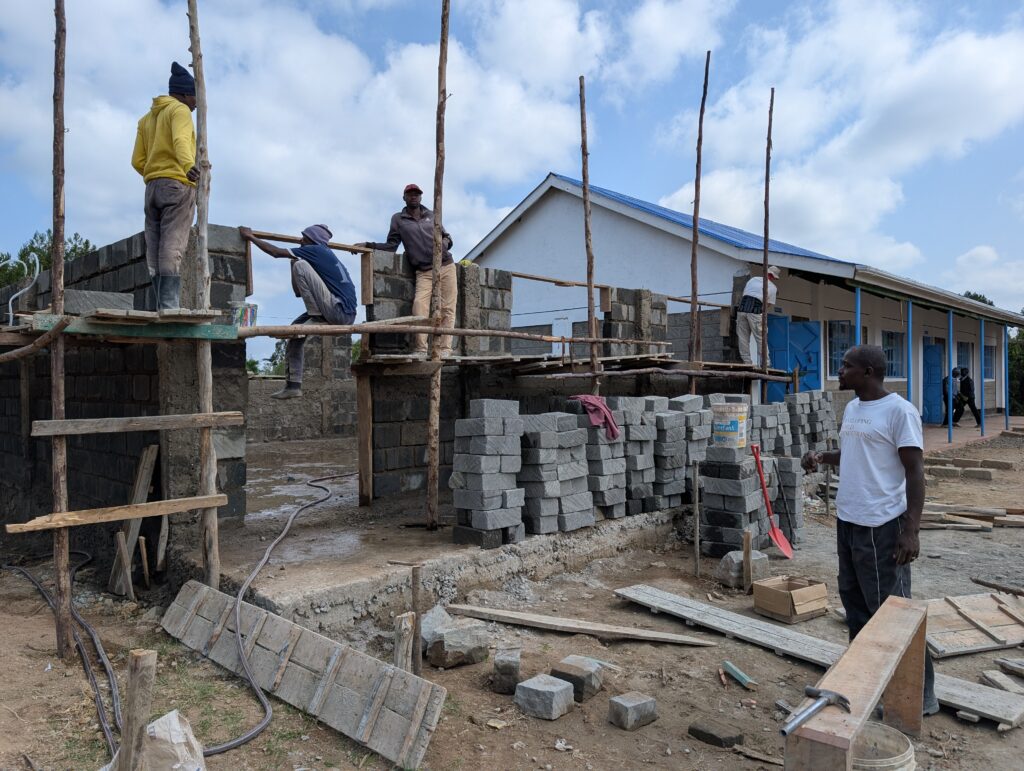
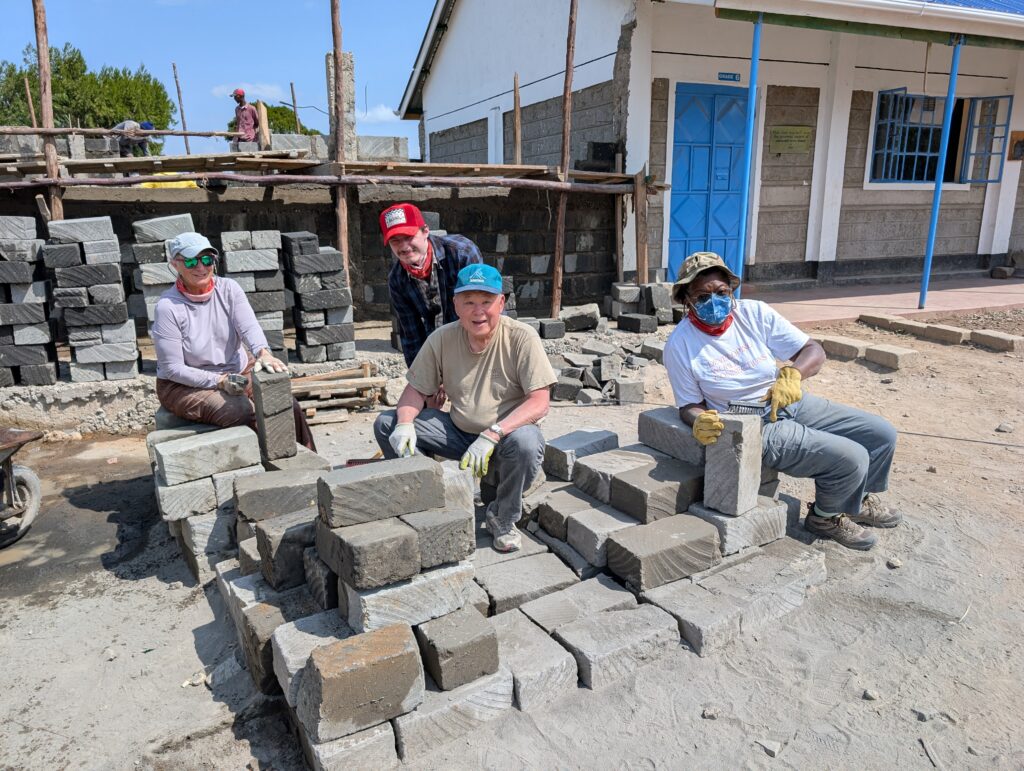

Our final lunch was excellent with little beef steaks, rice, spinach, and some of the best fresh avocado I’ve ever tasted. The team was tired after a busy morning but also content that we were accomplishing so much and had achievable end states that we were confident we could achieve before our departure on Friday.
In the afternoon, I stayed with Mark, Abel, and the others working on the gable, taking over the mixing and lifting duties while Mark went to the top of the scaffolding to fill in gaps between set stones and help with the setting. I lifted stones and mortaring to Abel and mixed concrete (or kept it fresh) while everything progressed.
On the other side, the team was working hard in cleaning and preserving the platforms while DT helped with truss assembly.
By 3:30pm, as we wrapped up the day, the gable stones were set, most of the platforms were complete and three trusses were finished. On our final day, we would only have three trusses to complete and the finishing the platform treatments.
We left at 4pm and were back at the Lusoi by 4:40pm as usual. When we returned to the room, we had a welcome message written in scarlet bougainvillea leaves on our bed (‘WELCOME BACK”). DT sent a photo of a similar treatment in his room and everyone reported the same from there’s.
After showering, Becky and I spent some time ore-packing for the trip on Friday back to Nairobi. We had planned on wearing some cleaner clothes on the final day, but with painting still left to do, we reconsidered.
Happy hour was even livelier than usual as we finished some of the booze, beer, and wine that we’d purchased over the previous two weeks. Daniel, the hotel manager, came over to chat and we thanked him for the great service during our stay.
At dinner, Hollis was a late arriver. The rest of us enjoyed our final Kenyan soup (pumpkin) of the trip and then the fried fish. Mark had a bottle of South African chenin Blanc and DT bought a bottle of claret.
When Hollis arrived and had had some dinner, we went around the table making toast and commenting on the trip which is our tradition. I thanked DT for the idea of having a “warrior of the day” and pledged to use that idea on upcoming trips. Kate was particularly thoughtful in her remarks about visiting Africa and all she had seen and experienced through her unique perspective.
After dinner, we went to the indoor bar where Daniel had prepped a fire in the fireplace. He treated each of us to a glass of red wine and the deep conversations continued. Yami and then Kate bowed out, then Hollis, Mark, DT, Becky, and I watched Faith Kipchegon attempt to be the first female athlete to run a sub-four-minute mile. She didn’t accomplish her goal, but did run the best time ever for a woman at just over 4:06, in a staged “race” against the clock and aided by almost a dozen pacers.
Becky and I returned to our room and straightened up just a few things before going to bed.
Friday 27 June 2025
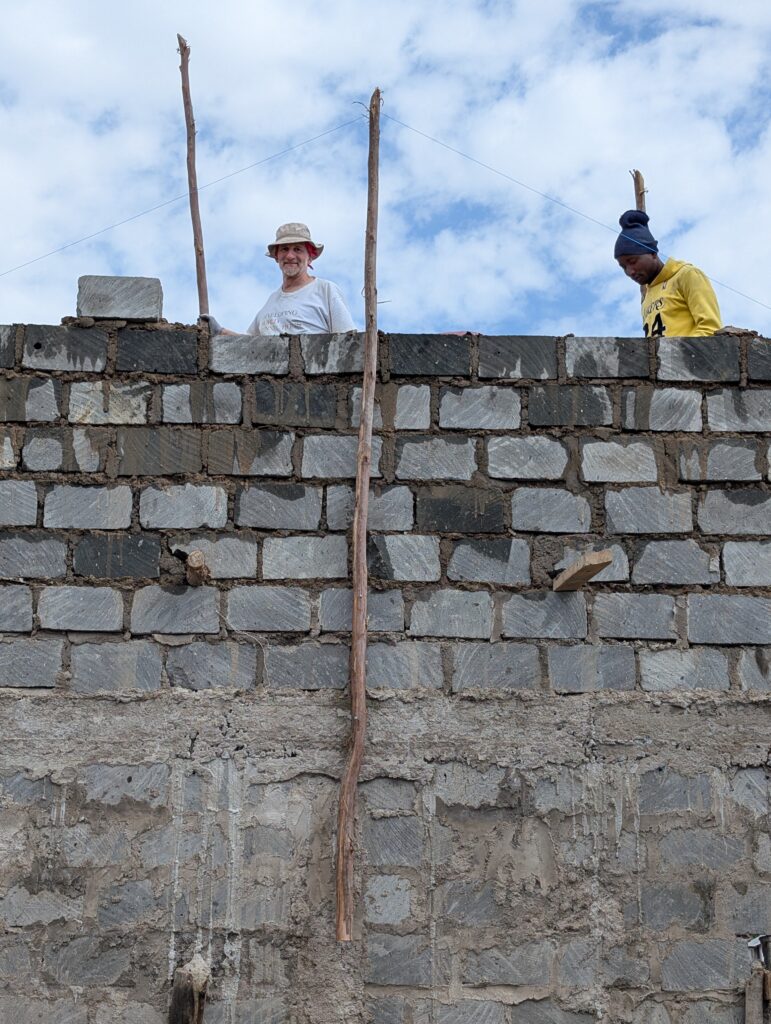
We set our alarm for 6am and finished most of our packing before going to breakfast. We had a bag of items that we would be taking to the worksite to donate to the school and to our fellow local workers. We were leaving some water, a remaining bottle of Scotch given to us by Beef and a gin and tonic can.
After everyone had settled their bills, cleared their rooms, and loaded everything into the vans, we were ready to leave the hotel by 8:10. Daniel bid us goodbye at our gate and we all rejoiced knowing that this would be our last ride on the road between the Lusoi Resort and the highway. The night before we wondered why the Lusoi didn’t spend a little money improving or at least maintaining or smoothing part of the road, but then realized that rough roads really aren’t a big deal to most Kenyans. It’s just a fact of life.
At the worksite, we started quickly and for the final time used water to cure the concrete on the walls. DT went straight to the truss building as did Mark after the curing.
We set up old school desks (as we had the day before) on which we were scraped and cleaned the remaining forms and scaffolding platforms with two sets operating at once. Kate, Yami, and Hollis were at one and Becky and I worked the other. That work continued until the tea break (this morning earlier at about 10am).
By then, the truss team had completed two more sets of rafters and started on the sixth and final one. They also spliced together the top beam that would connect all of the trusses at their highest point.
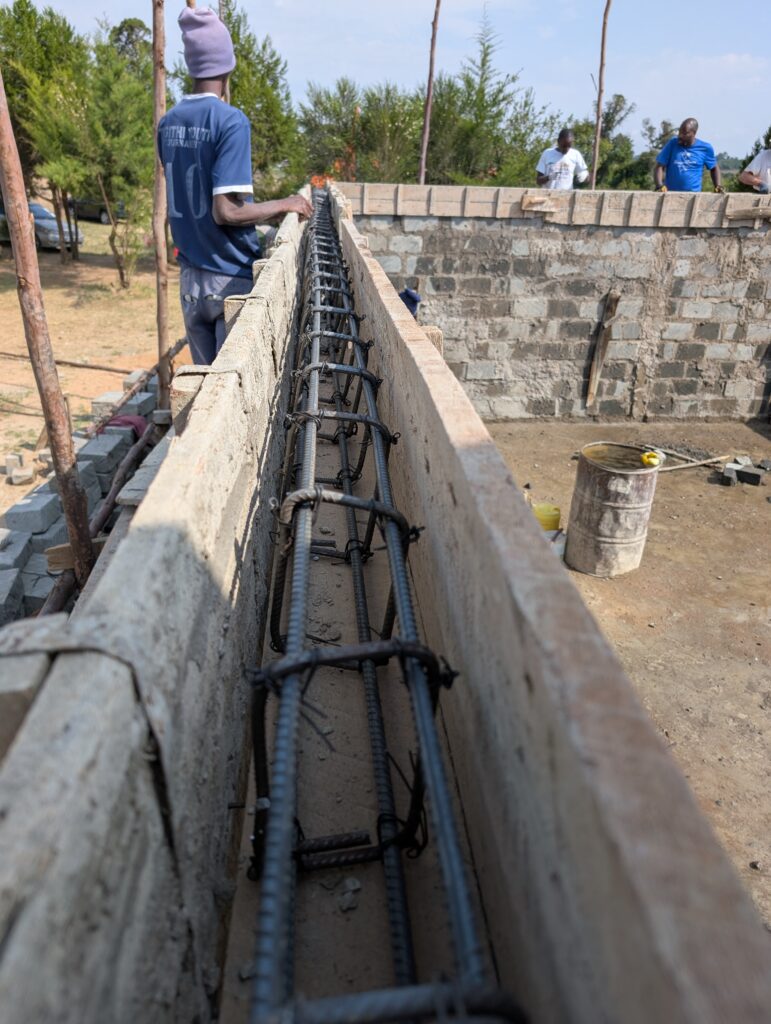
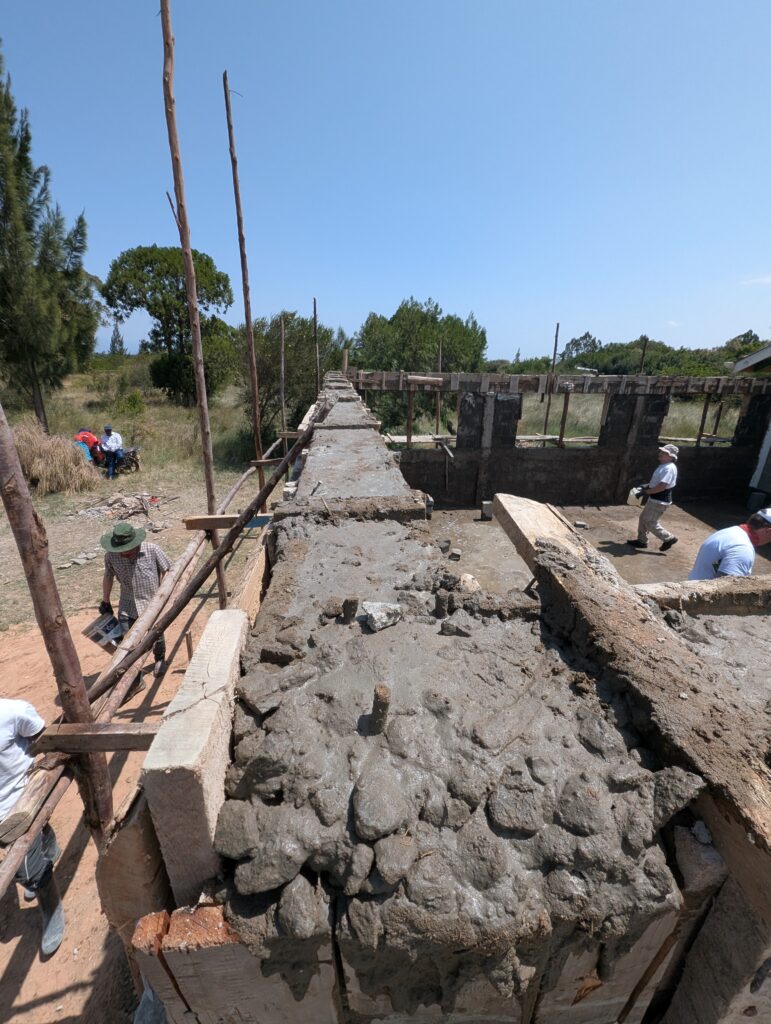
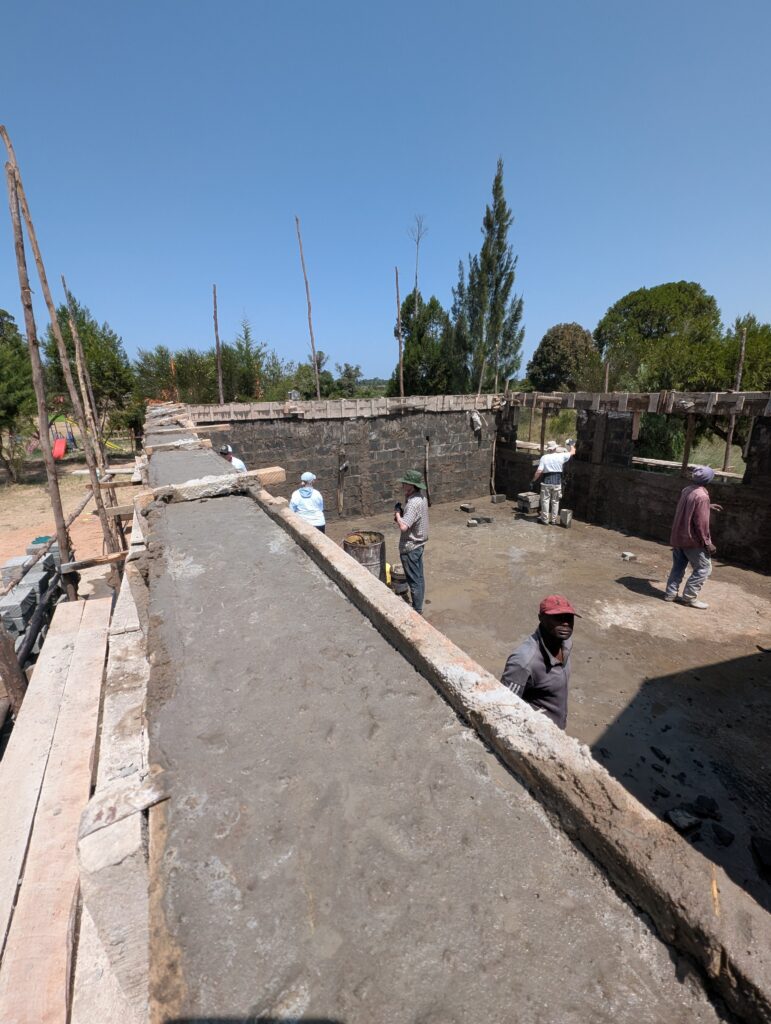
After tea break, we set up tables in the shade where Becky and Yami painted, while we continued cleaning boards in the sun. When the last truss was complete, DT and Mark joined us with Mark painting and DT helped Kate and me clean boards.
As we approached noon, the end was in sight. We were able to complete cleaning all of the forms and platforms, but did get to stain all but about a half dozen. We knew they would all be stored in the barn of horrors for the next group to complete or possibly used at a different construction site in between the DWC trips.
We cleaned the area and put away all of the tools, then gathered under our tent for a final meeting if all involved.
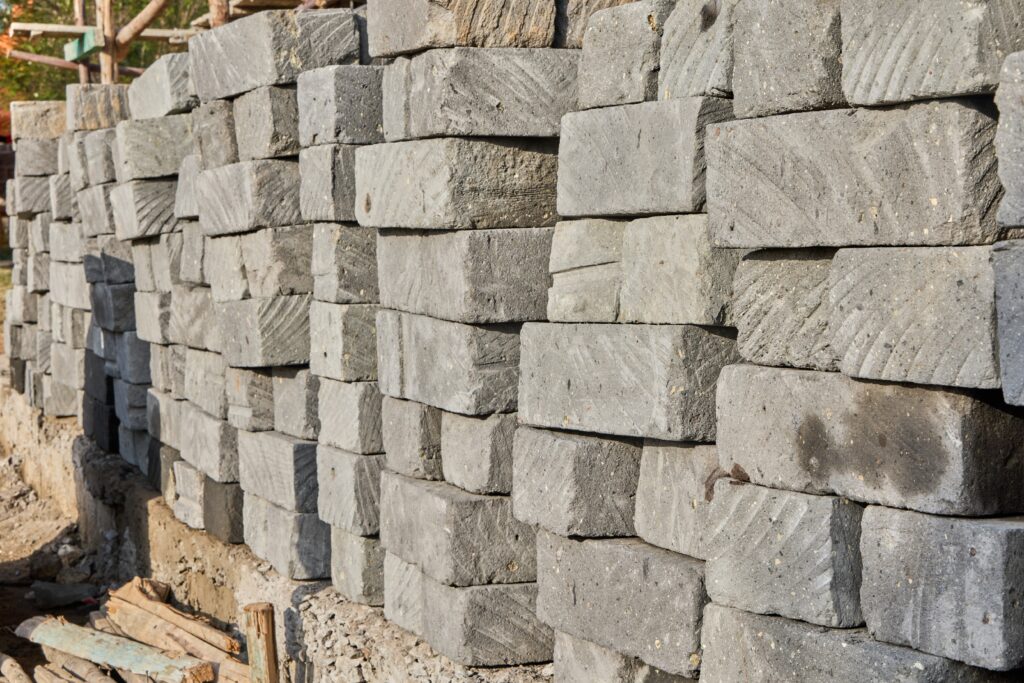
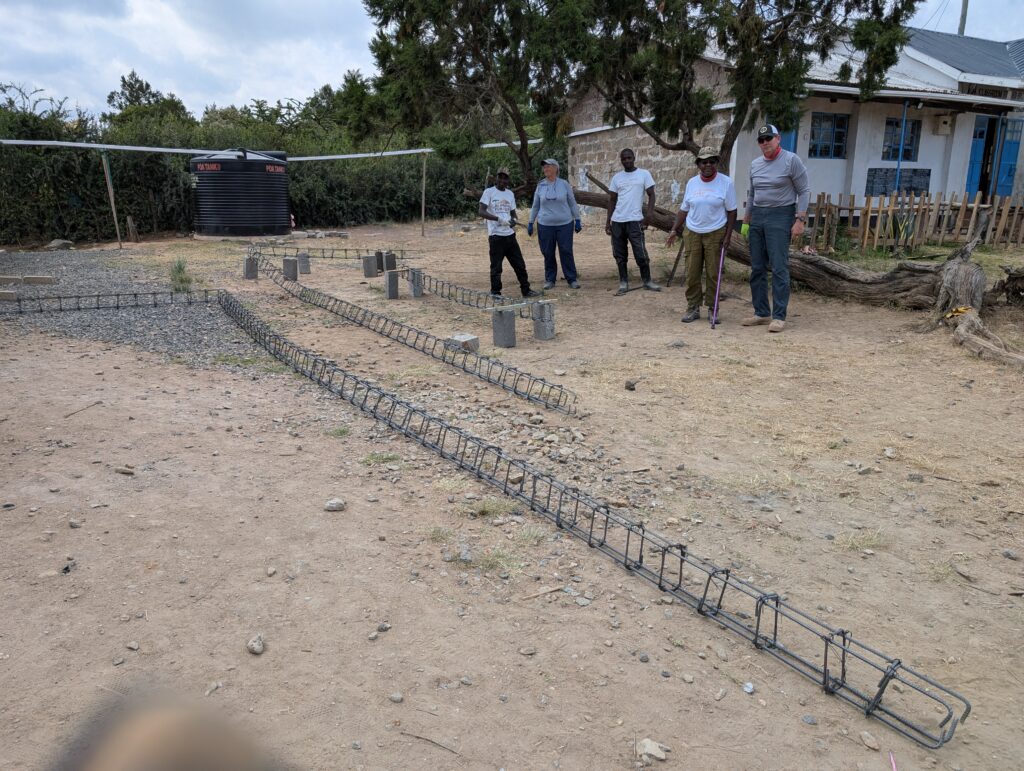
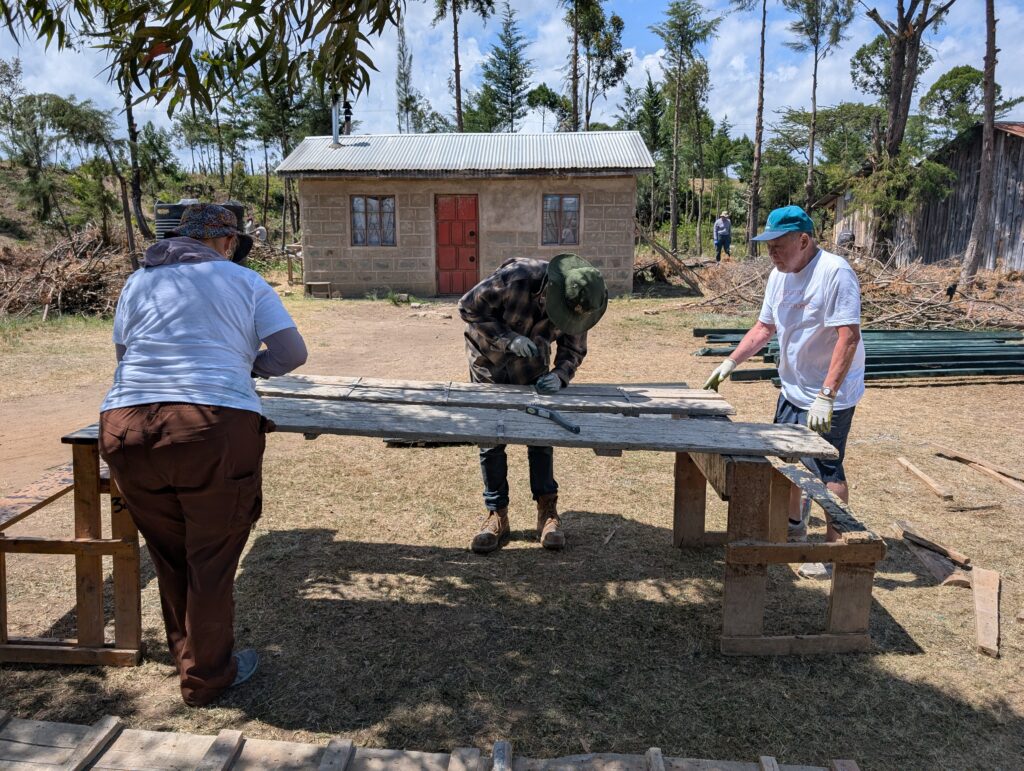
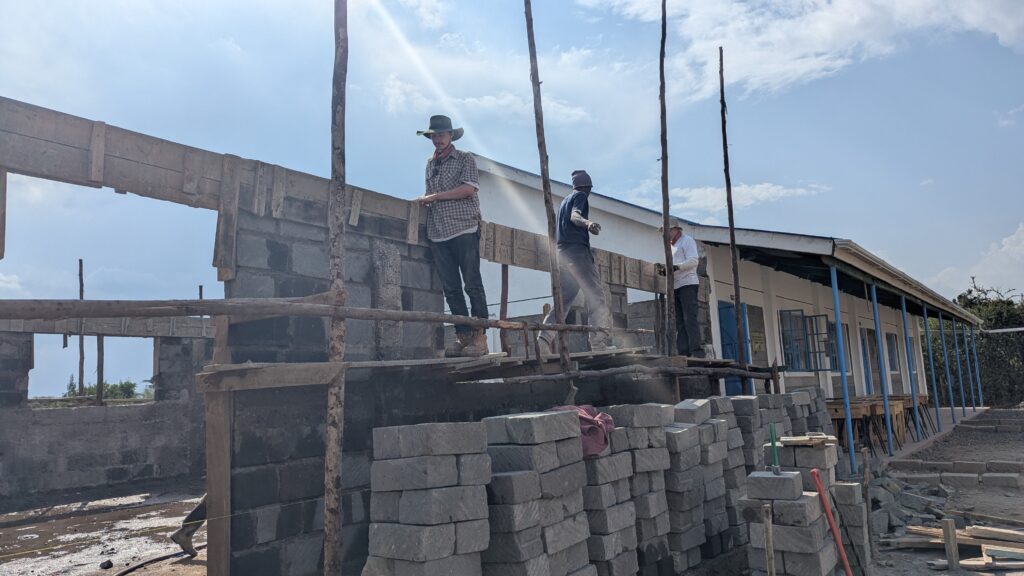
Gladys spoke first, thanking everyone, and then it was Symon’s turn to do the same, followed by Lucy. I ended with a few words of thanks and a pledge to return.
Next, we took photos of different groups in front of the new building and passed out some of the things we were donating. Kat left about a dozen pairs of safety sunglasses, DT gave Symon his desert sand colored uniform boots (size 14), Hollis gave Symon some motocross gloves, and I gave him my shoes (size 8.5). We passed out excess DWC buffs to many. I had three DWC shirts to give away and they went to Kelvin, Abel, and to our young chef who’d done such a good job with lunch every day. I know others left behind items like DT giving Joseph a pair of his pants.
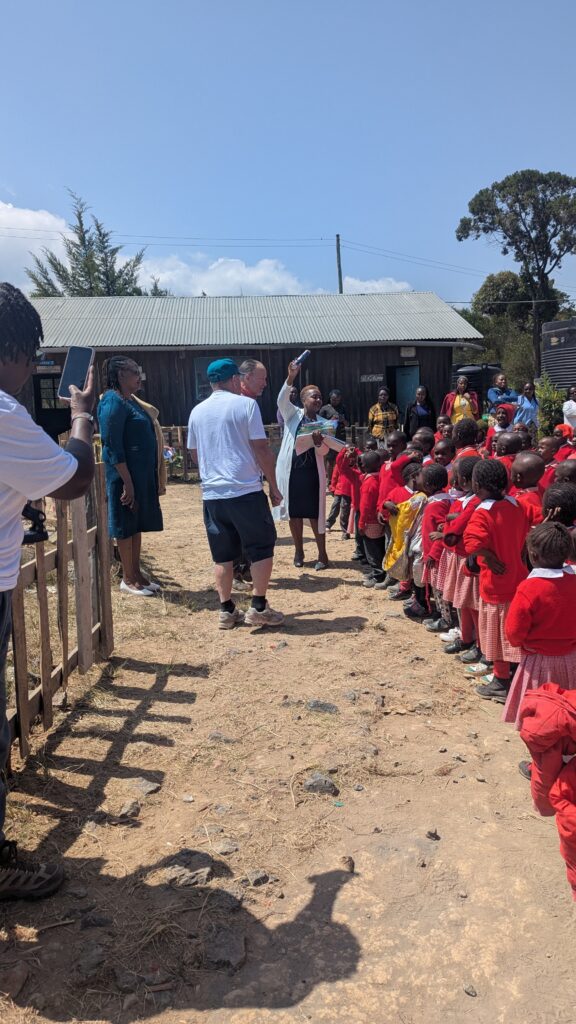
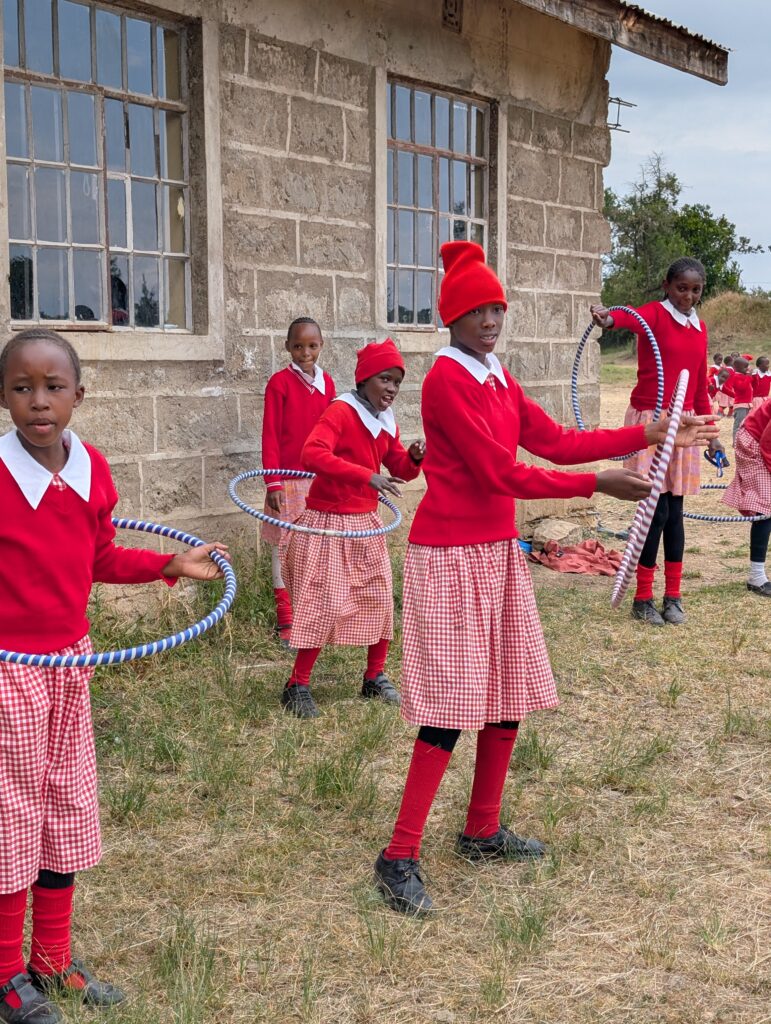
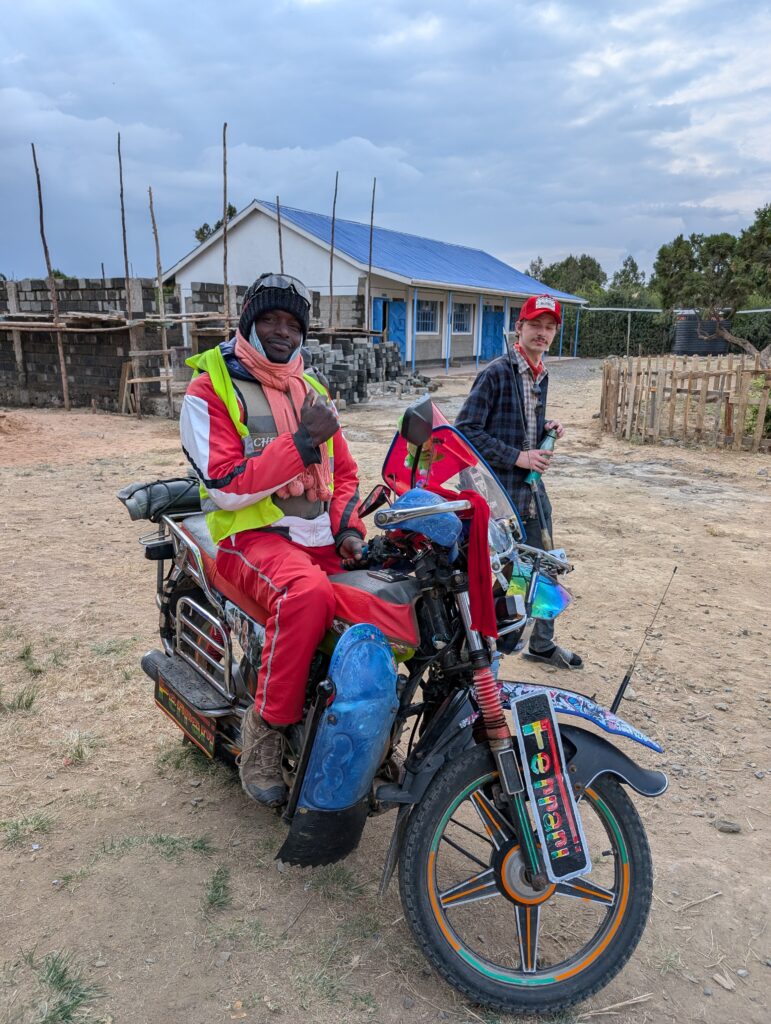
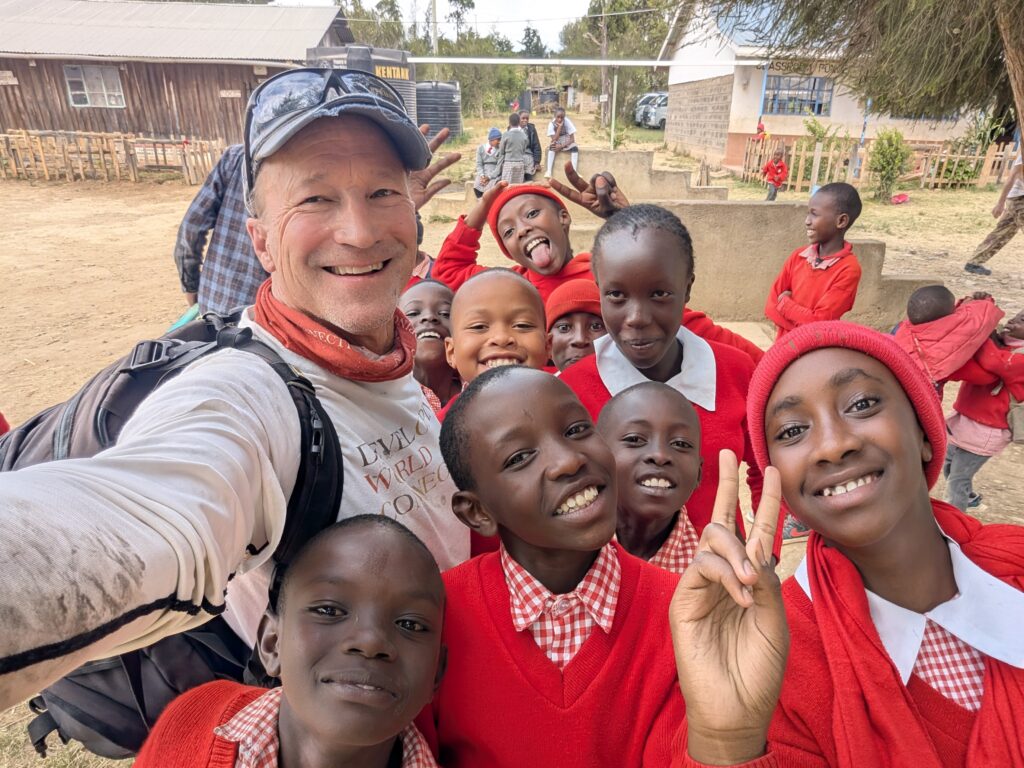
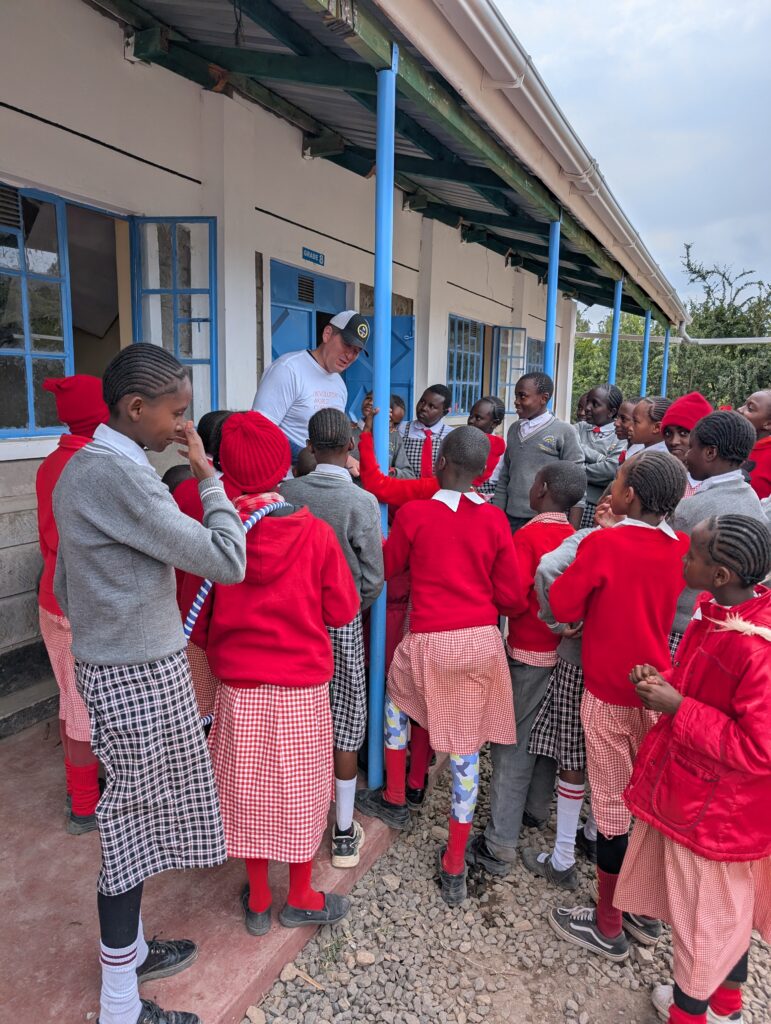
We were happy with all that we had accomplished and really enjoyed the team we worked with and those that supported us throughout the two weeks.
After loading into the vans, we drove about a half kilometer on the highway to the Trout Tree Restaurant. The restaurant itself is built into and around a huge tree and then surrounded by over twenty circular, concrete fish ponds, each filled with rainbow trout at different life stages. Our table was directly above one which must have been the brood stock because every fish looked like it was three pounds or larger–probably 18 inches long.
The treat trout menu has several featured trout items: grilled, sashimi, battered and fried, tandoori, coriander, smoke, and in a pasta. Symon, Joel, Gladys, and Lucy joined us for lunch as did Joseph and Isaac. Most ordered trout, but Kate had the beef skewers. I think everyone enjoyed the meal and a final chance to relax together in a really unique setting.
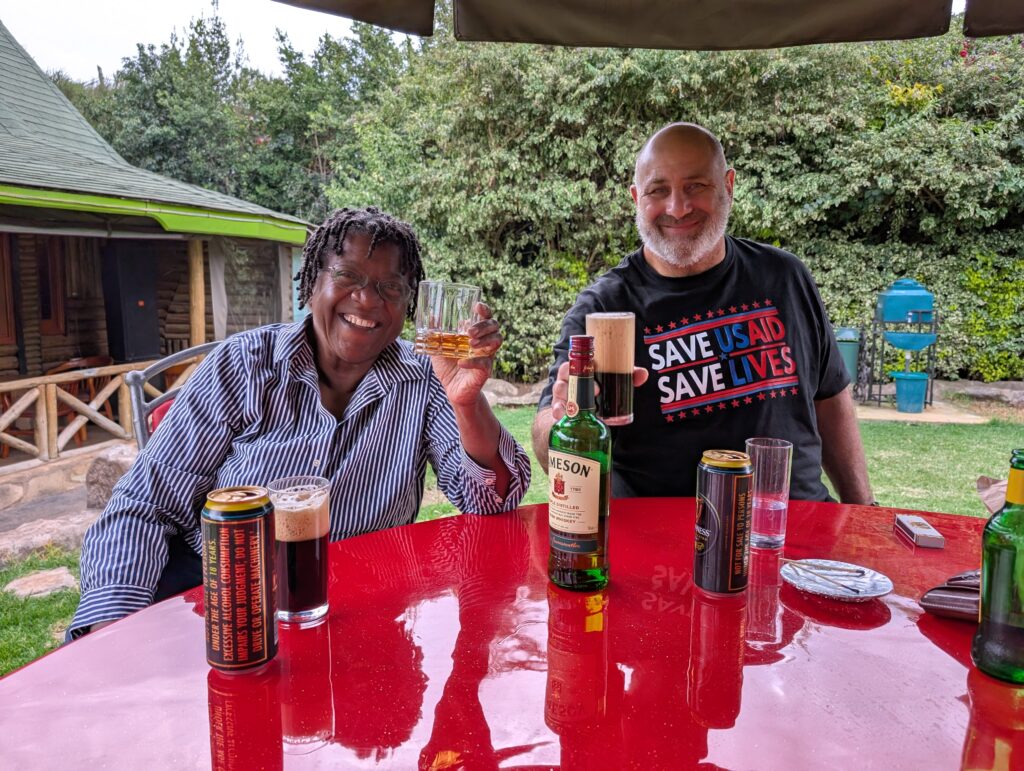
We left for Nairobi shortly after 2pm. Google Maps said that the trip would take almost exactly three hours, but given all of the speed bumps, I think it will take at least 3.5 hours. Along the way, I wrote about some of my impressions of the trip and overall experience.
As I’ve probably mentioned on previous trips to Africa, the Toyota HiAce van is ubiquitous. They’re used for everything. We traveled in one every day that had almost 500,000 kilometers on the odometer.
On the highway, you see them filled with people and painted front and back with two or more city names. These vans operate as low-cost transportation from one city to the next. They start at designated bus stations in major cities and are not operated on a schedule. Instead, the driver waits to collect passengers at the station and, when the van is full or full enough for the driver, he or she will pull away and begin their journey to their labeled city. Scheduled full-size buses are also available, but the majority of the traffic seems to be these cooperatively managed and organized vans called “sacco.”
Isaac told me that these vans charge about Ks 700 (about $5 USD) from Naro Moru to Nairobi (or the reverse), three plus hours away. Baggage might mean an extra charge and prices are adjusted by demand, going as high as Ks 1000 on holidays. Almost everyone you see passing you is packed to the gills with passengers and luggage with some baggage strapped to the roof, too.
People are walking everywhere you look in Kenya. You’ll see people walking on the highway between villages separated by kilometers. We recalled on our previous trip seeing kids who were five or six years old walking up to five kilometers each way to school.
Motor bikes are everywhere, used as taxis (called “boda bodas”), family transport, and agricultural conveyances, and normal everyday rides. We saw one motorcycle carrying three sheep to market. Others carried a family of as many as five. Many had built in shin guards, mud flaps, panniers or side racks, and other attachments to maximize carrying volume.
After motorbikes and walking, you also see many people on bicycles–old, sturdy ones that can survive Kenya roads paved and dirt.
As you drive to or from Nairobi, along the highway there are countless wooden stands selling every imaginable fruit and vegetables, plus charcoal for cooking, rice, and other staples. Some are regional. You will pass through an area where almost everyone is selling mangoes, then another selling pineapple, the potatoes and onions, or tomatoes, watermelon, squash, bananas, etc. Isaac explained that much of the produce being sold are “export seconds” from large plantations not considered high enough quality for export, but sold cheaply on the streets by locals. Other locals buy them as a matter of convenience if they’re driving through since the prices are often half or less than what you’d pay at a grocery store in Nairobi or another large city.
Salespeople will have bags of oranges or lemons ready to be sold at speed bumps. They’ll be on both sides of the road. Agricultural production in this part of Kenya is impressive in many ways. The climate allows three crops of corn and some other products per year. We drove past a huge pineapple plantation that ISaac said was 50,000 acres.
Closer to the city, the road is lined with people selling clothes and shoes in what amounts to a linear walking open market.
Burning trash is an issue in the developing world. Sanitary landfills are rare and for most towns along the highway you will see a trash dump at one end of the town or another with the piles of trash being picked through for recyclables or anything of value by people. Rooks and crows pick through other parts of the trash looking for food and the whole pile is usually smoldering or on fire at one or more points. The smell of burning trash is inescapable anywhere near a community and the smoke creates a haze that discolors the skies nationwide.
The traffic became very dense as we neared downtown Nairobi, but we still made decent time and arrived at the hotel by 5:45pm. We checked in quickly and made plans to depart for our final dinner at 7:15pm. That gave us all time to shower, do a little more repacking, and relax.
Yami opted out of dinner, so we were down to eight. We piled into Isaac’s van to make the trip a little more compact. The traffic was terrible, the streets poorly lit, and it took us almost 25 minutes to cover just a few kilometers to the Fogo de Gaucho Brazilian steak house in a large commercial complex with a 24-hour gym, bars, and other restaurants. There was an AK-47-armed guard at the entrance and finding parking took a few minutes.
Once inside, we were surprised by how big and full the restaurant was. Several hundred people were dining with many whole families and large groups. It was the standard all-you-eat Brazilian place with, like The Carnivore, some local exotic meats like crocodile. The beef was very good, if a bit chewy. We all ordered drinks with Kate having her usual Jameson’s, Mark, DT, and Becky sharing a bottle of South African red, and the rest of us (including Isaac and Joseph) having Tuskers or White Caps.
Becky and I treated the team to their alcoholic drinks and we all talked more about the trip. Isaac asked for our feedback on their support and we had nothing but good things to say. Both of them are excellent drivers, they worked hard alongside us for two weeks, were always on time, and went out of their way to make everything go as smoothly as any DWC trip I’ve done. Several of us pledged to come back in July of 2027 (another two year gap) and do another project so long as they were there. We had earlier talked about doing that but finding a way to schedule a trip to Maasai Mara National Park the next time for some variety and new experiences.
We returned to the hotel just before 10pm and, after goodbyes to Mark (his flight was leaving at 3:30am!), Becky and I said goodbye to Isaac.
Saturday 28 June 2025
We got up at about 7am, showered and finished our packing, trying to optimize our bags for the upcoming three days in Zanzibar and then three more in Brussels, Belgium. We sealed two vacuum bags with things we definitely wouldn’t need–one filled with dirty work clothes.
We met DT, Hollis, and Yami at breakfast. The first two were planning to go to the Nairobi National Museum in the late morning after Joseph had taken Becky and I to the airport. Isaac was taking Yami to the Giraffe rescue and Kate would join the other two at the museum.
We said our final goodbye in the lobby and Joseph drove us to the airport. Along the way, a traffic cop on foot stopped our van and asked Joseph to get out of the van. The entire conversation seemed cordial but a little tense. There didn’t seem to be any checking of licenses or IDs, just conversation. A few minutes later, Joseph got back into the van and we left. Becky and I asked him what had transpired and he said the cop just wanted “breakfast.” The police officer had targeted his van being driven with white people on board, knowing that Joseph couldn’t really afford to be late to wherever he was going. The stop cost him KSh 500 or about $4 US. Joseph said that this happens all of the time and is just part of the corruption that is endemic in Kenya.
Check-in at the airport went smoothly and we arrived at the gate an hour before boarding. Souvenir prices in the airport were crazy high ($25 per pound for Kenyan coffee), so we spent some of our remaining Kenyan shillings on coffee and some tea, keeping about KSh 3000 as part of our pledge to return to Kenya.
Our flight to Zanzibar was on Precision Air, booked through Kenya Air and was aboard an ATR72 dual turboprop. The flight would have a stop at Kilimanjaro International Airport outside of Arusha, Tanzania and then a planned arrival in Zanzibar at 4:30pm. The flight boarded about 45 minutes late and was only about one-third full. The scheduled flight was quite confusing because Precision Air showed it as stopping through Kilimanjaro and having a 3:40 overall flight time. The Kenya Air booking (and the flight as displayed on the FlightAware app) showed it as non-stop with only a 2:30 flight time. FlightAware even showed the plane arriving in Zanzibar before we left Kilimanjaro, though it didn’t show a flight path.
Even the passengers on the plane were confused. One couple asked our flight attendant, “Are we going to Zanzibar after Kilimanjaro?” The flight attendant said, “No.” Technically, she was correct. We changed flight attendant crews in Kilimanjaro. However, the plane did continue to Zanzibar after picking up enough passengers at the stop to fill the plane completely.
We landed about 30 minutes late at Zanzibar International Airport and were immediately surprised (as was almost everyone on board) to discover that, in addition to our mandatory multi-entry visa to Tanzania that cost us $100 per person, we had to pay $44 apiece and enroll in a Tanzanian tourist/travel insurance program to enter. We handled that quickly online but felt shaken down nonetheless.
Our bags were circling the carousel by the time we made it through passport control. A note from our driver asked at what terminal did we arrive. Not seeing any signs in the area, I asked one of the uniformed officers what terminal this was. He said, “Three.” I tested Salum, our driver, that info and then went outside with Becky. Salum texted back a few minutes ago and asked if we were sure it was Terminal 3. I looked back at the entrance to the terminal from the taxi stand and it said, “Terminal 2.”
A few minutes on, we connected with Salum and were driving into Stone Town. He was very friendly and knowledgeable and told us quite a bit about the city. It is 95% Muslim, but very peaceful and everyone gets along. He assured us that the city was safe, but that we should, as always, be careful, especially at night. He recommended some local restaurants and sites to visit as well.
He dropped us outside of the Spice Tree Hotel near the tip of Stone Town and, after walking through a couple of narrow passageways, we found the entrance and checked in. The hotel staff was very friendly and helpful and the room, on the fourth of five floors, was spacious with excellent air conditioning and two sides of windows with good views of the city.
After unpacking and relaxing a little, we went to the ground floor garden area that advertised a buy-two-get-one-free happy hour. We ordered two drinks, but noticed that the menu was the same as the rooftop restaurant. When our drinks didn’t arrive in about ten minutes, we realized that they were probably prepping them on the rooftop and bringing them down, so we just told the server that we would go to the Taarab Restaurant on the top floor and meet our drinks there. We did so, and it still took another ten minutes for our drinks to arrive.
Dinner was excellent on the outer terrace with a good view of the ocean, setting crescent Moon, and city rooftops. Becky started with the “tuna dégustation,” that included sashimi, ceviche, and lightly seared tuna, while I had the octopus salad. For our main course, we shared the catch-of-the-day which happened to be tuna! Becky had a glass of South African rosé and a before dinner cocktail, while I enjoyed two bottles of Kilimanjaro beer.
Posted in Kenya on June 17, 2025



